NEC of America KMP6J1J1 Single-Band PCS GSM Phone User Manual N331i
NEC Corporation of America Single-Band PCS GSM Phone N331i
Users Manual

i
Emergency Services and Safety Precautions
Emergency Services
To make an emergency call in any country
☛Press 1 1 2 .
Ask the operator for the service which you require: Police, Ambulance, Fire Brigade,
Coastguard or Mountain Rescue Services. Give your position and, if possible, remain
stationary to maintain phone contact.
The 112 emergency number service is available on every digital network service. The
number 999 is an alternative emergency number for the UK only, and can only be used
with a valid SIM card.
2Due to the nature of the cellular system, the success of emergency calls cannot be
guaranteed.
General Care
A cellphone contains delicate electronic circuitry, magnets, and battery systems. You
should treat it with care and give particular attention to the following points.
•Do not allow the phone or its accessories to come into contact with liquid or moisture
at any time.
•Do not place anything in the folded phone.
•Do not expose your phone to extreme high or low temperatures.
•Do not expose your phone to naked flame, cigars or cigarettes.
•Do not paint your phone.
•Do not drop or subject your phone to rough treatment.
•Do not place the phone alongside computer disks, credit cards, travel cards and other
magnetic media. The information contained on disks or cards may be affected by the
phone.
•Do not leave the phone or the battery in places where the temperature could exceed
60; e.g. on a car dashboard or on a window sill, behind glass in direct sunlight, etc.
•Do not remove the phone’s battery while the phone is switched on.
•Take care not to allow metal objects, such as coins or key rings, to contact or short-
circuit the battery terminals.
•Do not dispose of battery packs in a fire. Your phone's Li-ion batteries may be safely
disposed of at Li-ion recycling points. For more specific battery and power supply
information, see page 4.
•Do not put your phone's battery in your mouth as battery electrolytes may be toxic if
swallowed.
•Do not attempt to dismantle the phone or any of its accessories.
•This equipment is fitted with an internal battery that can only be replaced by a qualified
service engineer. There is a risk of explosion if the battery is replaced by an incorrect
type. Dispose of the used battery in accordance with the manufacturer's instructions.
•Using any battery pack, AC adapter, Vehicle power adapter (option) or Desktop
charger (option) not specified by the manufacturer for use with this phone creates a
potential safety hazard.
•The earpiece may become warm during normal use and the unit itself may become
warm during charging.
•Use a damp or anti-static cloth to clean the phone. Do NOT use a dry cloth or
electrostatically charged cloth. Do not use chemical or abrasive cleaners as these
could damage the case.
•Remember to recycle: the cardboard packaging supplied with this phone is ideal for
recycling.
•Do not leave the battery pack empty or disconnected for a long time, otherwise some
data may be initialized.
•Your phone contains metal which may cause you an itch, a rash or eczema depending
on your constitution or physical condition.
•Take care not to put your phone in the back pocket of your trousers or skirt and then
sit on it. Also, do not put your phone at the bottom of bag where it may subject to
excessive weight or pressure.
Doing so may damage the LCD and camera lens and cause them malfunction.
•Take care not to hold the Light too close to your or other people’s eyes when the Light
is lit.
Aircraft Safety
•Switch off your phone and remove its battery when inside or near aircraft. The use of
cellphones in aircraft is illegal. It may be dangerous to the operation of the aircraft and
it may disrupt the cellular network. Failure to observe this instruction may lead to
suspension or denial of cellphone service to the offender, or legal action, or both.
•Do not use your phone on the ground without the permission of the ground crew.
Hospital Safety
•Switch off your phone in areas where the use of cellphones is prohibited. Follow the
instructions given by the respective medical facility regarding the use of cellphones on
their premises.
General Safety
•Observe ‘Turn off 2-way radio’ signs, such as those near stores of fuel, chemicals or
explosives.
•Do not allow children to play with the phone, charger or batteries.
•Small parts are included in your phone. Keep them out of reach of small children, for
whom it could be a choking hazard.
•The operation of some medical electronic devices, such as hearing aids and
pacemakers, may be affected if a cellphone is used next to them. Observe any warning
signs and manufacturer's recommendations.
•If you have a weak heart, you should take extra precautions when setting functions
such as the Vibrator and Ringer volume functions for incoming calls.
•If you set the Vibrator setting to anything other than OFF, be careful that the phone is
not near a source of heat (e.g. a heater) and that it does not fall from a desk due to the
vibration.
Road Safety
•You MUST exercise proper control of your vehicle at all times. Give full attention to
driving.
•Observe all the recommendations contained in your local traffic safety documentation.
•Pull off the road and park before making or answering a call if driving conditions so
require.
•You MUST NOT stop on the hard shoulder of a motorway to answer or make a call,
except in an emergency.

ii
•Switch off your phone at a refuelling point, such as a petrol station, even if you are not
refuelling your own car.
•Do not store or carry flammable or explosive materials in the same compartment where
a radio transmitter, such as a cellphone, is placed.
•Electronic vehicle systems, such as anti-lock brakes, speed control and fuel injection
systems are not normally affected by radio transmissions. The manufacturer of such
equipment can advise if it is adequately shielded from radio transmissions. If you
suspect vehicle problems caused by radio transmissions, consult your dealer and do
not switch on your phone until it has been checked by qualified approved installers.
Vehicles Equipped with an Air Bag
An air bag inflates with great force. Do not place objects, including either installed or
portable
wireless equipment, in the area over the air bag or in the air bag deployment area. If in
vehicle wireless equipment is improperly installed and the air bag inflates, serious injury
could result.
Third Party Equipment
The use of third party equipment, cables or accessories, not made or authorized by NEC,
may invalidate the warranty of your cellphone and also adversely affect the phone’s
operation. For example use only the NEC mains cable supplied with the AC charger.
Service
The cellphone, batteries and charger contain no user-serviceable parts. We recommend
that your NEC cellphone is serviced or repaired by an NEC authorized service centre.
Please contact your Service Provider or NEC for advice.
Non-Ionizing Radiations
The radio equipment shall be connected to the antenna via a non-radiating cable (e.g.
coax).
The antenna shall be mounted in a position such that no part of the human body will
normally rest close to any part of the antenna unless there is an intervening metallic
screen, for example, the metallic roof.
Use only an antenna that has been specifically designed for your phone. Use of
unauthorized antennas, modifications or attachments could damage your phone and
may violate the appropriate regulations, causing loss of performance and radio
frequency (RF) energy above the recommended limits.
Efficient Use
For optimum performance with minimum power consumption, note the following:
•Your phone has the internal antenna. Do not cover part of the internal antenna of the
phone with your hands. This affects call quality, may cause the phone to operate at a
higher power level than needed and may shorten talk and standby times.
Radio Frequency Energy
Your phone is a low-power radio transmitter and receiver. When it is turned on, it
intermittently receives and transmits radio frequency (RF) energy (radio waves). The
system that handles the call controls the power level at which the phone transmits.
Exposure to Radio Frequency Energy
Your phone is designed not to exceed the limits for exposure to RF energy set by
national authorities and international health agencies. * These limits are part of
comprehensive guidelines and establish permitted levels of radio wave exposure for the
general population. The guidelines were developed by independent scientific
organizations such as ICNIRP (International Commission on Non-ionizing Radiation
Protection) through periodic and thorough evaluation of scientific studies. The limits
include a substantial safety margin designed to assure the safety of all persons,
regardless of age and health, and to account for any variations in measurements.
*Examples of radio frequency exposure guidelines and standards that your phone is
designed to conform to:
•ICNIRP, “Guidelines for limiting exposure to time-varying electric, magnetic, and
electromagnetic fields (up to 300 G Hz)-International Commission on Non-Ionizing
Radiation Protection (ICNIRP)”.
•Health Physics, vol. 74. pp, 494-522, April 1998.
•99/519/EC Council Recommendation on the limitation of exposure to the general
public to electromagnetic fields 0 Hz-300 GHz, Official Journal of the European
Communities, July 12,1999.
•ANSI/IEEE C95.1-1992. “Safety levels with respect to human exposure to radio
frequency electromagnetic fields, 3kHz to 300 GHz”. The Institute of Electrical and
Electronics Engineers Inc., New York, 1991.
•FCC Report and Order, ET Docket 93-62, FCC 96-326, Federal Communications
Commission (FCC), August 1996.
•Radio communications (Electromagnetic Radiation Human Exposure) Standard 1999,
Australian Communications Authority (ACA), May 1999.
Radio Frequency (RF) Signals
THIS MODEL PHONE MEETS THE GOVERNMENT’S REQUIREMENTS FOR
EXPOSURE TO RADIO WAVES.
Your wireless phone contains a radio transmitter and receiver. Your NEC phone is
designed and manufactured not to exceed the emission limits for exposure to radio
frequency (RF) energy set by the Federal Communications Commission of the U.S.
Government. These limits are part of comprehensive guidelines and establish permitted
levels of RF energy for the general population. The guidelines are based on standards
that were developed by independent scientific organizations through periodic and
thorough evaluation of scientific studies.
The exposure standard for wireless mobile phones employs a unit of measurement
known as the Specific Absorption Rate (SAR). The SAR limit set by the FCC is 1.6W/
kg.* Tests for SAR are conducted using standard operating positions accepted by the
FCC with thephone transmitting at its highest certified power level in all tested frequency
bands. Although the SAR is determined at the highest certified power level, the actual
SAR level of the phone while operating can be well below the maximum value. This is
because the phone is designed to operate at multiple power levels so as to use only the
power required to reach the network. In general, the closer you are to a wireless base
station antenna, the lower the output.
Before a phone model is available for sale to the public, it must be tested and certified
to the FCC that it does not exceed the limit established by the government-adopted
requirement for safe exposure. The tests are performed on position and locations (for
example,at the ear and worn on the body) as required by FCC for each model. The
highest SAR value for this model phone as reported to the FCC when tested for use at
the ear is (TBD) W/kg, and when worn on the body, is (TBD) W/kg. (Body-worn
measurements differ among phone models, depending upon available accessories and

iii
FCC requirements). While there may be differences between the SAR levels of various
phones and at various positions, they all meet the government requirement.
Body-worn Operation
The FCC has granted an Equipment Authorization for this model phone with all reported
SAR levels evaluated as in compliance with the FCC RF exposure guidelines. SAR
information on this model phone is on file with the FCC and can be found under the
Display Grant section at http://www.fcc.gov/oet/fcid after search on FCC ID A98-
KMP6J1J1.
For body worn operation, this phone has been tested and meets the FCC RF exposure
guidelines when used with a NEC accessory designated for this product or when used
with an accessory that contains no metal and that positions the handset a minimum of
1.5 cm from the body.
*In the United States, the SAR limit for wireless mobile phones used by the public is 1.6
watts/kg (W/kg) averaged over one gram of tissue. SAR values may vary depending
upon national reporting requirements and the network band.
Licenses
•T9® Text Input and the T9 logo are registered trademarks of Tegic Communication.
“T9 Text Input is licensed under one or more of the following:
U.S. Pat. Nos. 5,818,437, 5,953,541, 5,187,480, 5,945,928, 6,011,554, and
6,307,548; Australian Pat. No. 727539; Canadian Pat. No. 1,331,057; United Kingdom
Pat. No. 2238414B; Hong Kong Standard Pat. No. HK0940329; Republic of Singapore
Pat. No. 51383; Euro. Pat. No. 0 842 463 (96927260.8) DE/DK, FI, FR, IT, NL, PT. ES,
SE, GB; Republic of Korea Pat. Nos. KR201211B1 and KR226206B1; and additional
patents are pending worldwide”
•This product contains ACCESS CO., LTD’s Compact NetFront™ Plus internet browser
software.
Copyright© 1998-2003 ACCESS CO., LTD.
Compact NetFront™ is a registered trademark or trademark of ACCESS CO., LTD in
Japan and selected countries worldwide.
•The James Bond Theme by Monty Norman
©EMI Unart Catalog Inc. (BMI)
All Right Reserved. International Copyright Secured. Used by permission.
•©2002 Music Airport Inc., http://www.music-airport.com/
•i-mode and i-mode logos are trademarks or registered trademarks of NTT DoCoMo.
For the purpose of improvement, the specifications for this product and its
accessories are subject to complete or partial change without prior notice.
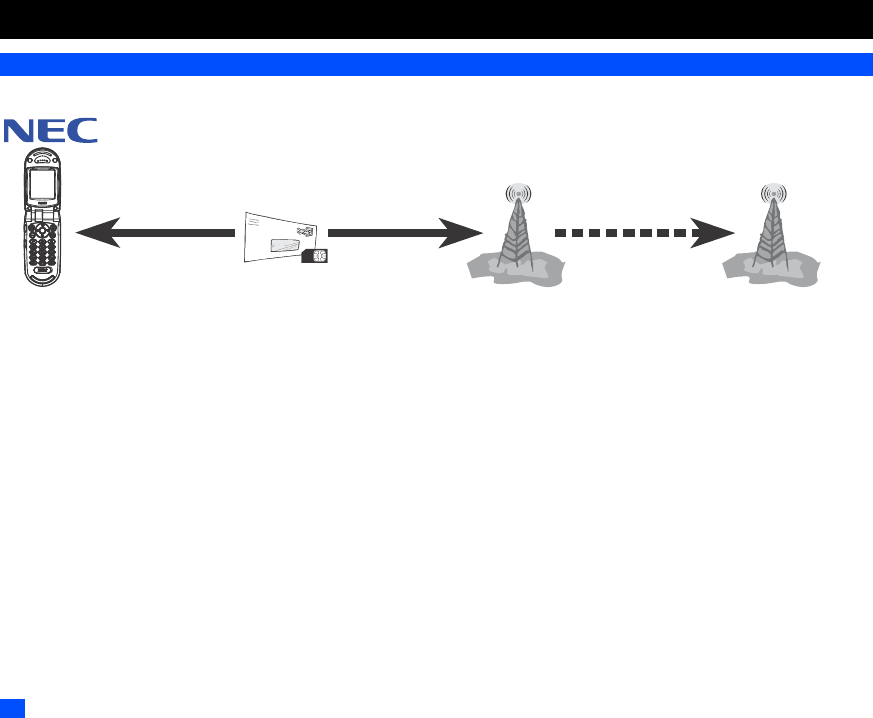
iv
Before You Start
Cellphone system structure
It is worth remembering that every time you use your phone, three or four different organizations are involved:
All the features described in this user manual are supported by your phone. However, for all these features to work, you must have a SIM card (supplied
by your Service Provider) that also supports these features. Even if you have a fully featured SIM card, any feature not supported by the Network
transmitting your call will not work. This last point is especially important when you are roaming networks (see page 13).
User guide conventions
The instructions in this user guide make use of the shortcuts selection except special cases.
The following markers are used throughout the user manual to attract your attention:
/This type of paragraph will contain details of where to find information related to the topic in question.
2This type of paragraph will contain information worth noting.
,This type of paragraph will contain important information.
The people that supply
your SIM card and bills
Service
Provider
The people that
transmit your calls
Network
The people that
provide your Internet services
i-mode Service Provide
r
The people that
make your phone
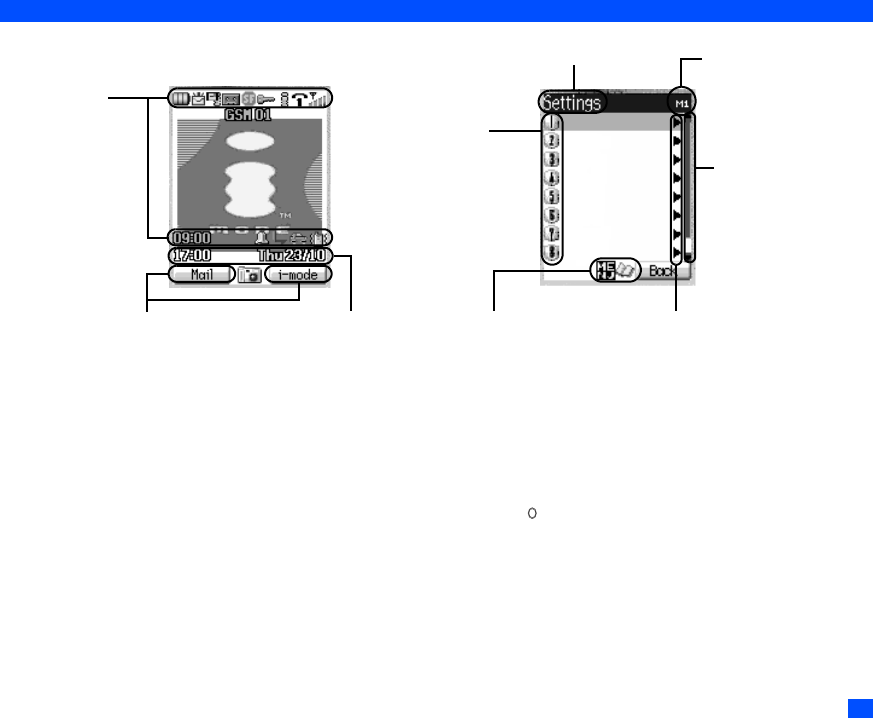
v
Display information
Check box/ Radio button
A check box enables/ disables an option out of a set of options, and multiple check boxes can be selected at the same time. On the other hand, selecting
a radio button automatically cancels the previous selection, so only one radio button can be selected at one time.
A check box/ radio button option can be selected/ cancelled by highlighting it and pressing .
Status icon area
This area contains icons
which indicate the battery
strength, new SMS/mail/
MMS message(s), signal
strength etc.
(see page viii).
Help area
This area contains help
information as appropriate
(e.g. key presses remaining
when composing a message).
Softkey area
This area contains context sensitive
descriptions of the Softkeys’
functions as appropriate.
Shortcut number
Press the appropriate
number to jump straight to a
next menu.
A button colour is changed
when selected (e.g. for
enable/disable settings).
Help icon
Displayed when you can use the
key represented by this icon
(see page viii).
Next menu icon
Displayed when you can press the key
or the shortcut number to show the next
menu.
▼
Page scroll bar
Displayed when you can press
the ▼ key to scroll to the next
page.
Shortcut menu number
The current menu number is
displayed.
Menu title
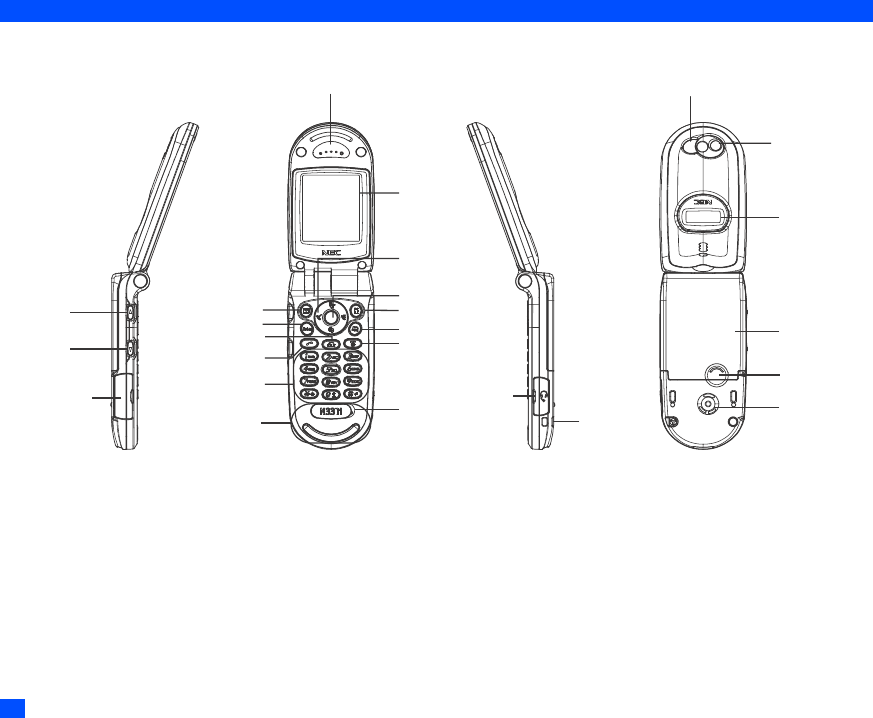
vi
Parts and functions
Earpiece Light
Main-LCD
Battery lock
Speaker
Earphone
jack cover
Softkey 2
Softkey 1
Select key
4 way
navigation key
Menu key
Clear (CLR)/Back key
Send key
Phone book key
End/On-Off key
Internal antenna
Charger connection
cover
Alphanumeric keys
Mouthpiece
Through-hole
for strap
Battery
Side down key
Side up key
2nd-LCD/
Backlight illumination
Camera
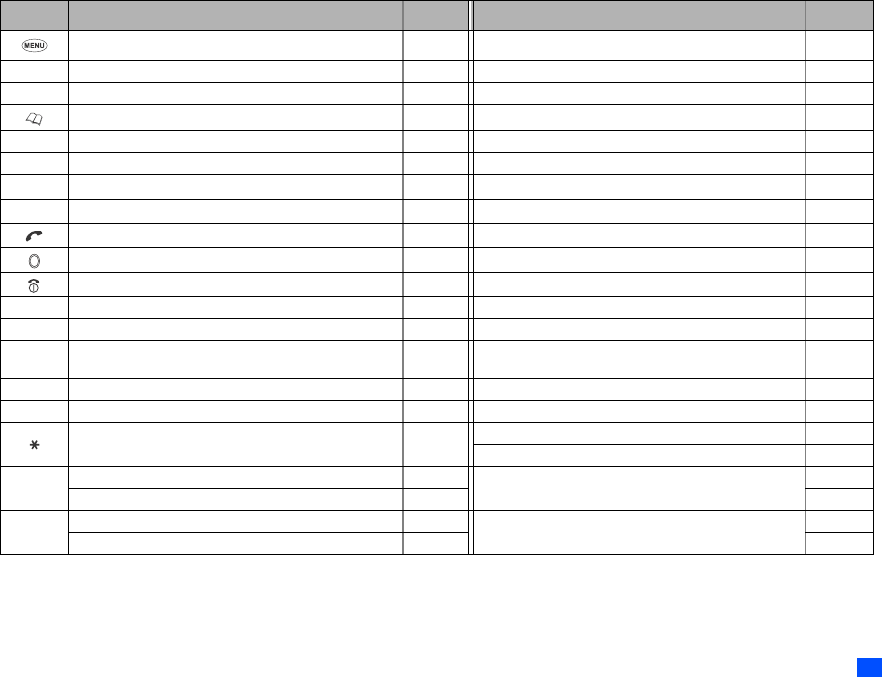
vii
Keypad shortcuts
The following operations are available from the standby screen.
Key Operation that involves pressing a key See page Operation that involves pressing and holding a key See page
Accessing the Main menu screen 14 Setting the Side key lock to On/Off –
Softkey 1 Accessing the Mail screen 55 Accessing the Mail Inbox screen 59
Softkey 2 Accessing the i-mode menu screen 52 Accessing the Operator menu screen –
Accessing the Phonebook list screen 24 – –
▲Accessing the Phone modes screen 15 Setting the phone to Meeting mode 15
▼Accessing the My data screen 76 Accessing the Voice recall 8
Accessing the Received calls list 9 – –
Accessing the Missed calls list 9 – –
Accessing the Dialled calls list 9 – –
Accessing the Camera finder screen 46 – –
Ending a call or cancelling various operations – Powering off 3
CLR Deleting character or returning to the previous screen – Deleting all characters when you enter text –
1Entering phone numbers 6 Calling the Voice mail centre 30
2 to 9Entering phone numbers 6 Going to the corresponding phone number in the phone-
book(SIM) (One-touch dial) –
0Entering phone numbers 6 Entering + when you make an international call 12
#– – Entering a pause –
––
Toggling the selected line 19
Muting or retrieving the sound during a call 9
Side up Adjusting the volume when your phone is open 15 ––
Activating Ring silencer function when you receive a call 18 –
Side down Adjusting the volume when your phone is open 15 Turning on the Light –
Activating Ring silencer function when you receive a call 18 –
▼
▼
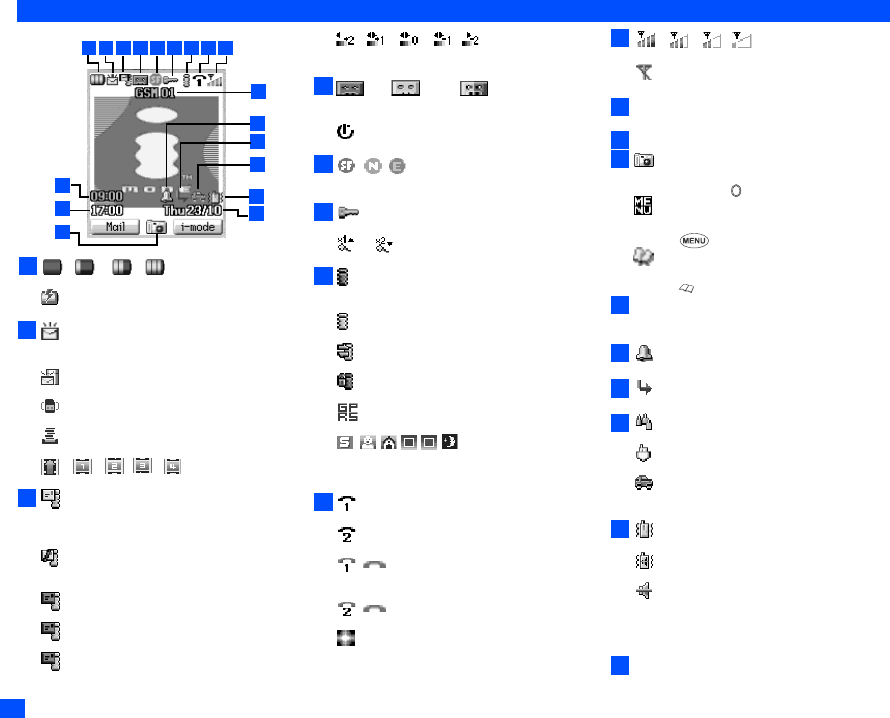
viii
LCD and displayed icons
Indicates the battery level.
Appears during charging.
Indicates that there is a new message(s) in your
phone.
Indicates that there is a new message(s) on server.
Indicates that the SIM memory is full.
Indicates that the Inbox in your phone is full.
Indicates the Burst mode in the Camera mode.
(beige)
Indicates that there is a new i-mode message(s) in
your phone. When a mail(s) or MMS is being
downloaded, the beige icon blinks.
Indicates that the phone memory for i-mode
message is full.
(green)
Indicates that there is a mail(s) on server.
(blue)
Indicates that there is a new MMS on server.
(pink)
Indicates that there are both mail(s) and MMS on server.
Indicates the Brightness setting level in the Camera
mode. The “+2” setting is for brighter.
(red) (green) (green/red)
Indicates that new Voice mail messages are on the
network (No ALS/ALS Line 1, ALS Line 2, ASL Line 1 & 2).
Indicates Self timer in the Camera mode.
Indicates the Image quality (Super fine, Normal or
Economy).
Indicates secured communication on SSL.
Indicates the Zoom level in the Camera mode.
(gray)
Indicates that the GSM network is active and GPRS
is attached.
(yellow)
Indicates that the GPRS is attached and i-mode is active.
Indicates that i-mode communication is being carried out.
Indicates that i-mode lock is On.
Indicates that PDP Context is activated.
Indicates the photography environment in the
Camera mode (Standard, Person, Room, Sepia,
Monochrome or Darkness).
Indicates the Line status (ALS Line 1/No ALS).
Indicates the Line status (ALS Line 2).
( displayed in red)
Indicates the Line status (ALS Line 1 Unencrypted/
No ALS).
( displayed in red)
Indicates the Line status (ALS Line 2 Unencrypted).
Indicates that Light is set to On in the Camera mode.
Indicates the signal strength level.
Appears when you are outside the service area.
Remote time or a day of the week when the screen
displays Local time only.
Local time.
Indicates that you can move to the Camera finder
screen by pressing .
Indicates that you can use the options menu by
pressing .
Indicates that you can use the Phonebook list by
pressing .
“Network Name”
The colour of “Network Name” changes to “Orange”
when you are provided “Roaming Service”.
Appears when the alarm is set.
Indicates that Call diversion is set.
Indicates that Meeting mode is set to On.
Indicates that Pocket mode is set to On.
Indicates that Car mode is set to On.
When there is no icon, Normal mode is set to On.
Indicates that the Vibrator is set to On.
Indicates that the Vibrator and the Silent are set.
Indicates that the Vibrator is Off and the Silent is set.
2The Silent is the status that all the volume
settings (Ringer tone, Msg tone, and Clock
alarm tone) are set to the lowest.
Date
123456789
12
10
11
13
14
15
16
17
18
1
2
3
4
5
6
7
8
9
10
11
12
13
14
15
16
17
18
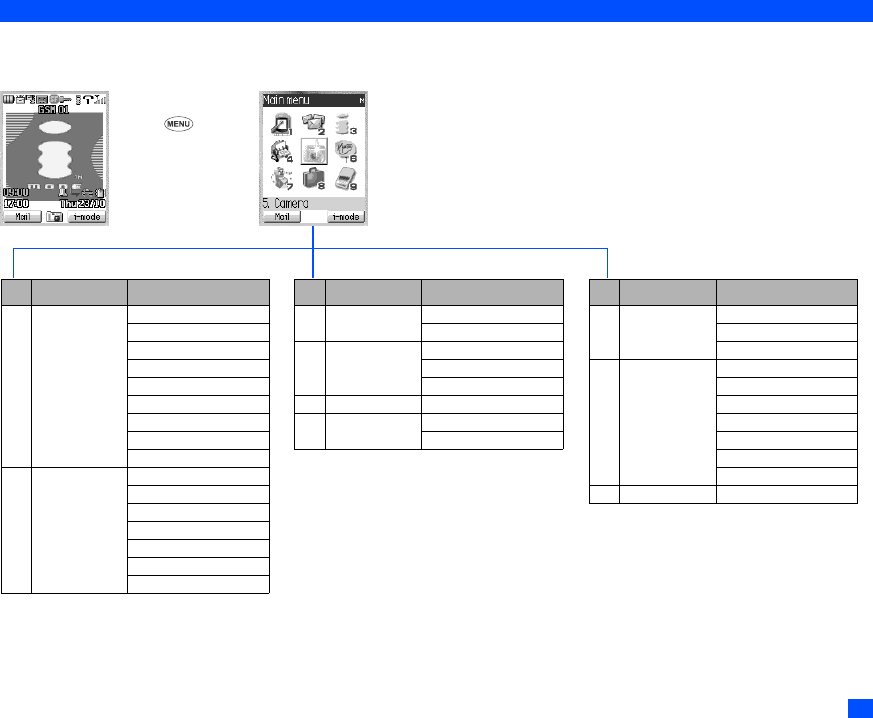
ix
Overview of menu function
Key Main menu Second level menu
3 i-mode i-mode
Settings
4 Phonebook Lists
Information #
Call options
5 Camera
6 My data Pictures
Sounds
Key Main menu Second level menu
1 Settings Phone
Phone modes
Main-LCD
2nd-LCD
Power saving
Calls
Security
Network
Reset settings
2 Message Inbox
Drafts
Outbox
Sent
Folder1
Folder2
CB
Key Main menu Second level menu
7 Game Poker
Belt
Clover
8 Accessory Calculator
Clock alarm
Scheduler
ToDo list
Notepad
Voice memo
Currency
9 SIM Toolkit
➡➡
➡➡
Standby screen Main menu screen
CLR
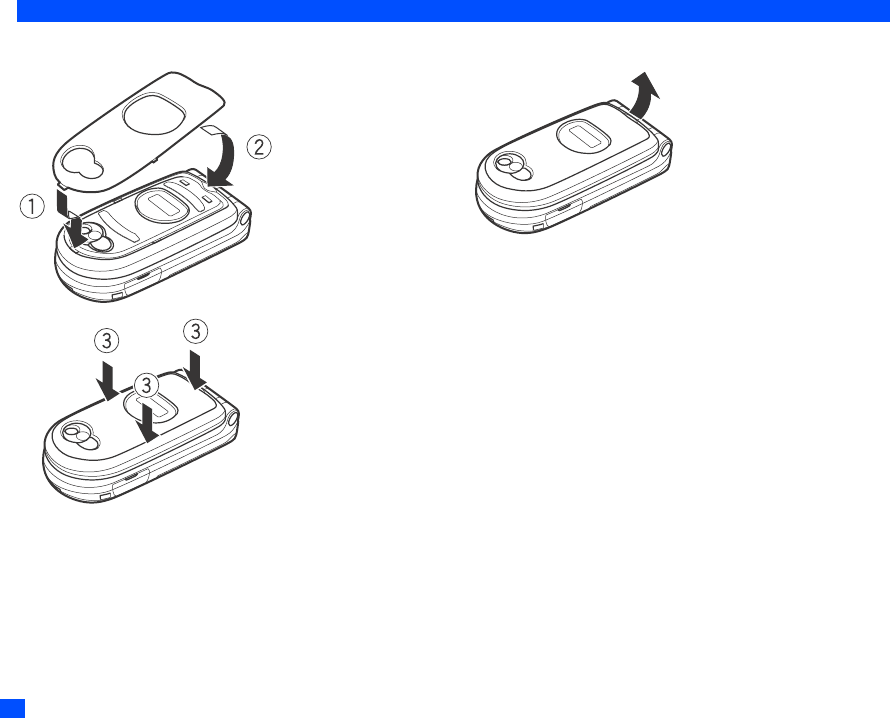
x
Attaching and Removing the Emblem
Attaching the Emblem Removing the Emblem
Attach the Emblem to the rear
cover in the order ➀ and ➁.
Push the Emblem firmly to
attach it to the rear cover.
Hook your finger underneath the dent
of the rear cover and remove the
Emblem.

xii
Before You Start iv
Cellphone system structure ............................................ iv
Display information .......................................................... v
Parts and functions ......................................................... vi
LCD and displayed icons ...............................................viii
Overview of menu function ............................................. ix
Attaching and Removing the Emblem ............................. x
Getting Started 1
Preparing the phone ........................................................ 1
Start-up ............................................................................ 3
Caring for Batteries 4
Standby and talk times .................................................... 4
Checking the battery........................................................ 4
Low battery alarm ............................................................ 4
Changing the battery ....................................................... 5
Basic Calls & Phone Use 6
Making basic calls............................................................ 6
Ending calls ..................................................................... 6
Receiving calls................................................................. 6
Putting a call on hold ....................................................... 7
Unsuccessful calls ........................................................... 7
Emergency calls .............................................................. 7
Last number redial ........................................................... 7
One-touch dial ................................................................. 8
Fast dialling...................................................................... 8
Displaying your own phone number ................................ 8
Multi-party calls................................................................ 8
Voice recall ...................................................................... 8
Mute................................................................................. 9
Call options ...................................................................... 9
Call settings ................................................................... 10
International dialling codes ............................................ 12
Roaming ........................................................................ 13
Selecting Features 14
Main menu ..................................................................... 14
Menu shortcuts selection ............................................... 14
Setting up Your Phone 15
Earpiece volume setting ................................................ 15
Phone Mode .................................................................. 15
Answer options .............................................................. 18
Activating Side keys....................................................... 18
ALS setup ...................................................................... 19
Time & date setting........................................................ 19
Setting the display to your language of preference ....... 20
Main-LCD settings ......................................................... 20
2nd-LCD settings ........................................................... 21
Power saving ................................................................. 22
Reset settings ................................................................ 22
Phonebook 23
Phonebooks................................................................... 23
Phonebook list Options menu........................................ 24
Personal data Options menu ......................................... 29
Scratchpad number ....................................................... 30
Voice mail ...................................................................... 30
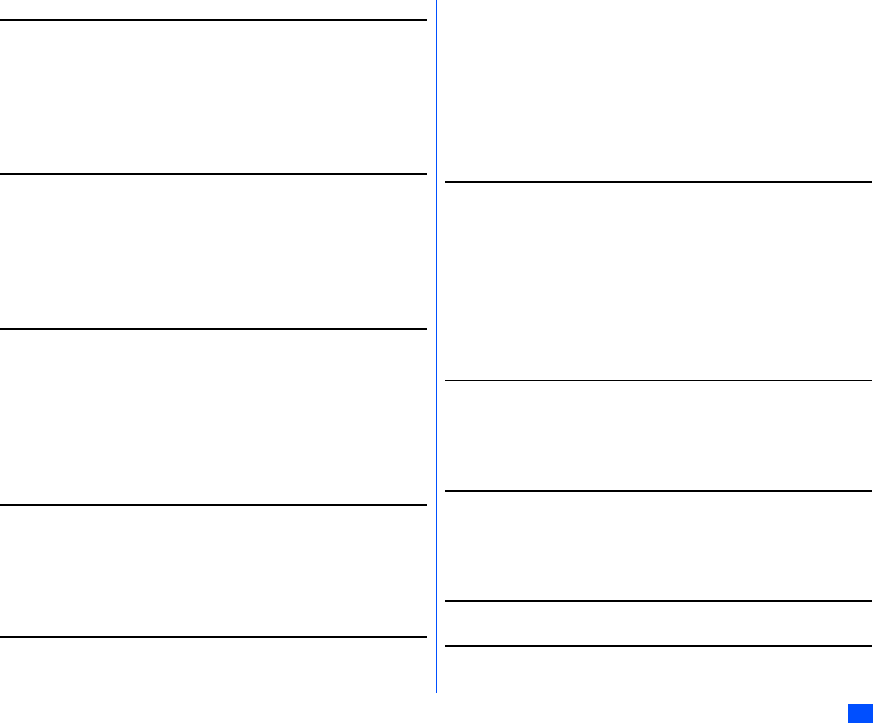
xiii
Text Entry 31
Mode change .................................................................31
T9®English text input .....................................................31
Normal text input............................................................32
Numeric input.................................................................32
Keys allocations .............................................................32
Security 33
Change PINs..................................................................33
PIN activate....................................................................34
Phone lock .....................................................................34
Bar calls .........................................................................35
FDN setting ....................................................................35
Message 36
Message overview .........................................................36
Reading messages ........................................................37
Options menus...............................................................38
Creating a message.......................................................40
Settings ..........................................................................43
Broadcast messages .....................................................44
Camera Function 45
Notes on using the Camera ...........................................45
Activating and terminating a Camera function ...............45
Taking a picture .............................................................46
Camera Options.............................................................46
i-mode Facilities 48
About i-mode..................................................................48
What can I download .....................................................48
i-mode icons................................................................... 49
i-mode quick start........................................................... 49
i-mode settings............................................................... 50
i-mode menu ..................................................................52
Mail menu ...................................................................... 55
i-mode user settings....................................................... 63
Mail settings ...................................................................64
Accessory 67
Calculator.......................................................................67
Clock alarm ....................................................................69
Scheduler.......................................................................70
ToDo list.........................................................................72
Notepad .........................................................................74
Voice memo ...................................................................74
Currency converter ........................................................74
My data 76
Pictures .......................................................................... 76
Sounds........................................................................... 77
File selector menu.......................................................... 78
Game 80
Poker..............................................................................80
Belt.................................................................................80
Clover.............................................................................81
Abbreviations 82
Index 83

1
Getting Started
Preparing the phone
Before trying to use your phone, make sure the followings have been carried out.
•Valid SIM card inserted
•Battery charged
SIM card
Before using your phone, you must sign-up with one of the digital network Service Providers. In addition to your subscription details you will receive a
personal SIM (Subscriber Identity Module) card which is inserted into your phone.
If the SIM card is removed, the phone becomes unusable until a valid SIM card is fitted. It is possible to transfer your SIM card to another compatible
phone and resume your network subscription. The screen on your phone will display appropriate messages if no SIM card is fitted.
,If the phone, or the SIM card, is lost or stolen then you should contact your Service Provider immediately in order to bar it from use.
2The phone supports a number of languages and the keyboard symbols have been chosen for world-wide operation.
2The digital technology of your NEC GSM phone helps to ensure that your conversations are kept secure.
2The SIM card contains personal data such as your electronic phonebook, messages (see page 36) and also details of the network services you have
subscribed to. The phone will not work (except for emergency calls on some networks) unless a valid SIM card is fitted.
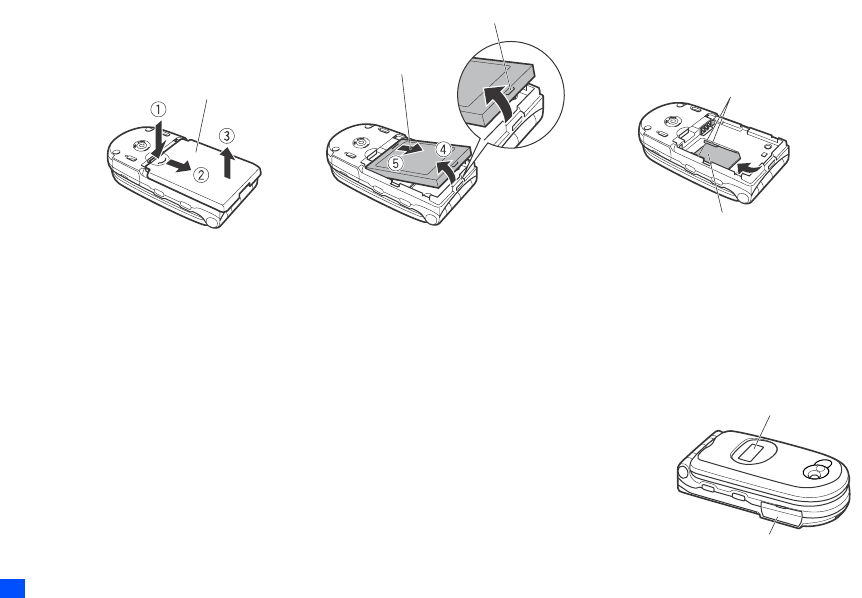
2
Inserting a SIM card
☛Press the edge of the Rear cover in the direction of arrow ➀, then slide the rear cover in the direction of arrow ➁. Finally, lift the cover up in the
direction of arrow ➂ to remove it.
☛Lift the knobs of the battery pack up in the direction of arrow ➃. Then slide the battery pack out in the direction of arrow ➄.
☛Insert the SIM card sliding it under the holders of the both sides. Slide the SIM card until it locks.
,If the SIM card is not fully inserted when the battery is replaced, damage to the SIM card can occur.
,Do not scratch the holders of the both sides when inserting or removing a SIM card.
2If the SIM card is already fitted, see “Start-up” on page 3.
Removing a SIM card
☛With the battery removed, remove the SIM card sliding it lightly.
Charging the battery
Before trying to use your phone, insert the phone’s battery, connect the NEC battery charger (AC adapter) supplied
with your phone to a suitable mains power socket and then connect the charger’s output to the phone’s charger
connector.
☛Connect the charger plug (AC adapter) into the connector at the side of the phone. Check that the Backlight
illumination is in colour 9 (Apple). When charging is completed, the Backlight illumination goes out.
You are recommended to switch off the phone during charging. If you need to receive calls, your phone can
be switched on and left in standby while being charged, although the total time taken to charge is then
increased.
Rear cover
Finger tab
Battery
Holder
SIM card
Backlight illumination
Charger connector

3
,Using any battery pack, AC adapter, Vehicle power adapter (option) or Desktop charger (option) not specified by NEC for use with this
phone can be dangerous and may invalidate any warranty and approval given to the cellphone. Do not connect more than one charger at
any time. Do not leave the charger connected to the mains supply when it is not in use.
,Do not try to charge the battery if the ambient temperature is below 5°C(41°F) or above 35°C(95°F).
,DO NOT connect a charger or any other external DC source until the phone’s battery is inserted.
,Damage may result if you do not press in the charger connector’s side catches when removing it from your phone.
2If the phone does not respond, please wait for a few minutes. The charging will then start.
2If you use the phone during charging, handle the phone carefully since the cable or adapter is connected.
2You can also charge the phone by using Desktop charger (option).
Start-up
Switching the phone on
☛Hold down for about a second to switch on. The screen will display the selected greeting (see page 20) and the phone is then in standby.
2You may need to charge the battery before using your phone. If the phone gives no response when switched on, read the information about batteries
on page 4.
2When your phone is turned on, the specified Ringer may sound.
Switching the phone off
☛Hold down until the display shows the switch off message.
PIN code
The SIM card issued by your service provider has a security feature called PIN code protection. The PIN (Personal Identification Number) is a number
put on to the card by your Service Provider, and is 4 to 8 digits long. Some service providers supply SIM cards which will cause your phone to prompt
for a PIN code when it is turned on. If this is the case, enter your code with the phone’s keypad. If you insert a SIM card other than your own, information
such as call logs may be lost.
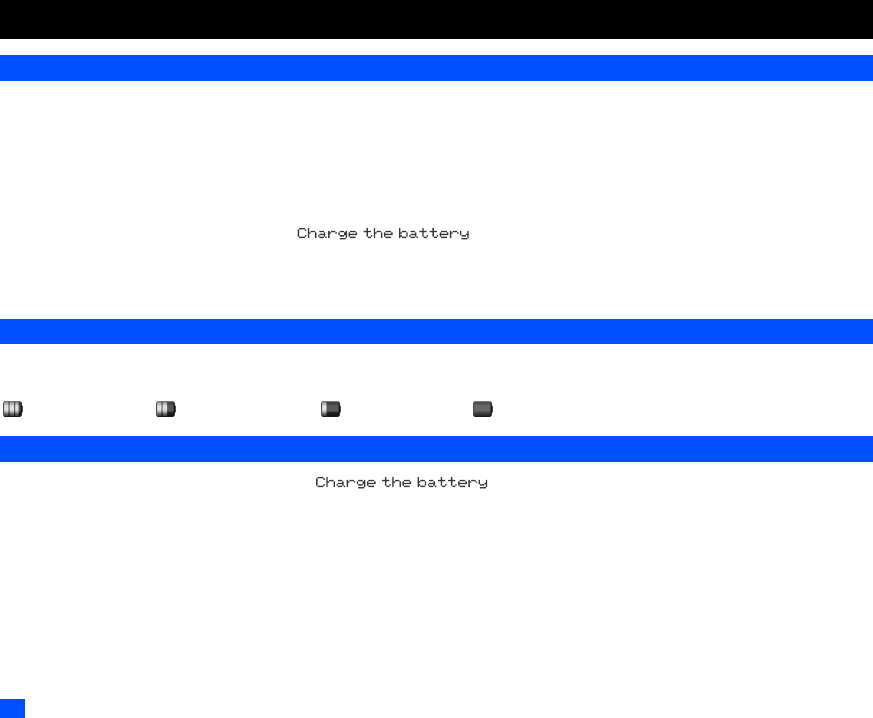
4
Caring for Batteries
Standby and talk times
Your phone works closely with the network you are using to provide the services you need, and the standby and talk times achieved will depend on how
you use the phone and choices made by the network operator.
In particular, factors such as your location within the network, the frequency at which this location is updated, the type of SIM card you have, your
reception of area or Cell broadcast messages and the use of Full Rate or Enhanced Full Rate speech, will affect both standby and talk times.
,IMPORTANT BATTERY CHARGING INFORMATION
Charging a very low battery
The battery’s charge continues to drop after the warning is displayed. In extreme cases where the battery is left
uncharged for some considerable time after this warning is displayed, a trickle charge is used to slowly top-up the battery to the safe level at which
the fast charging can begin. The phone can be in trickle charge for a few minutes before the fast charging starts.
,DO NOT connect a charger or any other external DC source if the phone’s battery is not inserted.
Checking the battery
☛Check icon at the top of the standby screen.
The block on the display shows the charge of your battery pack.
Full battery power Partial battery power Low battery power Battery empty
Low battery alarm
When the battery voltage falls below the working level, is displayed on screen accompanied by a short tone along with an
empty battery icon. The phone will automatically power down shortly afterwards.
2Please charge the battery as much as possible when the battery is very low.
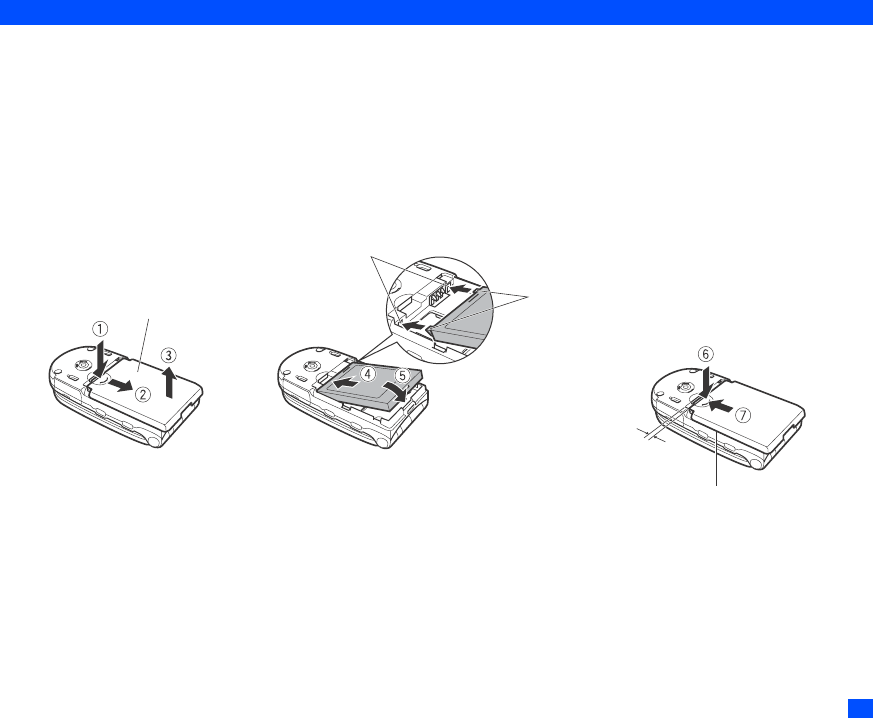
5
Changing the battery
,Be sure to turn the phone off before replacing the battery pack.
☛Press the edge of the Rear cover in the direction of arrow ➀, slide the rear cover in the direction of arrow ➁. Then, lift the cover up in the direction
of arrow ➂ to remove it.
☛With the caution of the label on the battery pack facing upwards, insert it into the cavity in the phone body in the direction of arrow ➃, making sure
that the tabs on the battery pack fit properly into the notches in the phone. Then press the battery pack down in the direction of arrow ➄ to clip it
into the phone.
☛Make sure that the battery pack is securely attached to the phone and align the rear cover with the grooves on the phone so that there is a gap
of about 3 mm at the end of the cover. Then, while pressing down as indicated by arrow ➅, slide the rear cover in the direction of arrow ➆ until
you hear a click.
Rear cover
Notches
Tabs
Check that there is no gap
between the rear cover
and the phone body.
About 3 mm
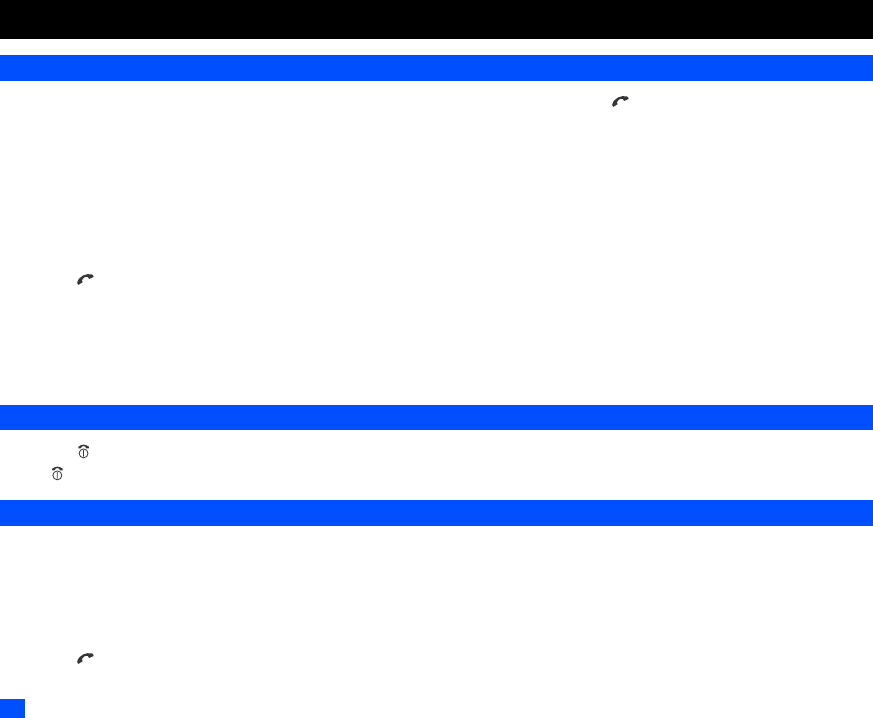
6
Basic Calls & Phone Use
Making basic calls
You make a simple call in the same way as you would with a normal phone, except that you need to press after entering the area STD code and the
phone number. To make international calls, you must first enter the international dialling code (see page 12).
2Use the full STD area code even if you are calling to a person in the same town. If the numbers are too long to be displayed within one line, excess
part is deleted and ‘...’ is added at its end.
2The Main LCD display shows the strength of the radio signal that links your phone to the network. A maximum signal is shown by 4 shaded blocks
and a minimum signal by 1 block.
Starting a call
☛Key in the phone number. Check the number on the display.
☛Press to send the call.
When the call is sent, the screen displays the number called or the name stored in the phonebook and a connection graphic or a CLI picture that has
been allocated to the number called (see page 23).
Correcting mistakes
Use the and keys to scroll through the number, then press CLR to clear individual digits or hold down CLR to completely clear a phone number.
Ending calls
☛Press briefly or fold your phone. The phone returns to the standby screen.
2If is held down, your phone will turn off.
Receiving calls
When someone calls your number, the Ringer will sound (if set - see page 16), the Backlight illumination glows in specified colour, and the phone number
of the caller may be displayed if the calling line identification facility is available and the caller has activated the feature. If the caller’s phone number has
been stored in your phonebook along with a name and a CLI picture (see page 26), that name and picture will be displayed. If the caller has withheld
their identity, the screen will give a message that the caller’s number is being withheld.
Accepting a call
☛Press .
▼
▼

7
Rejecting a call
☛Press briefly or fold your phone.
You also have options for holding calls and forwarding calls. These options depend on your network and your subscription arrangements.
If your phone receives a call and you do not answer it, the screen will display the phone number (or the name if stored) of the caller (if available). This
information is stored in the Missed calls list. Up to 10 missed calls are stored in this list.
2You can set your phone to answer a call when any key is pressed (see “Any key answer” on page 18).
2If you are making a call, the phone gives priority to receiving a call unless you have already pressed .
/See also: “Call diversion” on page 10 and “Call waiting and holding” on page 11.
/See also: “Call options” on page 9.
Putting a call on hold
You can put the received or dialled call on hold by pressing Softkey 1. To retrieve the call, press Softkey 1 again.
Unsuccessful calls
If dialled call is not successfully connected, the display will give an appropriate message.
If your phone is set to Auto redial, the number will be automatically called again after a short delay (see page 12).
Emergency calls
The standard emergency number of 112 can be used.
☛Key in 1 1 2.
☛Press to connect the call to the local emergency services.
2On some networks, emergency calls can be made using the 112 number without a SIM card inserted.
Last number redial
To redial the last number you called:
☛Ensure the standby screen is displayed and no phone number is shown.
☛Press twice. The last number you called will be dialled.
/See also: “Call options” on page 9.
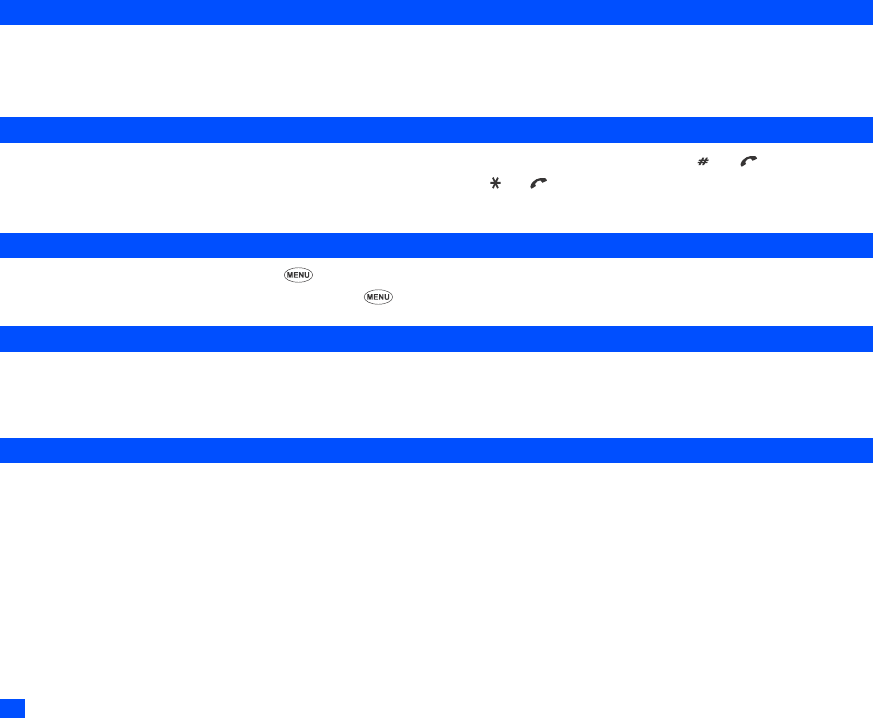
8
One-touch dial
One-touch dial for the phonebook(SIM) is available by pressing and holding a number 2 to 9.
2A number for the One-touch dial corresponds to the location number in the phonebook(SIM).
2One-touch dial is available only for the phone numbers with the location number 2 to 9 stored in the phonebook(SIM).
Fast dialling
Fast dials for the phonebook(SIM) is available by entering a number 1 to 255 (depending on the SIM card) and pressing and .
Fast dials for the phonebook(phone) is available by entering 1 to 500, then pressing and .
2A number for the Fast dials corresponds to the location number in the phonebook(SIM/phone).
Displaying your own phone number
☛With the standby screen displayed, press and 0.
2You can also display your own phone number by pressing 4, 1 and 6 from the standby screen.
Multi-party calls
If your SIM card is Multi-party enabled, you can make a conference call to more than one caller. You can even leave the call while the remaining
participants carry on with the call.
,Multi-party call facilities are SIM card and network dependent.
Voice recall
You can store up to 10 Voice recall recordings which can be allocated to a personal data stored in the phonebook(phone). To store the Voice recall sound,
see page 25. To use the Voice recall function, use the following procedure:
☛With the standby screen displayed, press and hold the ▼ key.
☛Within 4 seconds, say the word or words you have recorded to identify the record you wish to recall. If the word or words were recognized, the
phonebook contents will be called automatically.
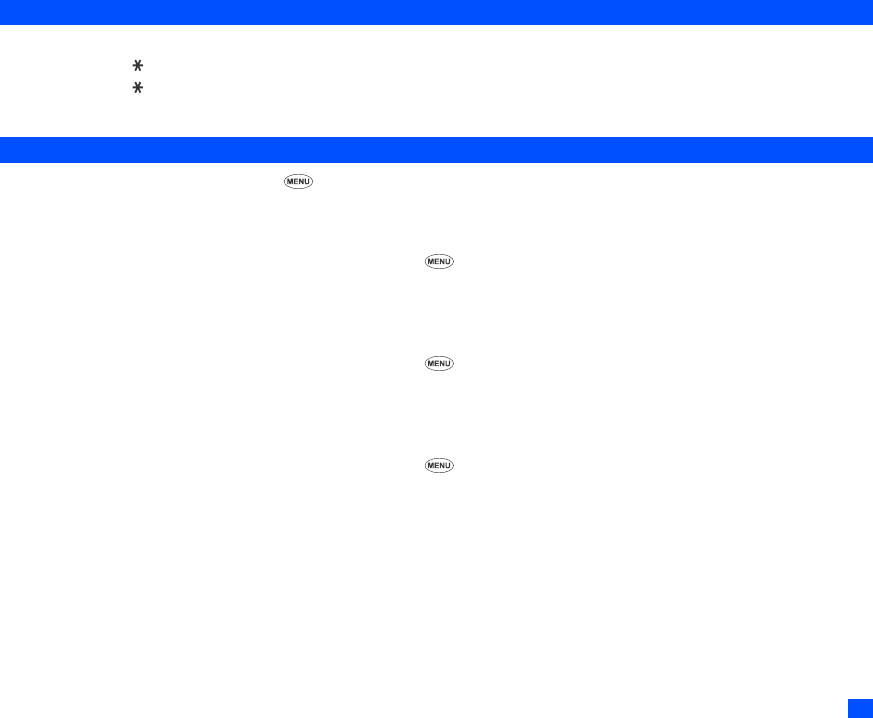
9
Mute
To mute the sound from the mouthpiece:
☛Press and hold to mute the sound during a call.
☛Press and hold again to retrieve sound.
2The mute function is automatically released after the calling.
Call options
☛With the standby screen displayed, press 4 and 3 to display the Call options screen before performing the following procedures.
Missed calls
☛Press 1 to display the list of missed calls.
☛Use the ▲ and ▼ keys to highlight a number in the list and press .
☛Press 1 to call the number, 2 to store the number in your phonebook, 3 to delete one item, 4 to delete all the items or 5 to display information.
Received calls
☛Press 2 to display the list of received calls.
☛Use the ▲ and ▼ keys to highlight a number in the list and press .
☛Press 1 to call the number, 2 to store the number in your phonebook, 3 to delete one item, 4 to delete all the items or 5 to display information.
Dialled calls
☛Press 3 to display the list of dialled calls.
☛Use the ▲ and ▼ keys to highlight a number in the list and press .
☛Press 1 to call the number, 2 to store the number in your phonebook, 3 to delete one item, 4 to delete all the items or 5 to display information.
2The Delete all facility is not applicable to the phonebook(SIM).
Last call duration
☛Press 4 to display the duration of the last call made on your phone.
☛Press Softkey 1 to reset the display to zero.
Total calls duration
☛Press 5 to display the total calls duration (incoming and outgoing calls).
☛Press Softkey 1 to reset the display to zero.

10
Charge info (Advice of charge - AoC)
,The AoC facility is SIM card and network dependent.
Total charge
☛Press 6 and 1.
☛Press Softkey 1 to reset the display to zero.
2To reset the display to zero, you may be prompted to enter the PIN2 code.
Maximum charge
☛Press 6 and 2.
☛Key in the maximum number of units allowed and press Softkey 1.
2To set the Maximum charge, you may be prompted to enter the PIN2 code.
Unit price
☛Press 6 and 3.
☛Use the ▲ and ▼ keys to select whether you enter a whole number (integer), a decimal number or a text code.
☛If you choose to enter a number (either integer or decimal), key in the required value, or if you selected text, use the text entry procedures to enter
the currency type, using a maximum of three characters. Then press Softkey 1.
2To set the Unit price, you may be prompted to enter the PIN2 code.
Redial blacklist
If dialled call is not successfully connected (e.g. number busy), the Auto redial facility will be offered (see page 12). If you have decided to Auto redial
and the call still fails, the number called will be added to the blacklist.
☛Press 7 to access the numbers in the blacklist.
Call settings
☛With the standby screen displayed, press 1 and 6 to display the Calls screen before performing the following procedures.
Call diversion
Setting Call diversion
☛With the Calls screen displayed, press 1. There will be a delay while your phone checks its divert status with your network.
☛Use the and keys to highlight the type of call you wish to divert.
☛Use the ▲ and ▼ keys to highlight one of the conditions.
☛When the phone number field of a divert condition is highlighted, either enter the phone number to divert to, or delete any existing phone number.
▼
▼
▼
▼
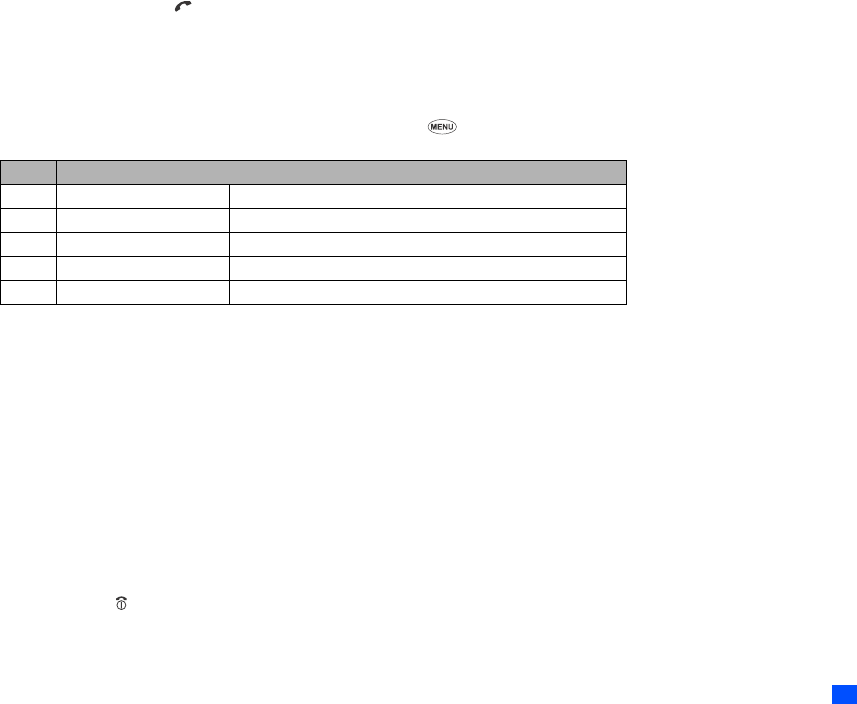
11
☛If you have made any mistake, use the ▲ and ▼ keys to highlight the appropriate field, then press Softkey 1 to clear any mistakes. When the
settings are correct press .
,Allow for a short delay while the network sends the divert status of your phone.
,There may be an additional charge for this service depending on your network.
,There may be unavailable settings depending on your network.
Call diversion edit Options menu
☛Use the ▲ and ▼ keys to highlight the required edit field, then press .
☛Press the appropriate key for the required option.
2Depending on the conditions, some options may be displayed in gray and not be available.
Call waiting and holding
This facility informs you when a call is being made to your phone while an existing call is in progress.
Setting up Call waiting
☛With the Calls screen displayed, press 2 to display the Call waiting screen.
☛Press 1 twice to activate, or press 1 and 2 to deactivate the call waiting.
Press 2 to check the status of call waiting.
Using call waiting
☛If you are on a call and another comes in, you will be alerted by a beep in the earpiece.
Press Softkey 1 to put the current call on hold.
☛Press Softkey 1 to accept the incoming call.
☛If you wish to change the call to answer, press Softkey 1. If you wish to merge calls, press Softkey 2. If you wish to end both the current call and
held call, press .
☛When both calls have been ended, the standby screen will be displayed.
No. Call diversion edit Options menu
1Copy Copies the number in the edit field.
2Paste Pastes the number which has been copied onto the edit field.
3 Disable all Disables all fields.
4 Phonebook Inserts a phone number in the edit field.
5 Add to Phonebook Adds the number to the phonebook.
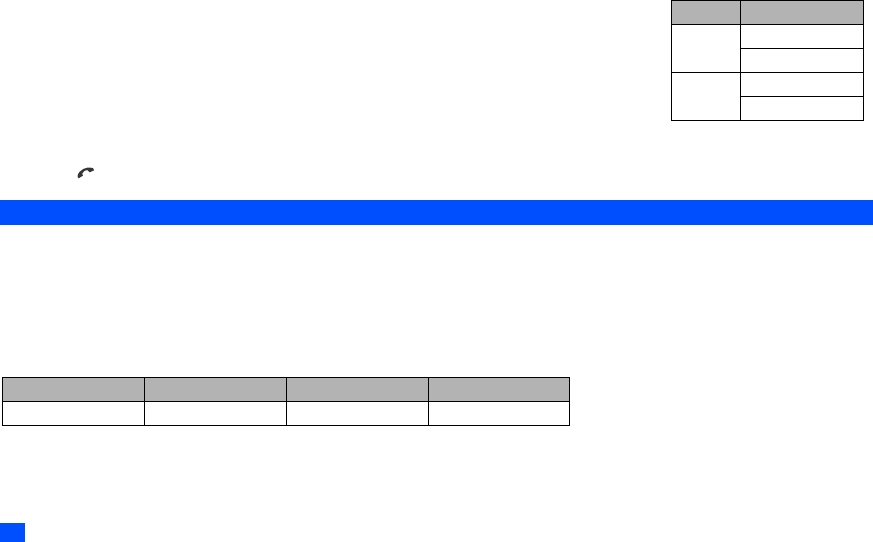
12
Auto redial
With the Auto redial facility, your phone will redial a number up to 10 times if the first attempt fails. A tone will be heard at each redial attempt. Your phone
cannot connect a call if the other party is busy or if there are network problems. Pressing Softkey 2 during a redial attempt will abort it. To set redial On
or Off, use the following procedure.
☛With the Calls screen displayed, press 3 to display the Auto redial screen.
☛Press 1 to activate or press 2 to deactivate the Auto redial facility.
Line identification
,The Line identification facility is network dependent.
The Line identification enables you to choose whether or not to send your own phone number when you make a
call and also whether or not to display a caller’s phone number when you receive a call. To set Line identification,
use the following procedure.
☛With the Calls screen displayed, press 4. The Line ID screen is displayed with a ✔ over an activated line
and a ✘ over a deactivated line.
☛To set the status of each line (see table right), use the ▲ and ▼ keys to select a line (the line will flash when
selected).
☛Press Softkey 1 to set the Line identification On or Off.
☛Press to save the current settings.
International dialling codes
When you make an international call from any country, you must start by dialling a special international access code. Your phone has the facility to prefix
a + symbol to the numbers, so that you need not enter the access code for the country that you are calling from.
Entering international dialling codes
☛With the standby screen displayed, hold down 0. The 0 character displayed will change to a + character.
☛Key in the country code, area code, and phone number that you wish to call.
The UK country code is always 44, no matter what country you are dialling from. For example, a typical UK number of 01189 123456 is entered as:
International access country code area code phone number
+ 44 1189 123456
Line type Setting
Outgoing Send own #
Show connected #
Incoming Show Incoming #
Return own #

13
Roaming
,You will be charged for calls forwarded to you while roaming.
The Roaming enables you to use your phone in many parts of the world and pay all charges through your normal service provider. Your network operator
usually has agreements with named networks in other countries so that automatic roaming can take place with these named networks. The phone also
allows you to set network preferences of your own.
When dialling, you will need to add the international access codes if required. So, storing all numbers with the codes (such as +44 for the UK) is helpful.
2Before leaving your home country, you should select any preferences such as Bar calls or Call diversion.
☛With the standby screen displayed, press 1 and 8 to display the Network screen before performing the following procedures.
Setting Automatic or Manual network selection
☛Press 1 to display the Search type screen.
☛Press 1 to select the Automatic mode or 2 to select the Manual mode.
,Before you manually select a network, ensure it is covered under the agreement you have with your service provider.
New search
☛Press 2 to search the available networks. The Network list screen will be displayed.
☛Use the ▲ and ▼ keys to highlight the desired network. Then, press Softkey 1 to connect to it.
Viewing/editing network list
,Before editing your network list, please consult with your service provider.
☛Press 3 to read the network list in the SIM memory.
☛Use the ▲ and ▼ keys to highlight the required network, then press .
☛Press the appropriate key for the required function.
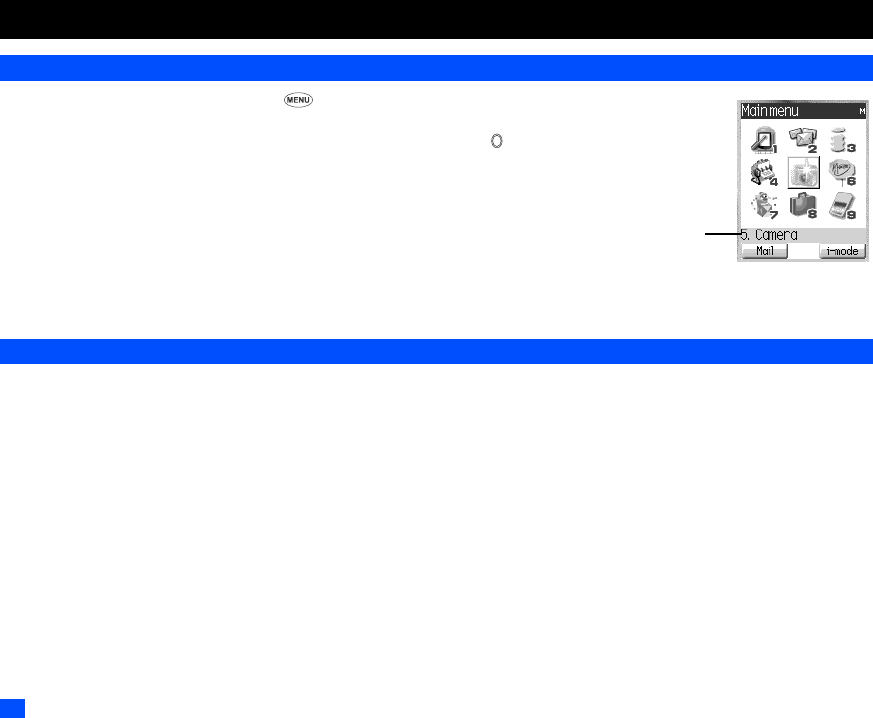
14
Selecting Features
Main menu
☛With the standby screen displayed, press to display the Main menu screen.
The Main menu has a set of icons for its top levels of options (examples of the top level are shown right) which can be selected
either using a combination of the 4-way navigation key (the ▲ and ▼ keys) and (menu selection), or just the keypad
(shortcuts selection).
The main menu icon numbers represent the following options:
2The title of the selected option will be displayed in the Help area as appropriate.
2SIM Toolkit icon is displayed only when your SIM card supports this function.
2With the Main menu screen displayed, press 0 to display the own number.
Menu shortcuts selection
The alternative shortcuts method of selection lets you jump straight to a menu or function without highlighting an icon and scrolling through the
intermediate menu options. The selections are made by pressing numbers on the keypad which relate to the displayed menu options.
2The instructions in this user guide make use of the shortcuts selection except special cases.
1 Settings 2 Message 3 i-mode
4 Phonebook 5 Camera 6 My data
7 Game 8 Accessory 9 SIM Toolkit
▼
▼
Help area
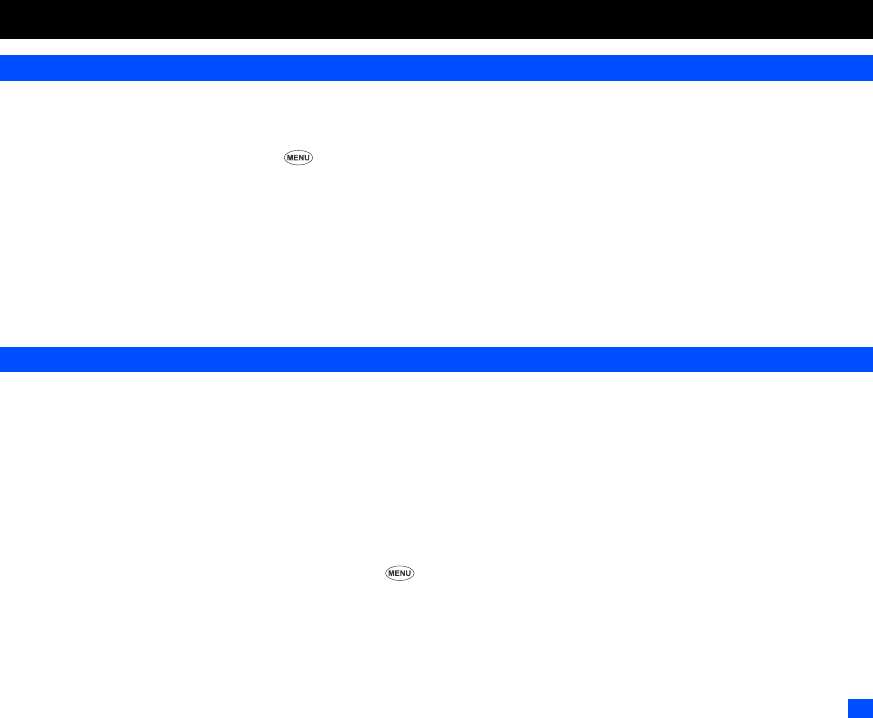
15
Setting up Your Phone
Earpiece volume setting
To change the earpiece volume, use the following procedures.
Method 1 (from the standby screen)
☛With the standby screen displayed, press 1, 1 and 1.
☛Use the ▲ and ▼ keys to adjust the setting as required, then press Softkey 1 to select the current setting.
Method 2 (from the standby screen)
☛With the standby screen displayed, press the Side keys.
☛Use the ▲ and ▼ keys to adjust the setting as required.
Method 3 (during a call)
☛Press the Side keys to adjust the setting as required.
Phone Mode
Your phone can be set to one of the following four modes.
•Normal mode
•Meeting mode
•Pocket mode
•Car mode
,Any changes made to the settings while in a particular mode will be stored and used when that mode is selected again.
Mode selection
☛With the standby screen displayed, press the ▲ key.
2You can also access the Phone modes screen by pressing 1 and 2 from the standby screen.
☛Press the appropriate key for the required mode.
2You can also set the Meeting mode by pressing and holding the ▲ key.
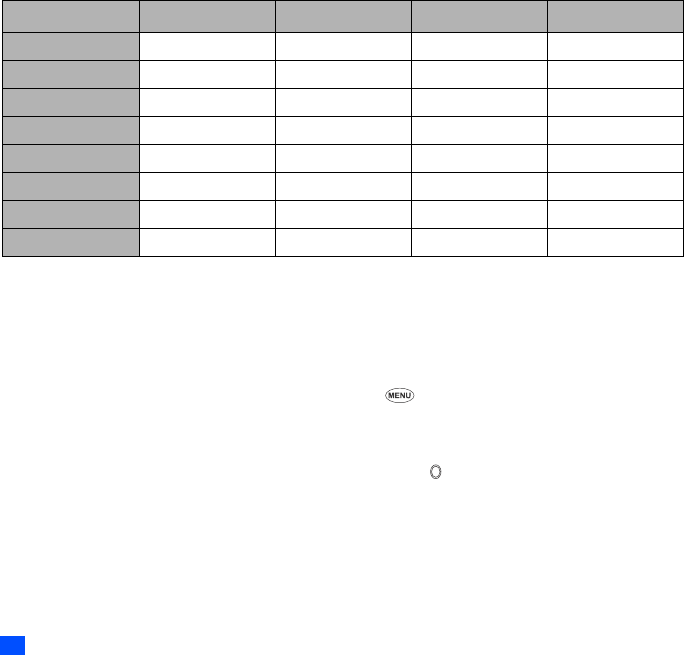
16
Default Mode settings
When a mode is selected, some of your phone’s settings are altered automatically to the respective mode.
The following table shows the default settings for each mode.
2When the selected mode is Car, the backlight is always set to On. This will reduce battery life.
2The default settings shown above may vary. Be sure to check the setting data with your phone.
Editing the Mode settings
☛With the standby screen displayed, press the ▲ key. Then use the ▲ and ▼ keys to highlight the required mode and press Softkey 1 before
performing the following procedures.
2You can also access the Phone modes screen by pressing 1 and 2 from the standby screen.
Ringer
☛Press 1 to display the list screen that includes the currently set melody.
☛Use the ▲ and ▼ keys to highlight the desired Ringer, then press .
/See also: “Sounds” on page 77.
Ringer volume
☛Press 2 to display the Ringer volume screen with a volume slider.
☛Use the ▲ or Side up key to increase or the ▼ or Side down key to decrease the volume setting to the level required (the slider moves in the
direction corresponding to the key pressed). Or press a number key (0-Quiet to 9-Loud) for the volume level.
☛Press Softkey 1 to save the current Ringer volume setting.
Normal mode Meeting mode Pocket mode Car mode
Ringer Default melody Default melody Default melody Default melody
Ringer volume Medium Quiet Loud Medium
Msg tone Default melody Default melody Default melody Default melody
Msg tone volume Medium Quiet Loud Medium
Key tone On Off On On
Service tone On Off On On
Vibrator Off On On Off
Auto answer Always Off Always Off Always Off On

17
2While receiving a call, the ringer volume can also be adjusted by pressing the Side keys.
2The Reminder tone volume for Scheduler corresponds to the Ringer volume.
Msg tone
☛Press 3 to display the list screen that includes the currently set melody.
☛Use the ▲ and ▼ keys to highlight the desired Message tone, then press .
/See also: “Sounds” on page 77.
Msg tone volume
☛Press 4 to display the Msg tone volume screen with a volume slider.
☛Use the ▲ or Side up key to increase or the ▼ or Side down key to decrease the volume setting to the level required (the slider moves in the
direction corresponding to the key pressed). Or press a number key (0-Quiet to 9-Loud) for the volume level.
☛Press Softkey 1 to save the current Message tone volume setting.
Key tone
☛Press 5 to display the Key tone screen.
☛Press 1 to activate or 2 to deactivate the Key tone.
Service tone
☛Press 6 to display the Service tone screen.
☛Press 1 to activate or 2 to deactivate the Service tone.
Vibrator
☛Press 7 to display the Vibrator screen.
☛Press 1 to activate or 2 to deactivate the Vibrator.
Auto answer
The Auto answer feature allows a received call to be connected automatically when you are using your phone in the Car mode and with the simple
hands free kit.
☛With the Car mode screen displayed, press 8 to display the Auto answer screen.
☛Press 1 to activate or 2 to deactivate the Auto answer.
2Auto answer option is available in the Car mode only.
2Auto answer works only when your phone is working with a handsfree kit or a headset.
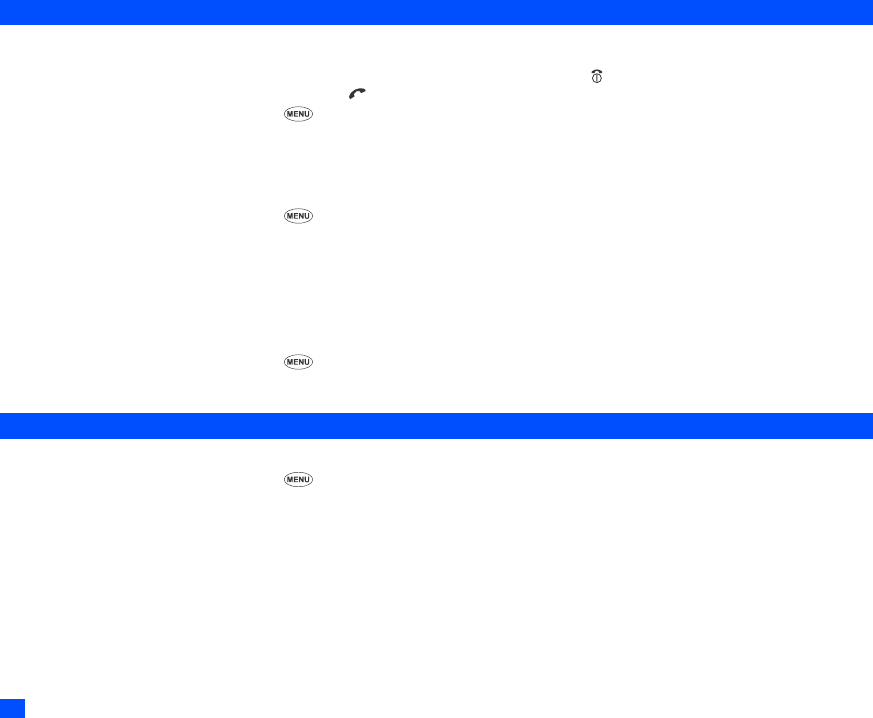
18
Answer options
Any key answer
When this facility is active, you can connect your phone to a received call by pressing any key (except , Softkey 2, the Side keys). When this facility
is turned off, you can connect to a received call by pressing or Softkey 1 only.
☛With the standby screen displayed, press 1, 1, 2 and 1.
☛Press 1 to activate or 2 to deactivate the Any key answer.
Ring silencer
When your phone is folded and the Ring silencer is active, you can stop sounding ringer during receiving a call or message by pressing the Side keys.
☛With the standby screen displayed, press 1, 1, 2 and 2.
☛Press 1 to activate or 2 to deactivate the Ring silencer.
2When your phone is folded and the Side key function is disabled, you cannot use Ring silencer function by pressing the Side keys.
/See also: “Mute” on page 9.
Fold answer
When your phone is folded and the Fold answer is active, you can take an incoming call by opening your phone.
☛With the standby screen displayed, press 1, 1, 2 and 3.
☛Press 1 to activate or 2 to deactivate the Fold answer.
Activating Side keys
On/off control of the Side keys when your phone is folded shall be performed.
☛With the standby screen displayed, press 1, 1 and 3.
☛Press 1 to enable or 2 to disable the Side key function for when your phone is closed.
2Even when the Side key function is disabled, you can take a picture by pressing the Side up key.

19
ALS setup
,The ALS facility is SIM card and network dependent.
If your SIM card supports ALS (Alternate Line Service) you can setup which line to use, what they are called and automatic line selection.
☛With the standby screen displayed, press 1, 1 and 4 before performing the following procedures.
Outgoing call
☛With the ALS setup screen displayed, press 1.
☛Press the appropriate key for the required option.
Voice mail
☛With the ALS setup screen displayed, press 2.
☛Press the appropriate key for the required option.
Time & date setting
Your phone has the ability to store the time and date for two time zones: Home (Local time) or World (Remote time). This information is displayed in 12
or 24 hour format on the standby screen, and can be used to trigger an alarm and for scheduler.
☛With the standby screen displayed, press 1, 1 and 5 before performing the following procedures.
Show clock
This option allows you to select the time that you prefer to display on the standby screen.
☛Press 1 to display the Show clock screen.
☛Press 1 to display local time only, or 2 for both local and remote times, or 3 for not displaying clock.
Setting the Local time and Remote time
☛Press 2 to display the Set time screen.
☛Press 1 to display the Local clock screen, or 2 to display the Remote clock screen.
☛Key in the local/remote time for the time setting, then press Softkey 1.
Setting the date
☛Press 3 to display the Set date screen.
☛Key in the date, press Softkey 1 to save the changes.

20
Setting date format
☛Press 4 to display the Set date format screen.
☛Press the appropriate key for the desired date format.
Setting time format
☛Press 5 to display the Set time format screen.
☛Press 1 to display time in 12 hour format, or 2 for 24 hour format.
Setting timezone
☛Press 6 to display the Set timezone screen. A ✔ is placed on the selected timezone.
☛Use the ▲ and ▼ keys to highlight the required timezone.
•If summer time can be set for the highlighted timezone, the Daylight savings will be displayed at the bottom of the screen. Press to activate/
deactivate the setting (a ✔ in the check box means the summer time is activated).
☛Press Softkey 1 to save the changes.
Setting the display to your language of preference
If the display is showing any language other than your own, use the following procedure to set the required language.
☛With the standby screen displayed, press 1, 1 and 6.
☛Press the appropriate key for the required language.
2When you have switched the language to be displayed, please wait until the new setting becomes active.
Main-LCD settings
The Main-LCD menu allows you to change the following settings.
☛With the standby screen displayed, press 1 and 3 before performing the following procedures.
Power on Greetings
A type of greeting screen can be selected as follows:
☛Press 1 to display the Greetings screen.
☛Press the appropriate key for the desired greeting type.
•If you select Text greeting, press Softkey 1 to display a greeting text. Key in a greeting text and press .
/When you select Animation, see “Pictures” on page 76.

21
Wallpaper
You can choose one of the stored pictures to be displayed as a background to the standby screen.
☛Press 2 to display the list screen that includes the currently set picture.
☛Use the ▲ and ▼ keys to highlight the picture that you wish to set as the wallpaper and press Softkey 1. The picture you have selected will be
displayed (preview). Press Softkey 1 to set the displayed picture to be wallpaper.
2A
✔
is displayed on the icon for which the item is currently selected.
/See also: “Pictures” on page 76.
Colour style
You can select the colour style from 8 different ones for your phone’s display.
☛Press 3 to display the Colour style screen.
☛Use the ▲ and ▼ keys to highlight a colour style. The screen colour changes to match the highlighted colour style. Press when the desired
colour style is highlighted.
2nd-LCD settings
The 2nd-LCD setting menu allows you to change the following settings.
☛With the standby screen displayed, press 1 and 4 to display the 2nd-LCD menu screen before performing the following procedures.
2nd-LCD display
☛Press 1 to display the Display screen.
☛Press 1 to set the 2nd-LCD display to On or 2 to set it to Off.
Fixed clock
When this function is On, only clock is displayed on the 2nd-LCD.
☛Press 2 to display the Fixed clock screen.
☛Press 1 to activate or 2 to deactivate the Fixed clock.
Incoming call No.
The Incoming call No. option allows you to display the caller’s phone number or the name (if you have stored it in the phonebook) on the 2nd-LCD screen.
☛Press 3 to display the Incoming call No. screen.
☛Press 1 to set the Incoming call No. function to On or 2 to set it to Off.

22
Direction
☛Press 4 to display the Display direction screen.
☛Press 1 to select the Direction1 or 2 to select the Direction2.
Contrast
☛Press 5 to display the Contrast screen.
☛Use the ▲ key to increase contrast by one level or the ▼ key to decrease it by one level until screen is at desired contrast.
☛Press Softkey 1 to save the contrast changes.
Backlight colour
This function enables you to set the backlight colour respectively for when the phone is in standby, when receiving messages, when receiving incoming
call, or when talking on the phone.
☛Press 6 to display the Backlight colour screen.
☛Press the appropriate key for the option of which you wish to change the setting.
☛Use the ▲ and ▼ keys to highlight the desired colour, then press Softkey 1.
2A
✔
is displayed beside the currently selected colour.
Power saving
☛With the standby screen displayed, press 1 and 5 to display the Power saving screen.
☛Press the appropriate key for the required setting level.
•Press 1 to set the Level 1 power save settings (minimum power save setting) for LCD brightness and Key Backlight.
•Press 2 to set the Level 2 power save settings for LCD brightness and Key Backlight.
•Press 3 to set the Level 3 power save settings (maximum power save setting) for LCD brightness and Key Backlight.
2When the selected mode is Car or the Camera finder screen is displayed, the backlight is always set to On.
2The backlight will be turned off after a given amount of time with no operation.
Reset settings
This function will reset your phone to its factory settings.
2Your phonebooks will be unaffected.
☛With the standby screen displayed, press 1 and 9 to display the Reset settings screen.
☛Key in the Security code and press Softkey 1. Then press Softkey 1 again to confirm.
,By restoring the factory settings, any changes you have made to your phone’s set-up will be lost.

23
Phonebook
Phonebooks
Your phone can have up to 7 directories stored on your SIM card and in your phone memory:
•Complete (a list of all the numbers stored in the ADN and FDN)
•Personal directories (ADN) in the SIM card
•Personal directories (ADN) in the phone memory
•Service dialling numbers (SDN)
•Fixed dialling numbers (FDN)
•Own number
•Voice mail number
2When viewing any of the directories described, you can scroll to the other directories (if your SIM card supports them) by pressing .
2The maximum number of phone numbers that can be stored on a SIM card is shared between the ADN, FDN and SDN directories.
Personal directory (ADN)
These numbers are known as abbreviated dialling numbers (ADN). There are two types of ADN, one is the phonebook stored in the phone memory
(the phonebook(Phone)) and the other is the phonebook stored on the SIM card (the phonebook(SIM)).
Phonebook(SIM)
•Up to 255 personal data can be stored in the SIM card.
•Each personal data contains a phone number, a name and a location number.
2The number of phone numbers that can be stored on a SIM card depends on the SIM card capability.
Phonebook(Phone)
•Up to 500 personal data can be stored in your phone memory.
•Up to 7 phone numbers (Home, Mobile, Work, Data, Fax, Other phone x 2) can be added to each personal data.
•Up to 2 Email addresses can be added to each personal data.
•2 descriptive information fields are allocated to each personal data.
•Each personal data can be allocated to a group.
•Up to 10 phone numbers can have a voice recognition recording allocated to them.
•Backlight illumination colour, a CLI picture and a ringer tone can be allocated to each personal data.
•Each personal data can be allocated to a location number (1 to 500).
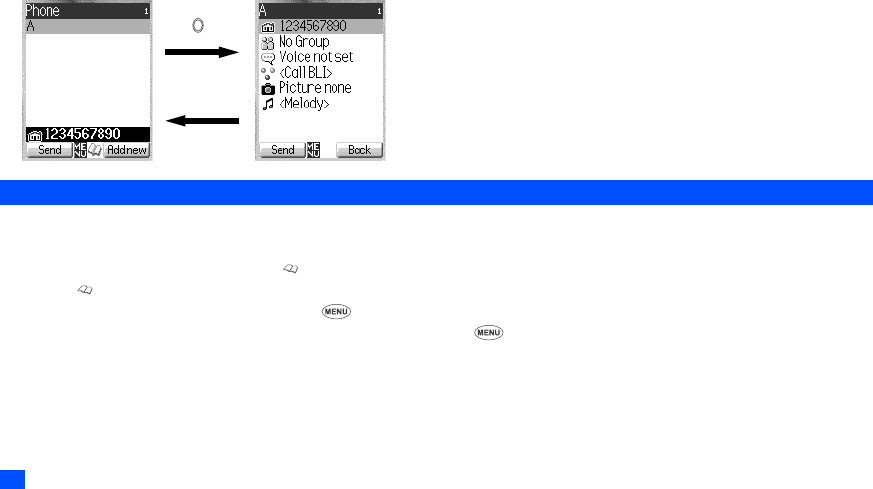
24
Fixed dialling numbers (FDN)
Fixed dialling numbers are a means of limiting which numbers can be called from your phone. With the FDN feature switched on (see page 35), you can
call with your phone the numbers you have stored in this phonebook and the emergency number only.
,Although FDN is supported by your phone, it must be present on your SIM card - check with your service provider.
Service dialling numbers (SDN)
The numbers stored in the SDN directory are pre-installed by your service provider. They will call numbers and services as agreed with your supplier
(e.g. customer enquiries, billing information, sportslines, weatherlines, etc.) and cannot be edited by you.
You will not be able to see the number which will be dialled but only the associated text title.
,Although SDN is supported by your phone, it must be present on your SIM card - check with your service provider.
Phonebook list Options menu
2When editing the data in FDN, you will be prompted to enter PIN2 code.
2Depending on the condition, some options may be displayed in gray and not be available.
☛With the standby screen displayed, press to display the Phonebook list screen.
☛Press until the required directory is displayed.
2You can also access each directory by pressing 4, 1 and the appropriate key for the desired directory from the standby screen.
☛Use the ▲ and ▼ keys to highlight the required personal data, then press to display the Phonebook list Options menu screen.
Adding a new personal data
☛With the Phonebook list Options menu screen displayed, press 1.
☛Press the appropriate key for the directory to which you wish to store the personal data.
☛Enter the name and other necessary information, then press Softkey 1 (see “Editing existing phonebooks”).
2It is best to store numbers using the international number format.
Softkey 2
Phonebook list screen Personal data screen

25
Editing existing phonebooks
☛With the phonebook list Options menu screen displayed, press 2.
2In the cases of phonebook(SIM) and FDN, only adding/editing the Name, a Phone number and location number is available in the following
procedures.
2In the cases of Own number and Voice mail number, only adding/editing the Name, a Phone number is available in the following procedures.
Adding/editing phone numbers, mail addresses & personal information
☛Use the ▲ and ▼ keys to highlight the field you wish to edit or add information to, then press .
☛Add the required number or information, or make a necessary change, to the selected field, and then press .
2Use the ▲ and ▼ keys to highlight another field to make further changes, if required.
☛Press Softkey 1 to save the changes.
2You can edit the Name, Phone numbers, Email addresses and Info fields in the above method.
/See also: “Text Entry” on page 31.
Allocating a group
☛Use the ▲ and ▼ keys to highlight the Group field, then press .
☛Use the ▲ and ▼ keys to highlight the Group you wish to add the current personal data to, then press .
☛Press Softkey 1 to save the changes.
Voice recall functions
☛Use the ▲ and ▼ keys to highlight the Voice tag field, then press to display the Voice tag screen.
Adding a Voice recall recording
☛With the Voice tag screen displayed, press 1 and say the name you wish to record as a voice tag.
☛Say the name again for confirmation according to the displayed message.
Playing a Voice recall recording
☛With the Voice tag screen displayed, press 2.
Deleting a Voice recall recording
☛With the Voice tag screen displayed, press 3.

26
☛Press Softkey 1 to save the changes.
2Up to 10 Voice tags can be stored.
2You can check the number of stored Voice tag and list of those tags (see “Displaying phonebook information” on page 29).
Allocating a backlight illumination colour
☛Use the ▲ and ▼ keys to highlight the Call BLI field, then press and 1.
☛Use the ▲ and ▼ keys to highlight the desired colour, then press .
☛Press Softkey 1 to save the changes.
Allocating a CLI picture
☛Use the ▲ and ▼ keys to highlight the Picture field, then press and 1 to display the list screen that includes the currently set picture.
☛Use the ▲ and ▼ keys to highlight the desired CLI picture, then press Softkey 1 to preview the picture.
☛Press Softkey 1 to select the previewed picture.
☛Press Softkey 1 to save the changes.
2A ✔ is displayed on the icon for which the item is currently selected.
/See also: “Pictures” on page 76.
Allocating a ringer
☛Use the ▲ and ▼ keys to highlight the Melody field, then press and 1 to display the list screen that includes the currently set melody.
☛Use the ▲ and ▼ keys to highlight the desired melody, then press Softkey 1 to play the melody.
☛Press Softkey 1 to stop playing the melody and select it, or press Softkey 2 to stop playing without selecting it.
☛Press Softkey 1 to save the changes.
2A ✔ is displayed on the icon for which the item is currently selected.
/See also: “Sounds” on page 77.
Allocating a Location number
☛Use the ▲ and ▼ keys to highlight the Location number field, then press .
☛Key in the desired location number, then press .
☛Press Softkey 1 to save the changes.
Copying the personal data
2In the case of Own number and Voice mail number, only Current copy is available.
Current copy
☛With the Phonebook list Options menu screen displayed, press 3 and 1.

27
☛Press the appropriate key for the desired destination to which you wish to copy the selected personal data.
☛Key in the desired location number or use the ▲ and ▼ keys to highlight the desired destination, then press .
2When you have chosen the personal data which includes more than one phone number/Email address for a destination that allows only one
number to be stored, the Origin number screen will be displayed where you can choose the number to be copied.
2When copying a personal data from the phonebook(Phone) to other directories, only the items which are supported by the destination directory
can be copied.
Package copy
☛With the Phonebook list Options menu screen displayed, press 3 and 2.
☛Press the appropriate key for the desired package copy.
2In the case of phonebook (Phone), you have to select the number to be copied.
☛Key in the desired location numbers, then press .
2When you have chosen the personal data which includes more than one phone number/Email address for a destination that allows only one
number stored, a new personal data for each number is created in the destination directory to store the number(s).
2When copying a personal data from the phonebook(Phone) to other directories, only the items which are supported by the destination directory
can be copied.
Moving the personal data to another directory
☛With the Phonebook list Options menu screen displayed, press 4.
☛Press the appropriate key for the desired destination to which you wish to move the selected personal data.
☛Key in the desired location number or use the ▲ and ▼ keys to highlight the desired destination, then press .
2When you have chosen the personal data which includes more than one phone number/Email address for a destination that allows only one
number to be stored, the Origin number screen will be displayed where you can choose the number to be copied.
Deleting
Delete current
☛With the Phonebook list Options menu screen displayed, press 5 and 1.
☛Press Softkey 1 to complete the operation.
Delete all
☛With the Phonebook list Options menu screen displayed, press 5 and 2.
☛Press Softkey 1 to complete the operation.
2This option operates only when the phonebook(Phone) is displayed before entering the Options menu screen.

28
Group functions
Adding/moving to a specified group
☛With the Phonebook list Options menu screen displayed, press 6 and 1.
☛Use the ▲ and ▼ keys to highlight the desired group, then press .
2The confirmation messages may be displayed after this procedure. In that case, press Softkey 1 to complete the operation.
Removing from the allocated group
☛With the Phonebook list Options menu screen displayed, press 6 and 2.
☛Press Softkey 1 to complete the operation.
Renaming a group
☛With the Phonebook list Options menu screen displayed, press 6 and 3.
☛Use the ▲ and ▼ keys to highlight the group you wish to change the name.
☛Press Softkey 1, then edit the group name and press .
Sorting
☛With the Phonebook list Options menu screen displayed, press 7.
Selecting sorting order
Alphabetical sorting
☛Press 1 to display the last viewed phonebook list in alphabetical order.
2You can jump directly to a name beginning with specific characters by pressing the appropriate key (e.g. press 5 once to jump to names
beginning with J, or twice to jump to names beginning with K.)
Memory location sorting
☛Press 2 to display the phonebook list screen in location order.
Calling the phone number in the searched personal data
☛Press to call the phone number displayed in the Help area.
2When viewing the phonebook(Phone) list screen, use the and keys to display the other stored numbers and Email addresses, if any, in the
same personal data for the highlighted name.
2When the Email address is displayed in the Help area, press Softkey 1 to create a new mail/MMS.
Going to Location
☛With the Phonebook list Options menu screen displayed, press 8.
☛Key in the desired location number and press Softkey 1. The Phonebook list screen with the selected personal data highlighted will be displayed.
▼
▼
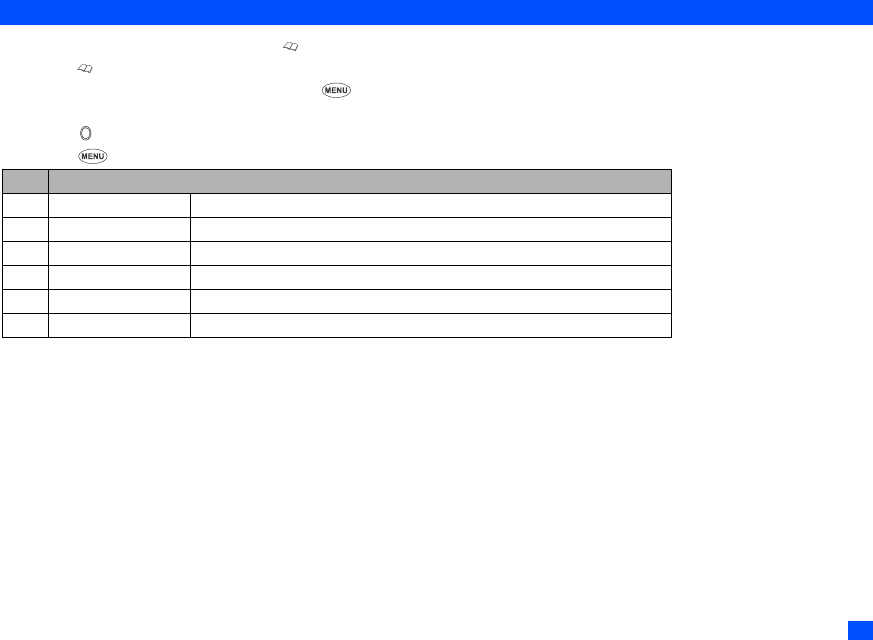
29
Displaying phonebook information
☛With the Phonebook list Options menu screen displayed, press 9.
☛Press 1 to display a summary of the Phonebook contents, or press 2 to display the list of the stored Voice tag.
Personal data Options menu
☛With the standby screen displayed, press to display the Phonebook list screen.
☛Press until the required directory is displayed.
2You can also access each directory by pressing 4, 1 and the appropriate key for the desired directory.
☛Use the ▲ and ▼ keys to highlight the required data.
☛Press , then use the ▲ and ▼ keys to highlight the required field.
☛Press to display the personal data Options menu screen.
/See “Phonebook list Options menu” on page 24 for the operation of 3 (Edit), 4 (Copy), 5 (Move), and 6 (Delete current).
Calling the selected phone number
☛With the personal data options menu displayed, press 1.
Sending an SMS/mail/MMS to the selected Email address/phone number
☛With the personal data options menu displayed, press 2.
☛Press the appropriate key for the type of message you wish to send.
2When you have highlighted the Email address in the personal data, only mail and MMS are available.
/See “Message” on page 36 and “Mail menu” on page 55 for details.
No. Personal data Options menu
1Call Call the highlighted phone number.
2 Create message Creates an SMS/mail/MMS to the highlighted phone number/Email address.
3Edit Enables to edit the selected personal data.
4Copy Enables to copy the selected phone number(s)/Email address(es).
5Move Enables to move the selected phone number(s)/Email address(es).
6 Delete current Deletes the selected personal data.
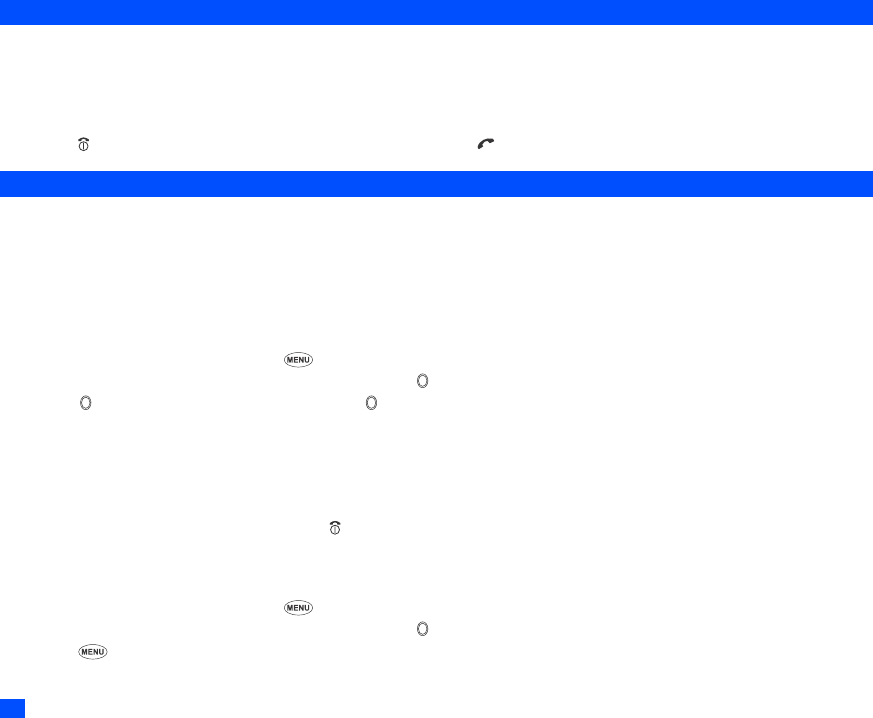
30
Scratchpad number
Your phone has a scratchpad facility that enables you to take down a phone number during a call and then make a call to it when you have finished. This
scratchpad number can be stored in memory for future use.
Noting & calling a scratchpad number
☛During a call, key in the number to be placed in the scratchpad. It will be shown on your phone’s screen.
☛Press when the call is finished. The number will still be displayed. Press . The number displayed will be dialled.
Voice mail
Voice mail function enables you to forward received calls to the Voice mail centre, and the caller can leave voice messages in your voice mail mailbox.
You will be notified by an icon on the standby screen if the caller leaves a voice message.
,The voice mail function is SIM dependent.
,The voice mail service is network dependent. Contact your Service Provider for details on your voice mail number.
Setting the Voice mail number
2This function is available when the Voice mail number has not been set.
☛With the standby screen displayed, press 4, 1 and 7 to display the Voice mail screen.
☛Use the ▲ and ▼ keys to highlight the required line, then press twice.
☛Press and key in the voice mail number, then press .
☛Press Softkey 1 to save the change.
Forwarding a call to the Voice mail centre
2This function needs a setup of Call diversion (see page 10).
☛Make sure the correct voice mail numbers are set beforehand.
☛When you receive a call you want to divert, press or Softkey 2 to divert the call to the voice mail centre.
Retrieving a Voice mail
2This function is available when the Voice mail number has been set.
☛With the standby screen displayed, press 4, 1 and 7 to display the Voice mail screen.
☛Use the ▲ and ▼ keys to highlight the required line, then press .
☛Press and 1.
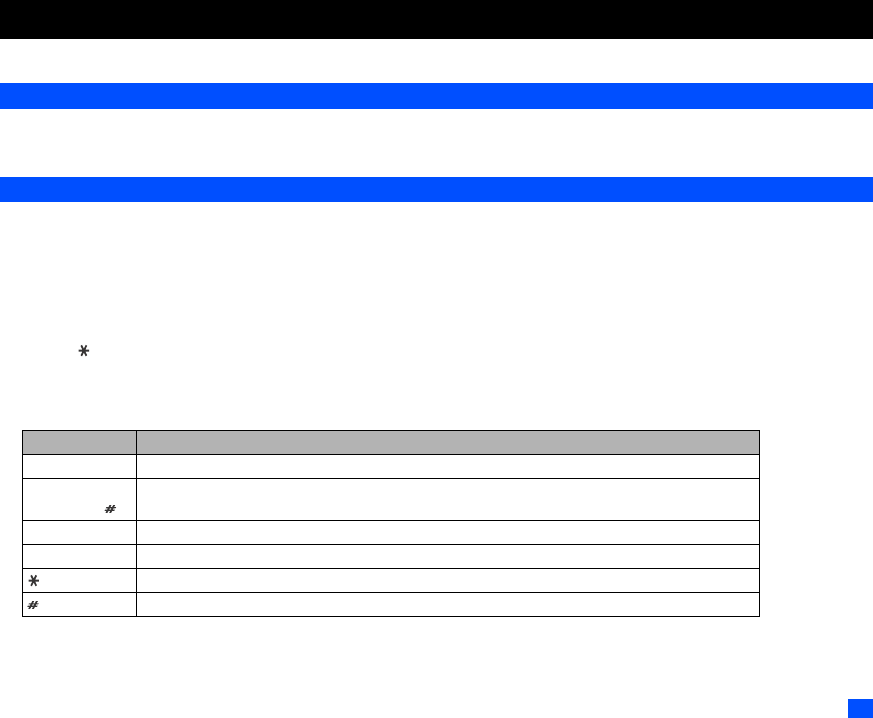
31
Text Entry
This section describes how you enter text. The same method of text entry can be used in phonebook editing.
Mode change
☛In Text entry screen, press Softkey 1 to change the text entry mode.
Text entry mode: T9® text input, Normal text input (ABC), Numeric input
T9®English text input
Your phone incorporates T9® Text Input, enabling fast, easy and intuitive text input. For each letter to be keyed in, you only need to press the number
key once. The screen will display the word you may require based on the internal English dictionary of your phone.
☛When the Text entry screen is displayed, press Softkey 1 until the entry mode is T9® English input.
i) For example, to enter “Good”:
☛ Press 4 6 6 3, then press 0 to confirm the word.
ii) To enter “Peter is good”:
☛Press to shift to upper case (for one letter). You will see a green arrow in the Help area.
☛Press 7 3 8 3 7 to display “Peter”, then press 0 to confirm.
☛Press 4 7 to display “is”, then press 0 to confirm.
☛Press 4 6 6 3 to display “good”, then press 0 to confirm and the sentence is completed.
Key Function
0 To complete a word and insert a space.
Softkey 1,
Softkey 2 or
To display other matching words (such as home, gone, hood and etc.).
or To place the cursor.
CLR To delete any particular letter.
To toggle between lower case, shift (upper case for one letter) and caps lock (permanent upper case).
To activate symbol mode when no word is highlighted.
▼
▼
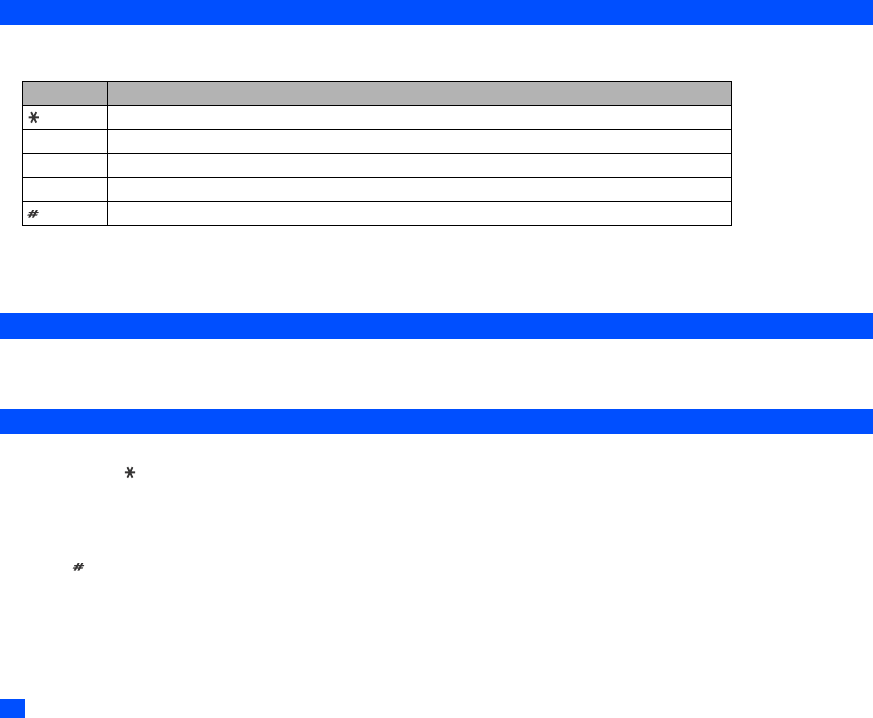
32
Normal text input
☛When the Text entry screen is displayed, press Softkey 1 until the entry mode is Normal text (ABC) input.
☛Use number keys to enter letters. For example, to enter “e”, press 3 twice; to enter “f”, press 3 three times. For other functions, see table below.
2If you have made a mistake, use the
▲ and ▼ keys to place the cursor to the right of the incorrect character then press CLR .
2When entering normal (ABC) text, and the character you require is displayed, press the key to move to the next character position (if you wait for
more than 1 second, the cursor will move one character to the right automatically).
Numeric input
☛When the Text entry screen is displayed, press Softkey 1 until the entry mode is Numeric input.
☛Use number keys to enter numbers.
Keys allocations
Whenever you need to enter text (for short messages, storing names with numbers, etc.), successive presses of a number key will display different
characters. Pressing in T9® English text input or Normal text (ABC) input toggles between lower case, shift (upper case for one letter) and caps lock
(permanent upper case). Whenever a text entry screen is displayed, pressing Softkey 1 enables you to select Normal text input (ABC), T9® Text input
(T9) or Numeric input (123).
Symbols
By pressing in a text entry mode, the Symbols screen will be displayed. With the Symbols screen displayed, pressing each key will input a symbol
according to the position on the Symbols screen. Use the ▲ and ▼ keys to select the row, then press the appropriate number on the column of the
required symbol.
Key Function
To toggle between lower case, shift (upper case for one letter) and caps lock (permanent upper case).
0 To insert a space.
CLR To delete any particular letter.
or To place the cursor.
To activate symbol mode.
▼
▼
▼
▼
▼

33
Security
The facilities outlined in this section enable you to protect your phone from improper and unauthorized use.
You may be required to enter one of the five codes (shown below). When the phone prompts you for one of these codes, key in the appropriate number.
•PIN code (provided by your Network to protect your SIM card if it is stolen)
•PIN2 code (provided by your Network for charge information and FDN services protection)
•PUK code (personal unblocking key in case you forget PIN code)
•PUK2 code (personal unblocking key in case you forget PIN2 code)
•Security code
,If you forget any of these codes, ALWAYS contact your service provider as they are the ONLY source for your codes.
Change PINs
PIN code
Your phone can be set up so it needs your PIN code entered at power up before the phone can be used at all. If the PIN code is not entered, not even
incoming calls can be answered. Entering your PIN code incorrectly 3 times (not necessarily in the same session) will invalidate the correct PIN code. In
such case you will have to contact your service provider for a PUK code to unblock your SIM card.
2Some SIM cards are set up so that PIN number entry cannot be turned off.
2When SIM PIN Lock is enabled, you can change the PIN code.
Changing your PIN code
☛With the standby screen displayed, press 1, 7, 1 and 1 to display the PIN change screen.
☛Key in the current code and press Softkey 1. You are prompted to enter the new code, then to enter it again for confirmation. A confirmation
screen will be displayed momentarily and the Change PINs screen will be displayed.
PIN2 code
Your phone supports advanced feature that may require a PIN2 code to be entered before they can be accessed or modified. Entering your PIN2 code
incorrectly 3 times (not necessarily in the same session) will invalidate the correct PIN2 code. In this case you will have to contact your service provider
for a PUK2 code.
,The PIN2 code is SIM card related and may only be available from your service provider.

34
Changing your PIN2 code
☛With the standby screen displayed, press 1, 7, 1 and 2 to display the PIN2 change screen.
☛Key in the current code and press Softkey 1. You are prompted to enter the new code, then to enter it again for confirmation.
Security code
The Security code is used to unlock the PIM features.
Changing your Security code
☛With the standby screen displayed, press 1, 7, 1 and 3 to display the Security code screen.
2The default setting of the Security code is “0000”.
☛Key in the current Security code and press Softkey 1. You are prompted to enter the new code, then to enter it again for confirmation.
PIN activate
☛With the standby screen displayed, press 1, 7 and 2 to display the PIN activate screen.
☛Press the appropriate key for the required setting.
Phone lock
While the Phone lock is active, you are only allowed to make emergency calls and enter the Security code. When the Phone lock is active, the Phone
lock will be deactivated only when the correct Security code is entered. To activate/deactivate the Phone lock, use the following procedure.
2Upon power-up, you are prompted to enter the security code if the Phone lock was active when the phone was powered down.
☛With the standby screen displayed, press 1, 7 and 3 to display the phone lock screen. You will be prompted to enter the Security code.
☛Key in the code and press Softkey 1. The Phone locked message will be displayed.
☛Press Softkey 1 to make an emergency call or Softkey 2 to unlock the function.
2To unlock the function, you are prompted to enter the Security code again and press Softkey 1.

35
Bar calls
This feature allows you to bar the following type of calls made or received on your phone.
•All outgoing (dialled) calls
•International outgoing (dialled) calls
•International outgoing (dialled) calls except to home
•All incoming (received) calls
•Incoming (received) calls when roaming
☛With the standby screen displayed, press 1, 7 and 4 before performing the following procedures.
Changing settings
2The selected settings have red bars over their icons.
☛With the Bar calls screen displayed, press 1 to display the Change settings screen, and use the ▲ and ▼ keys to highlight the type of
restriction (shown above) and the call type (Speech, Data, FAX or SMS), then press .
☛Press to save the Bar calls changes. The Change settings screen will be displayed and it will prompt to enter the Bar calls password.
☛Key in your Bar calls password to verify user identification to the network.
☛Press Softkey 1 to confirm and save changes to the network.
Setting password
,Bar calls facilities are network services and may require a password.
☛With the Bar calls screen displayed, press 2 to display the Set password screen.
☛Key in the current password, then key in the new password.
☛Key in the new password again for confirmation and press Softkey 1.
FDN setting
This feature enables you to restrict the use of dialled number to FDN.
,The FDN facility is network dependent.
/See also: “Fixed dialling numbers (FDN)” on page 24.
☛With the standby screen displayed, press 1, 7 and 5 to display the Fixed dialling screen.
☛Press 1 to enable or 2 to disable the FDN facility. The Verify PIN2 screen and the prompt to enter the PIN2 code will be displayed.
☛Key in the PIN2 code to verify user identification to the network.
☛Press Softkey 1 to confirm and save changes to the network.
▼
▼
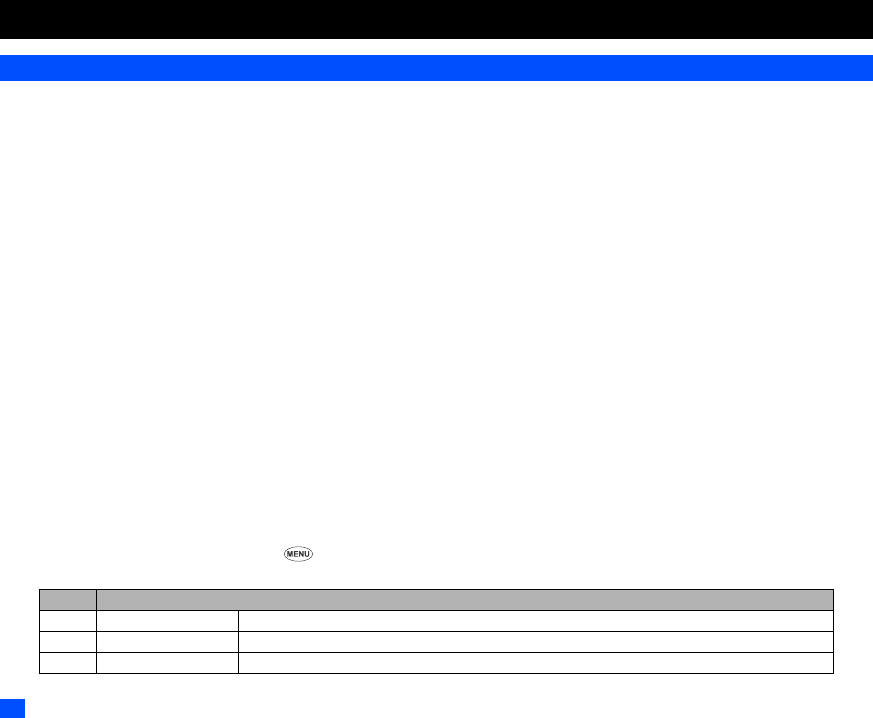
36
Message
Message overview
Message Services
Your phone supports the following messaging services:
•SMS (Short Messaging Service) allows you to send short messages (160 half-pitch characters max.) to a phone number. To send an SMS
message, the destination phone number must be a mobile phone with an SMS service subscription.
SMS service also supports EMS (Enhanced Messaging Service) for which the maximum length of the message you can send depends on the
number of linked messages (maximum 10 linked messages are available).
Standard messages
Your phone can send and receive SMS messages. While a message is being sent, a name, number and a CLI picture will be displayed (if a name and
CLI picture have been stored with the number in your phonebook(Phone)). If there are no name or CLI picture stored with the phone number you are
sending the message to, the number and a graphic will be displayed until the message has been sent and you get a confirmation message displayed.
The received messages are stored on the SIM card or in your phone memory depending on the message class. When you receive a message, your
phone will ring, the message icon will be shown on your phone’s display and its Backlight illumination will glow.
Your phone will automatically send a message to the service centre when your SIM memory for the SMS messages is full. When the service centre has
been informed that your SIM memory is full, the SIM full icon will be displayed. The service centre will not send your phone any further messages until
your SIM card has some free message space. Your phone will automatically notify the service centre that there is more space and message reception
will resume.
When you send a message you can attach a receipt request. This will cause the service centre to send you a message indicating whether your original
message was delivered successfully or not.
,The Short Message Service is network dependent.
2Please delete the unnecessary messages in the folders from time to time. The phone cannot receive any messages when the Inbox folder is full.
Message menu
☛With the standby screen displayed, press and 2 to display the Message screen.
☛Press the appropriate key for the required option.
No. Message menu
1 Inbox The received messages are saved.
2 Drafts The messages currently being edited are saved.
3Outbox The failed sent messages are saved.
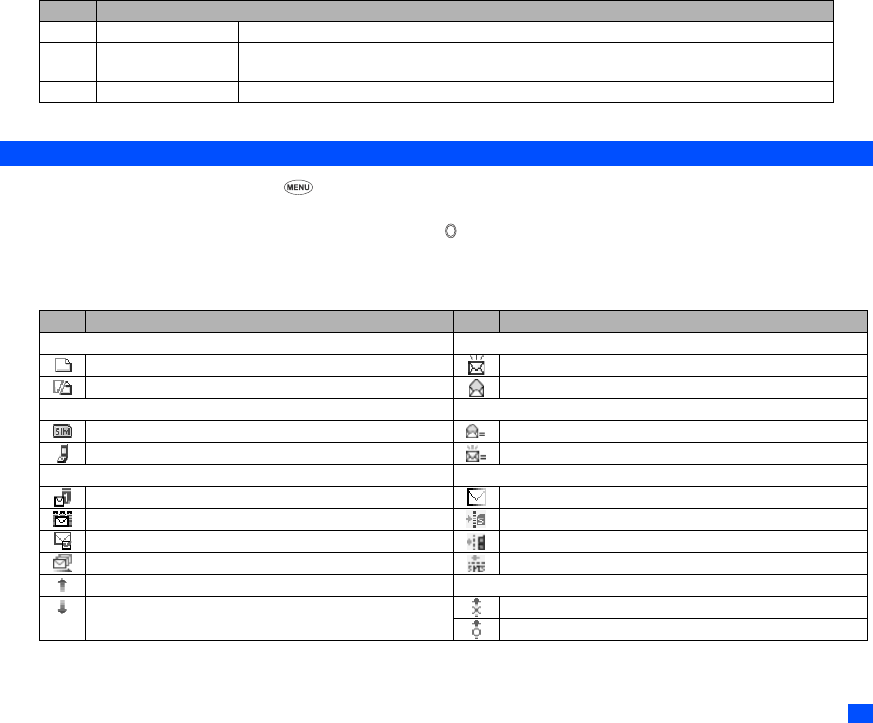
37
2If there are no message in the message list, the item is displayed in gray and you cannot select it.
Reading messages
☛With the standby screen displayed, press and 2 to display the Message screen.
☛Press the appropriate key for the required folder. The Message list of the selected folder will be displayed.
☛Use the ▲ and ▼ keys to scroll through the Message list, then press to display the required message (Message view screen).
2The unread message is displayed in bold.
☛If the message cannot be displayed in one page, use the ▲ and ▼ keys as necessary to scroll through the message.
2The following icons will be displayed.
4Sent The sent messages are saved.
5, 6 Folder1/Folder2 The messages you have moved with the Move msg are saved (see “Message list Options menu” on
page 38).
7CB The received broadcast messages are saved (see “Broadcast messages” on page 44).
Icons Descriptions Icons Descriptions
Message type icons Read / Unread status icons
SMS message. New / Unread message(s).
Incomplete SMS message. Read message(s).
Storing location icons Folder message status bar icons
Highlighted message stored in SIM. Number of read messages in the folder.
Highlighted message stored in Phone. Number of unread messages in the folder.
Sorting status icons Filtering status icons
Messages sorted by Date. SMS messages filtered by status (Incomplete).
Messages sorted by Name. SMS messages filtered by location (SIM).
Messages sorted by Read/Unread status. SMS messages filtered by location (Phone).
Messages sorted by Size. Filtered SMS messages.
Messages sorted by Ascending order. Message sent status icons
Messages sorted by Descending order. Sent but failed message.
Sent message.
No. Message menu (Continued)
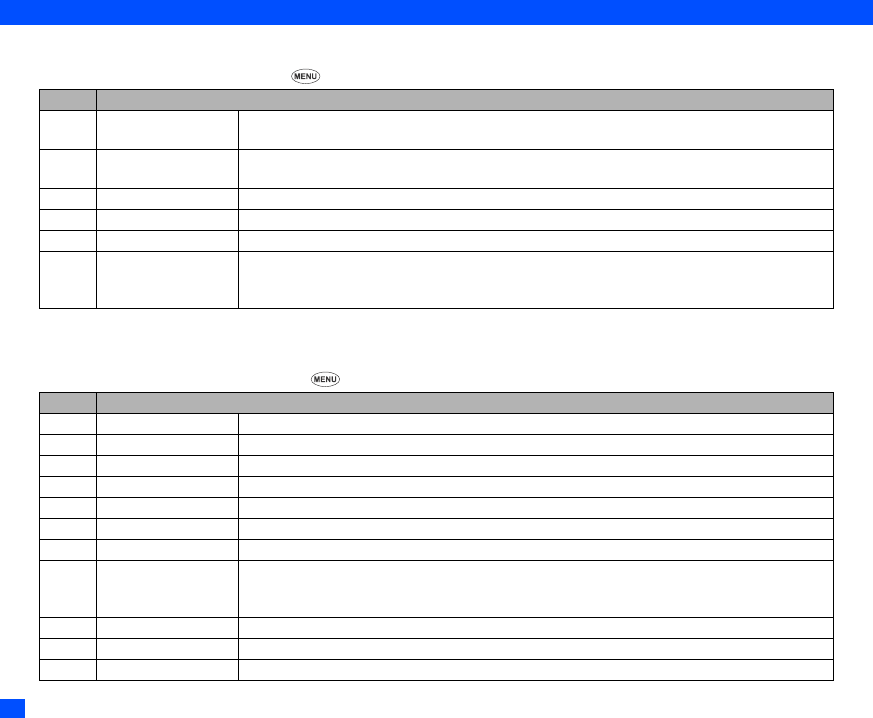
38
Options menus
Message Options menu
☛With the Message screen displayed, press to display the Message Options menu screen.
2Depending on the selected folder, some options may be displayed in gray and not be available.
Message list Options menu
☛With the Message list screen displayed, press to display the Message list Options menu screen.
No. Message Options menu
1 SMS settings Changes the settings for the SMS messaging function
(see “SMS settings” on page 43).
2 CB settings Changes the settings for the Cell broadcast function
(see “Broadcast messages” on page 44).
3 View msg status Displays the number of messages stored in your phone and SIM card, and their total data size.
4 Rename folder Renames Folder1 and Folder2 folders.
5View all Displays all the messages in all folders on the same list.
6 Msg filter
Sets the type(s) of messages to be displayed by selecting the desired filter option.
SMS: Filters the SMS messages by stored location (SIM, Phone of Both), or by status (Complete,
Incomplete or Both).
No. Message list Options menu
1Reply Replies to the sender of the highlighted message.
2 Reply all Replies to the sender and all other recipients of the highlighted message.
3 Delete Deletes the highlighted message(s).
4 Delete all Deletes all the messages in the current folder.
5Forward Forwards the message text of the highlighted message.
6 Msgs/page Enables to select either 3 or 6 messages being displayed on the screen.
7Move msg Moves the highlighted message to another folder, to the SIM card, or to the Phone.
8Sort msg
By: Sorts the messages by Date, by Name, by Read/Unread, or by Size.
Order: Sorts the messages in Ascending or Descending order.
Method: Sorts the messages alphabetically.
9Search Enables to search a message alphabetically.
– View details Displays detailed information on the highlighted message.
–Edit Edits the highlighted message (Drafts and Outbox only).
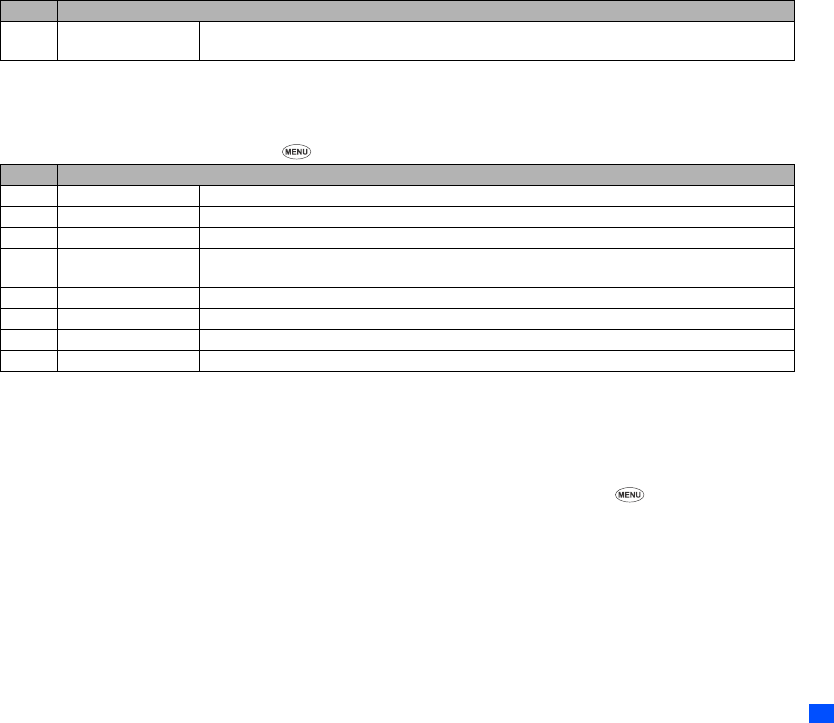
39
2Depending on the selected folder, the menu number and available options may vary.
2Depending on the selected folder, some options may be displayed in gray and not be available.
Message view Options menu
☛With the Message view screen displayed, press to display the Message view Options menu screen.
2Depending on the conditions, some options may be displayed in gray and not be available.
2The reply facility uses the phone number of the person who sent the message.
2The Save object shall be displayed if an object is highlighted.
2You can use Save object function only when there are some objects in the message.
☛Press the and keys to highlight the phone number, mail address or URL in the message. Then press to select the function as follows:
Phone number:
1. Add to P’book
2. Dial phone no.
3. Create message
Mail address:
1. Add to P’book
2. Create message
URL:
1. Add to bookmark
2. Go to URL
3. Create message
– Resend Resends the messages in the folder (Outbox only).
The messages can be resend fully or only the packets that failed reaching the recipient(s).
No. Message view Options menu
1Reply Replies to the sender of the highlighted message.
2 Reply all Replies to the sender and all other recipients of the highlighted message.
3 Delete Deletes the highlighted message.
4 View details Displays detailed information on the highlighted message. The detailed information includes From, To,
Date, Msg type, Size, and Folder.
5Forward Forwards the message text of the highlighted message.
6 Save object Saves object(s).
7Move msg Moves the highlighted message to another folder, to the SIM card, or to the Phone.
8 Highlight mode Activates the Highlight mode.
No. Message list Options menu (Continued)
▼
▼
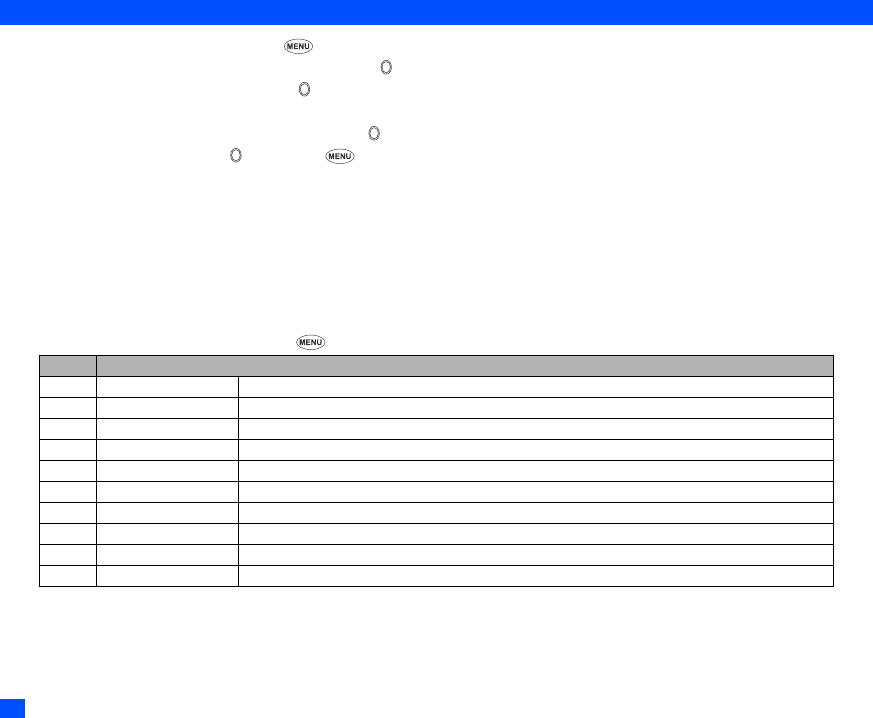
40
Creating a message
☛With the standby screen displayed, press 2 and Softkey 1 to display the New SMS screen.
☛Use the ▲ and ▼ keys to highlight the To field and press .
☛Input the required phone number and press .
2You can check other phone number(s) by pressing the or key.
☛Use the ▼ key to highlight the Message field and press . The Message screen will be displayed.
☛Key in your message and press . If you press during message creation, the Message edit Options menu screen will be displayed.
☛Press the appropriate key for the required option.
☛Press Softkey 1 to send the message.
2When you are in the ABC (normal text) mode, any word entered that is not in the T9 dictionary will be added automatically.
2When you are creating your message, press Softkey 1 to change the text entry mode.
2If you display another screen or receive a call while you are editing a message more than 1 character, the message will be saved automatically as
the draft message (see page 36).
Message composer Options menu
☛With the New SMS screen displayed, press to display the Message composer Options menu.
2Depending on the selected field, the menu number and available options may vary.
2Depending on the selected field, some options may be displayed in gray and not be available.
No. Message composer Options menu
–Add Enables to add a new recipient phone number.
–Edit Edits the existing recipient phone number or the message.
– Preview msg Displays a message preview screen.
– Delete Deletes the highlighted recipient or message.
– Delete all Deletes all the recipients or messages.
–Save Saves the message in Drafts folder.
– Phonebook Calls the Phonebook to insert a recipient phone number.
– Resend list Enables to insert a phone number from the redial list.
–Insert Enables to insert a new recipient phone number or a message.
– Address list Displays the recipient list in a full screen.
▼
▼
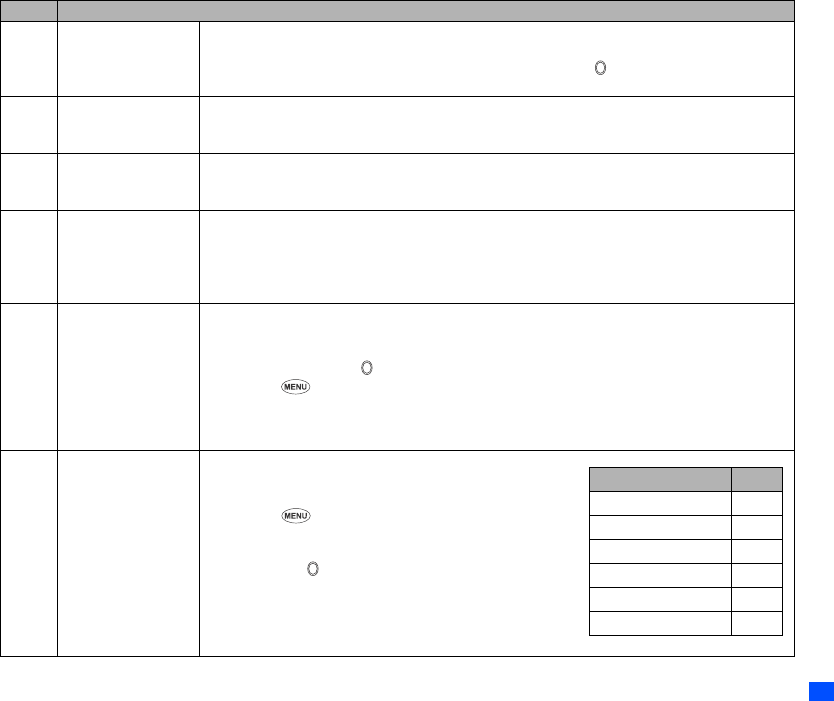
41
Message edit Options menu
No. Message edit Options menu
1Text colour
Selects the colour of text and background.
☛With the Message edit Options menu screen displayed, press 1.
☛Use the ▲ and ▼ keys to select the colour and press . A ✔ will be displayed on the
selected colour. Then, press Softkey 1.
2 Text format
Selects the font size (Normal, Large or Small) and font style (Bold, Italics, Underline or Strikethrough).
☛With the Message edit Options menu screen displayed, press 2.
☛Press the appropriate key for the required option.
3 Text alignment
Sets the text alignment (Left, Centred or Right).
☛With the Message edit Options menu screen displayed, press 3.
☛Press the appropriate key for the required option.
4Paste
Pastes the text which has been copied onto the clipboard in the Highlight mode.
☛With the Message edit Options menu screen displayed, press 4. The text on the clipboard will
be pasted.
2This function is active when the text to be pasted has been selected in the Highlight mode. You
cannot use it when it is grayed out.
5 Highlight mode
Activates the Highlight mode.
☛With the Message edit Options menu screen displayed, press 5.
☛Place the cursor at the beginning or the end of the text and use the and keys to highlight
the text, then press .
☛Press to display the Highlight mode Options menu screen and press the appropriate key
for the required option (see “Highlight mode Options menu” on page 42).
2Press Softkey 1 in the Highlight mode to toggle between On and Off. Press CLR to back to the
normal mode.
6 Insert object
Inserts the required object(s) into the message text.
☛With the message entry screen displayed, place the
cursor where you wish to insert an object.
☛Press and 6. Press the appropriate key for the
required object type.
☛Use the ▲ and ▼ keys to highlight the required object
and press .
2The “Insert object” option is displayed only in the
message entry screen. You cannot use the grayed out
function (see “My data” on page 76).
▼
▼
▼
▼
Insert object Options Key
Quick text 1
Sound 2
Pictures 3
Animation 4
Emoticon 5
Pictograph 6
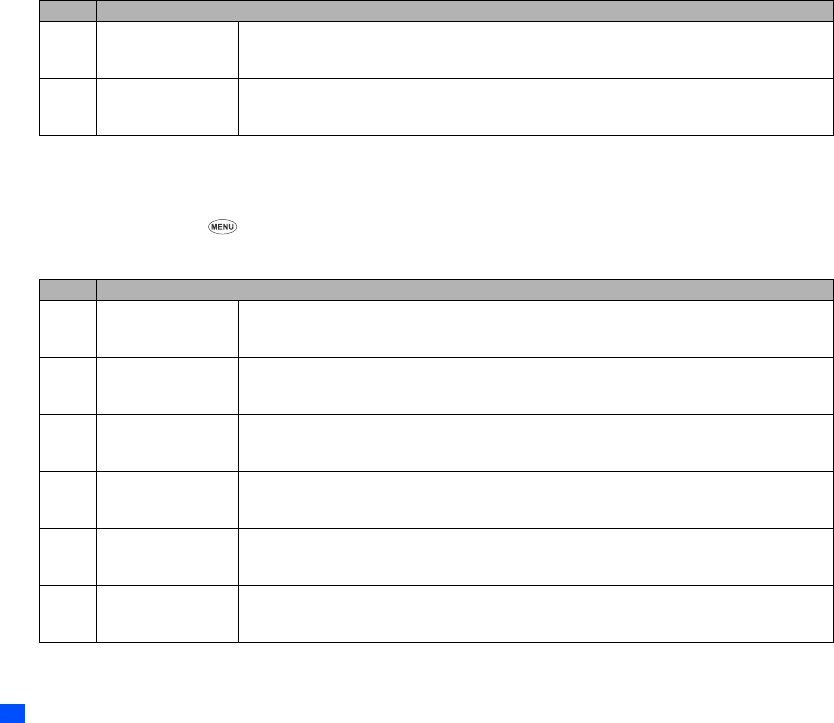
42
2Depending on the conditions, some options may be displayed in gray and not be available.
Highlight mode Options menu
☛With the Message edit Options menu screen displayed, press 5. The Highlight mode screen will be displayed.
☛In the Highlight mode, press to display the Highlight mode Options menu.
2The first two options (Text colour, Text format) will operate similar to those in the Message edit Options menu, however, only for the highlighted
text.
7 T9 Language
Sets the T9 text mode on.
☛With the Message edit Options menu screen displayed, press 7.
☛Press the appropriate key for the required language.
8 Edit settings
Sets the Write mode (Insert or Overwrite) and Clear mode (Backspace or Delete).
☛With the Message edit Options menu screen displayed, press 8.
☛Press the appropriate key for the required option.
No. Highlight mode Options menu
3Copy
Copies the highlighted part of text onto the clipboard.
☛With the Highlight mode Options menu screen displayed, press 3. The highlighted part of text
will be copied onto the clipboard.
4Cut
Cuts the highlighted part of text.
☛With the Highlight mode Options menu screen displayed, press 4. The highlighted part of text
will be copied onto the clipboard and deleted from the document.
5 Delete
Deletes the highlighted part of text.
☛With the Highlight mode Options menu screen displayed, press 5. The highlighted part of text
will be deleted.
6 Select word
Selects (highlights) the required word.
☛With the Highlight mode Options menu screen displayed, press 6. The nearest word to the
current cursor's place will be highlighted.
7 Select paragraph
Selects (highlights) the required paragraph.
☛With the Highlight mode Options menu screen displayed, press 7. The entire paragraph which
includes the current cursor's place will be highlighted.
8 Select all
Selects (highlights) the required text.
☛With the Highlight mode Options menu screen displayed, press 8. The entire text displayed will
be highlighted.
No. Message edit Options menu (Continued)
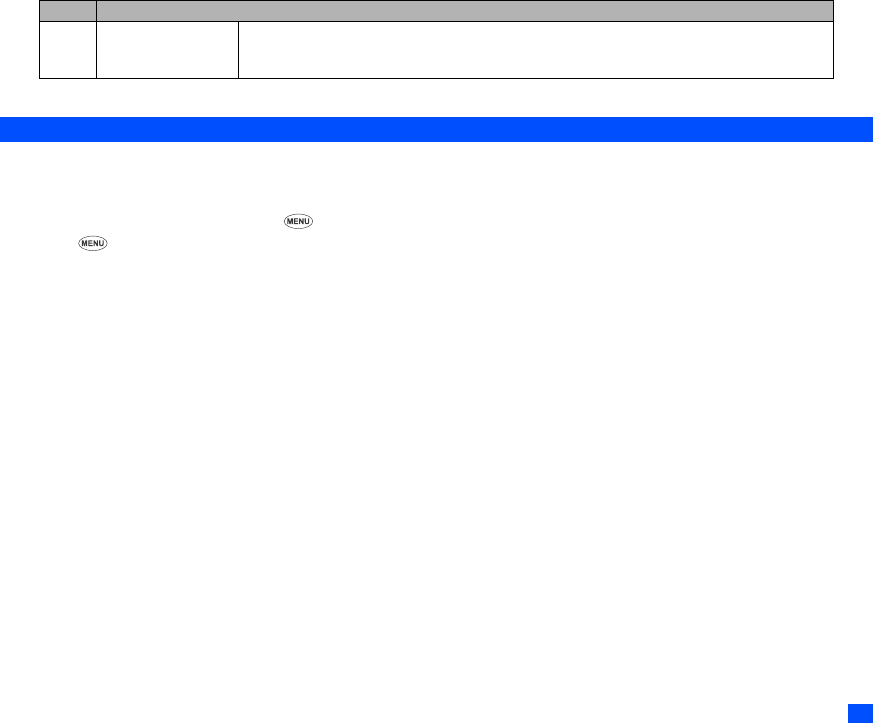
43
2Depending on the conditions, some options may be displayed in gray and not be available.
Settings
The following describes the setting items for SMS settings.
SMS settings
☛With the standby screen displayed, press and 2 to display the Message screen.
☛Press and 1 before performing the following procedures.
SMS centre
This option enables to edit the SMS centre number. This number is saved in the SIM card.
☛Press 1 to display the SMS centre screen.
☛Input the number and press Softkey 1.
Auto display
This option enables to turn the automatic display function on/off. This function displays the received SMS message automatically.
☛Press 2 to display the Auto display screen.
☛Press 1 to activate or press 2 to deactivate the Auto display.
Receipt request
,The Receipt request facility is network dependent.
This option enables to select whether to request a receipt of the sent SMS messages.
☛Press 3 to display the Receipt request screen.
☛Press 1 to activate or press 2 to deactivate the Receipt request.
9 Save quick text
Saves the highlighted part of text.
☛With the Highlight mode Options menu screen displayed, press 9. The highlighted part of text
will be saved as Quick text.
No. Highlight mode Options menu (Continued)

44
Max linked msgs
You can set the maximum number of linked SMS. This function divides the text message exceeding the maximum number or characters allowed in
an SMS message into multiple messages.
☛Press 4 to display the Max linked msgs screen.
☛Key in a number between 1 and 10, and press Softkey 1.
,The maximum number of linked SMS depends on the network.
Validity period
You can select the period of time the SMS message is stored for on the SMS centre while trying to deliver the message.
☛Press 5 to display the Validity period screen.
☛Press the appropriate key to select the period.
Broadcast messages
These messages (e.g. weather reports, news) are sent by the network to all phones in a certain area.
,Broadcast message service is network dependent. Please contact your service provider for details.
☛With the standby screen displayed, press 2 and 8 to read the Broadcast messages.
Broadcast settings
☛With the Message screen displayed, press and 2 to display the CB settings screen before performing the following procedures.
Display filter
You can select the Filter setting for the Cell broadcast messages.
☛With the CB settings screen displayed, press 1 to display the CB enable screen.
☛Press 1 to receive none, press 2 to receive all the broadcast message, press 3 to specify a list or CBMI(Cell Broadcast Message Identifier) to
receive broadcast from.
Languages
☛With the CB settings screen displayed, press 2 to display the CB languages screen.
☛Press the appropriate key for the required language.

45
Camera Function
Camera function enables you to take pictures and save them into a JPEG file. You can enjoy the picture files in many ways: send it attached to a mail/
MMS, set it as the wallpaper for your phone, etc.
Notes on using the Camera
Handling the Camera
2Your phone’s camera is constructed using extremely high-precision technology, but there may be lines or dots on the screen that appear
permanently dark or bright. Note also that the amount of noise in the image (white lines, etc.) may increase noticeably when you take pictures in
dimly-lit places.
2Fingerprints or grease on the lens can result in focusing problems or dark images. Wipe the lens clean with a soft cloth before taking pictures.
2Take care not to apply force to the lens when folding your phone. This could damage the lens.
2The image quality may be degraded after your phone has been left for a long period in a warm place.
2Exposing the camera to direct sunlight for a long period could discolour the camera’s internal colour filter and cause discoloured images.
2Camera mode is automatically cancelled if none of the phone’s keys are pressed for 3 minutes or longer.
Precautions when taking pictures
2You cannot switch camera’s shutter sound off. The shutter makes a clicking noise even when the phone is in Meeting mode.
2Take care to avoid camera shake. Moving the phone when you take a picture will result in a blurred image. Hold the camera firmly to keep it still
when you take a picture, or use the auto timer to take the shot.
2Note that if you attempt to shoot directly into a strong light source, such as the sun or another bright light, the image may turn dark or be disrupted.
Copyright information
2Images shot on your phone cannot be used in ways that infringe copyright laws without the consent of the copyright holder, unless intended only
for personal use. Note that some restrictions apply to the photographing of stage performances, entertainments and exhibits, even when intended
purely for personal use.
2Users are also asked to note that the transfer of images protected under copyright laws is only permissible within the restrictions imposed by those
copyright laws.
,Be considerate of other people’s privacy when you take a shot by using the camera of your phone and send it to others.
Activating and terminating a Camera function
☛With the standby screen displayed, press to display the Camera finder screen on your Main-LCD.
2You can also access the Camera finder screen by pressing and 5 from the standby screen.
☛Press CLR or Softkey 2 to return to the previous screen from the Camera finder screen or press to return to the standby screen.
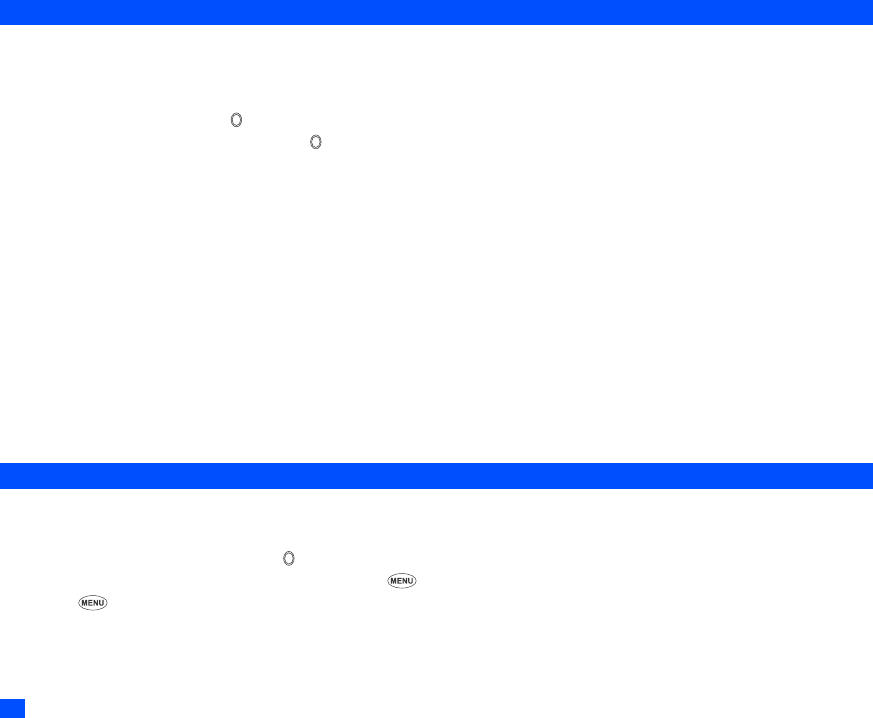
46
Taking a picture
Taking a picture
☛Activate the Camera function.
☛Look into the Camera finder screen and adjust the camera position to place the target on the screen.
☛Hold the Camera still, and press or the Side up key.
☛Check the picture. If successfully taken, press .
The default file name for the picture is the date, month, year, hour, minute and second from the date and time settings of your phone.
The picture is saved as a JPEG file in the Photo folder (see page 76).
2If a call comes in while you are checking or storing a photographed image, image storage is cancelled. When this occurs, the next time you select
Camera function, a message appears to say that you have an image that was not stored, allowing you to check and store the image.
Using the Light
☛With the Camera finder screen displayed, press Softkey 1 to activate or deactivate the Light.
2Take care not to hold the Light too close to your or other people’s eyes when the Light is lit.
Zoom
☛With the Camera finder screen displayed, press the ▲ or ▼ key to activate or deactivate the Zoom mode.
Controlling brightness
☛With the Camera finder screen displayed, use the and keys to control the brightness level of the picture. The current brightness level is
displayed on the left of the Status icons area.
Camera Options
Before taking picture
Camera Options menu
☛With the standby screen displayed, press to display the Camera finder screen.
2You can also access the Camera finder screen by pressing and 5 from the standby screen.
☛Press to display the Camera Options menu screen (before taking picture).
☛Press the appropriate key for the required option.
▼
▼
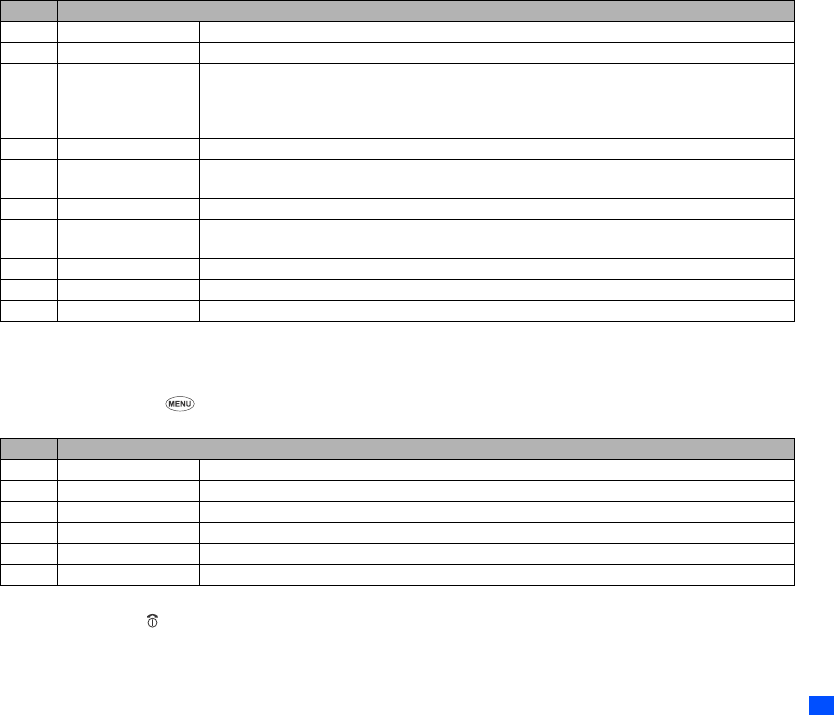
47
2Depending on the conditions, some options may be displayed in gray and not be available.
After taking picture
Camera Options menu
☛After taking a picture, press to display the Camera Options menu screen (after taking picture).
☛Press the appropriate key for the required option.
2Depending on the conditions, some options may be displayed in gray and not be available.
2When you have pressed to end the operation after accessing the Pictures, the display returns to the standby screen with the taken picture
stored in the Photo folder.
No. Camera Options menu
1 Single/Burst mode Switches the shooting mode to Single/Burst mode (serial shooting).
2 Shoot environment Sets the shooting environment to Standard, Person, Room, Sepia, Monochrome, or Darkness.
3Photo size
Sets the Photo size to Medium, Small, or Large.
2You cannot use the Zoom, Frame function and Burst mode when the Large is selected.
2When you display the Large size picture on your phone’s display, it is displayed in the smaller size
than Medium.
4 Image quality Sets the image quality to Super fine, Normal or Economy.
5Frame Enables to select whether to use a frame when taking pictures, and set the desired frame with which a
picture will be taken.
6 Self timer/cancel Enables to take a picture by using the self-timer.
7 Flicker control Enables to prevent flickers for when taking pictures under a fluorescent light by selecting the setting
from 50Hz and 60Hz.
8 Thumbnail view Sets how to display the pictures taken in the Burst mode to Thumbnail or Slide.
9 Other settings Enables to access the Light, Brightness and Zoom settings.
0Pictures Enables to access the Pictures under My data (see page 76).
No. Camera Options menu
1 Save current Saves the currently displayed picture.
2 Save all Saves the whole pictures (when pictures taken in the Burst mode).
3 Create message Sends the image file attaching to mail/MMS (see page 55).
4 Set as wallpaper Sets the picture as a Wallpaper.
5 Thumbnail view Sets how to display the pictures taken in the Burst mode to Thumbnail or Slide.
6Pictures Enables to access the Pictures under My data (see page 76).
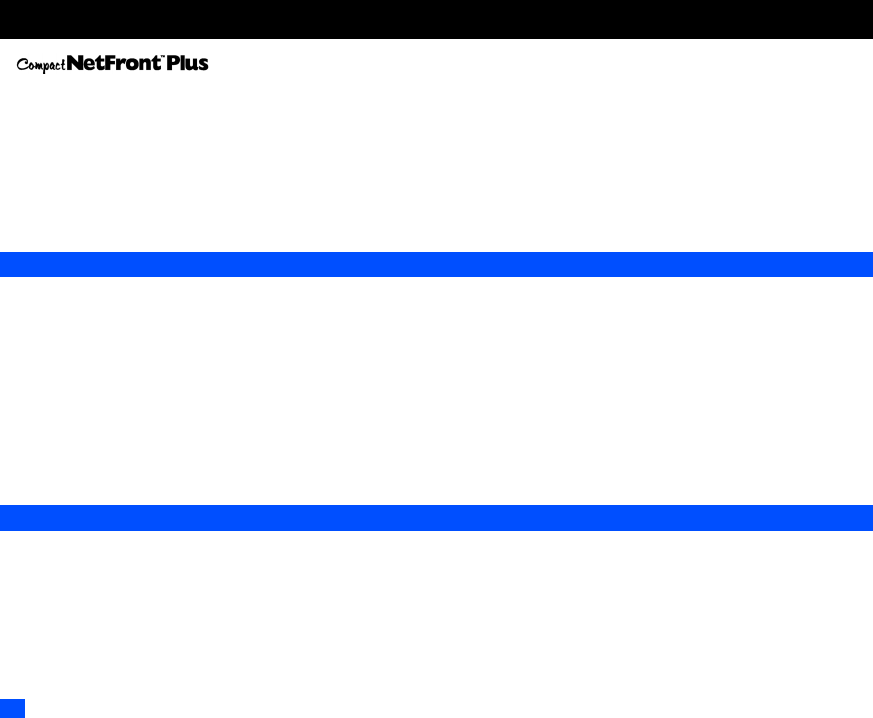
48
i-mode Facilities
Compact NetFront™ is a registered trademark or trademark of ACCESS CO., LTD. in Japan and selected countries worldwide.
Your phone enables you to access i-mode sites/services and also to send/receive i-mode messages. This section explains how to set up and use your
phone to access these i-mode facilities.
2If you leave your phone for a long time with the battery uncharged, the content of memory cannot be retained, and stored i-mode data may be lost.
Stored i-mode data:
•i-mode settings
•mail/MMS data
•bookmarks, etc.
About i-mode
Your phone is compatible with i-mode, which means you can use online services such as site (program) connection service, mail/MMS, and Internet
connection.
Site (Program) connection service
By simple key operations, you can use various sites provided by IPs (Information Providers).
Mail/MMS
This service enables you to send/receive mail/MMS not only to/from i-mode mobile phones but also via the Internet.
Internet connection
This service enables you to connect to the Internet using an i-mode mobile phone and access Internet homepages compatible with i-mode.
What can I download
Your phone supports the downloading of three different types of content:
•Melodies
•Wallpapers
•Animation (greeting)
What are Melodies?
Melodies are played when you receive a call or SMS/mail/MMS.
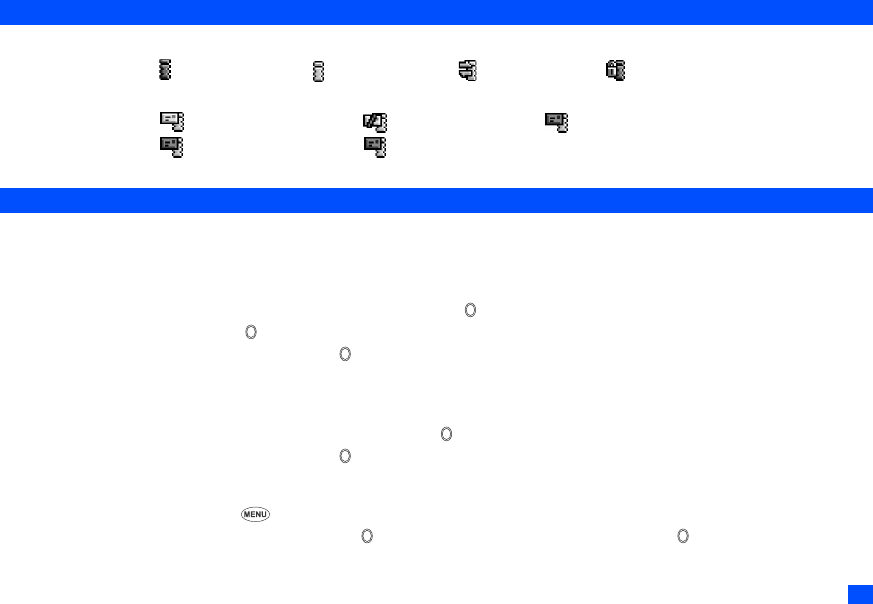
49
What are wallpapers?
Wallpaper is an image that is displayed as the background for your standby screen.
What are animations?
Animations are played when the phone is turned on. You can download them to your phone.
i-mode icons
The following i-mode icons are displayed in two locations of your phone’s display (see page viii):
• i-mode status icon- i-mode service area i-mode connected i-mode connecting i-mode locked
(gray) (yellow)
• mail/MMS icon - unread mail/MMS (beige) unread mail/MMS full mail on server (green)
MMS on server (blue) both mail and MMS on server (pink)
2While mail/MMS is being downloaded, the beige icon blinks.
i-mode quick start
The following procedures will help you start using your phone’s i-mode facilities straightaway. For more detailed procedures and information, please read
the rest of this section.
Accessing a new i-mode site
☛With the standby screen displayed, press Softkey 2, 5 and 1, then press .
☛Key in the site address, then press .
☛Use the ▲ and ▼ keys to highlight OK, then press .
Accessing a stored address
☛With the standby screen displayed, press Softkey 2, 5 and 2.
☛Use the ▲ and ▼ keys to highlight the required address, then press .
☛Use the ▲ and ▼ keys to highlight OK, then press .
Bookmarking a page
☛With a web page displayed, press .
☛Press the appropriate key for Add bookmark and press . Use the ▲ and ▼ keys to highlight OK then press . The page will be added to the
bookmark list.
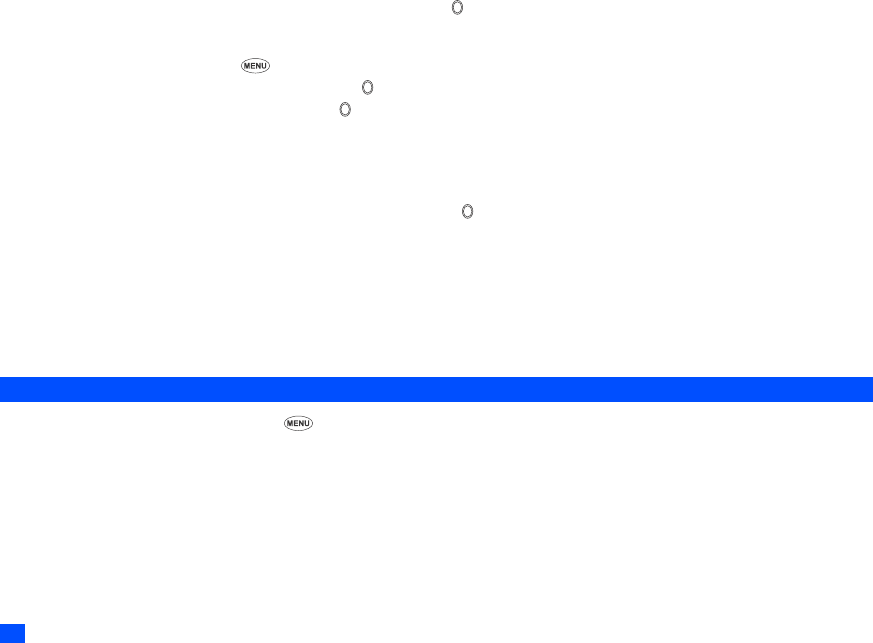
50
2Depending on the type of page you are viewing, the available browser menu options may vary.
Going to a bookmarked page
☛With the standby screen displayed, press Softkey 2 and 4.
☛Use the ▲ and ▼ keys to highlight the required bookmark, then press .
Saving a web page
☛With a web page displayed, press .
☛Press the appropriate key for the Save page and press .
☛Use the ▲ and ▼ keys to highlight OK, then press .
2Depending on the type of page you are viewing, the available browser menu options may vary.
Displaying a saved page
☛With the standby screen displayed, press Softkey 2 and 6.
☛Use the ▲ and ▼ keys to highlight the required saved page, then press .
Downloading a melody
☛Navigate to a page containing the melody you require.
Downloading images
2Images can be animations or standby screens (wallpapers).
☛Navigate to a page containing the image you wish to download.
i-mode settings
☛With the standby screen displayed, press 3 and 1 to display the i-mode Settings screen.
Ringer time
This option enables you to select the length of time your phone rings for when mail/MMS is received.
☛With the i-mode Settings screen displayed, press 1.
☛Key in a time between 3 and 10 seconds, then press Softkey 1.
/See also: “Text Entry” on page 31.
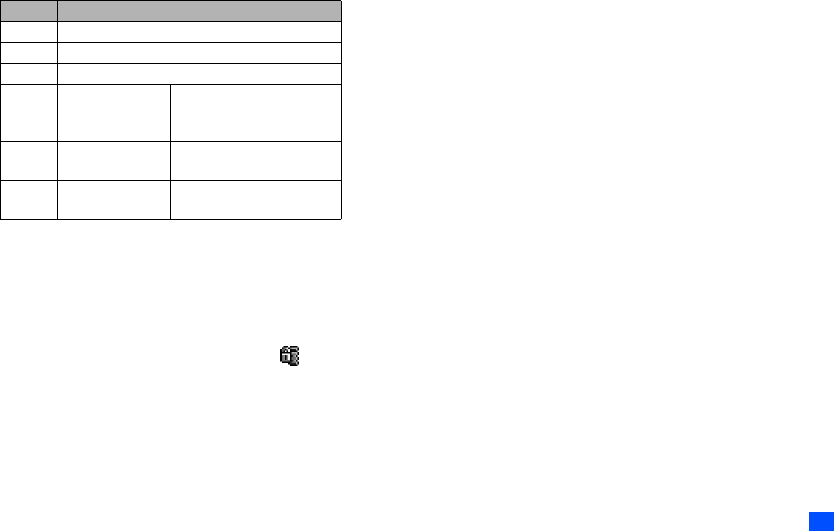
51
Connection number
This option enables you to select which connection number you use (Factory setting 1 = e-plus, Factory setting 2 = KPN, User setting) to connect to the
i-mode service.
2The two factory settings are fixed settings for connecting to specific operators, while the user setting can be changed.
☛With the i-mode Settings screen displayed, press 2.
☛Press the appropriate key for the required option.
☛Key in the Security code and press Softkey 1.
If you select the User setting, you will be offered the options shown in the following table. Press the appropriate key for the required option, and
key in the required information.
i-mode lock
If you choose to turn the i-mode lock on, you will not be able to connect to any i-mode services or send or receive mail/MMS.
☛With the i-mode Settings screen displayed, press 3.
☛Press 1 to activate or press 2 to deactivate the i-mode lock.
2You are prompted to enter the Security code to activate/deactivate the i-mode lock.
2When the i-mode lock is On, the i-mode lock icon ( ) is shown at the status icon area of the standby screen.
No. User setting Options
1 Access point
2 i-mode server (Gateway address)
3 Portal server (i-menu server)
4Mail
1 Mail server
2 2nd Mail server
3 Confirmation site
5User data 1 User name
2 Password
6Port No. 1 HTTP Port No.
2 SSL Port No.
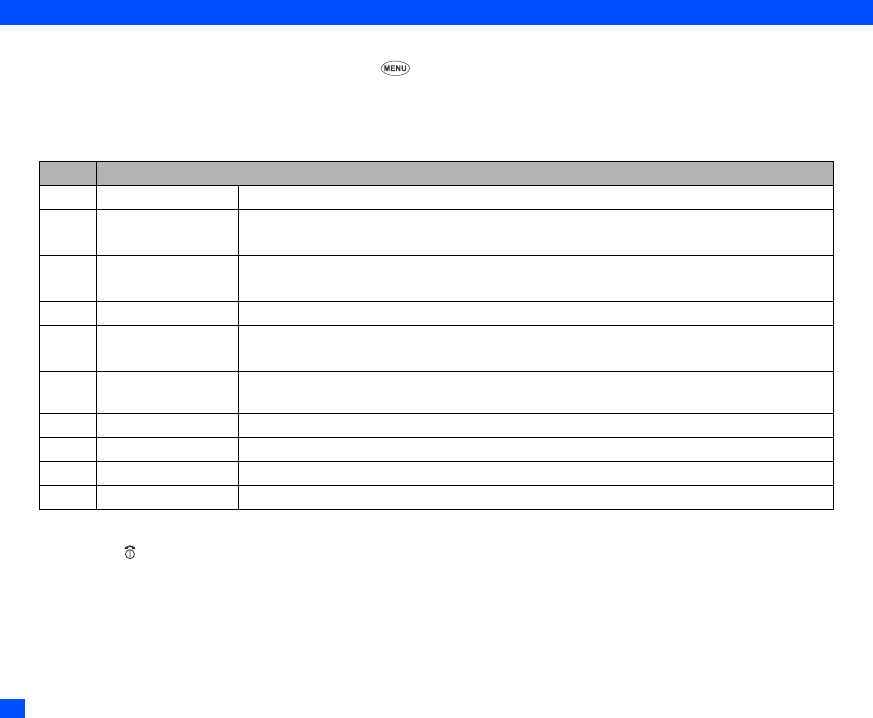
52
i-mode menu
☛With the standby screen displayed, press Softkey 2 to display the i-mode menu screen.
2You can also access the i-mode menu screen by pressing 3 and 2 from the standby screen.
i-Menu
☛With the i-mode menu screen displayed, press 1.
☛Press the relevant key to select the required option.
,When you agree to send private information (e.g. production serial no. and SIM no.) to the IPs via the Internet, it may be obtained by others.
2Pressing CLR or may not bring back the previous screen. Screen operations depend on the current screen content.
Mail
☛With the i-mode menu screen displayed, press 2 to display the Mail screen (see page 55).
SMS
☛With the i-mode menu screen displayed, press 3 to display the Message screen (see page 36).
No. i-Menu
1 Add bookmark Bookmarks the current page.
2 Bookmarks Displays the Bookmark list.
2This option is displayed only when one or more Bookmarks are registered.
3 Save image Saves an image on the current page.
2This option is displayed only when one or more images are displayed on the current page.
4 Save page Saves the current page.
5 Save phone # Saves the phone number displayed in the current page into the phonebook.
2This option is displayed only when one or more phone numbers are displayed on the current page.
6 Certificate info Displays the server certificate of the current page. This option is displayed only when the current page
is SSL page.
7 Go to webpage Enables you to enter URL or select one from a list (see “Go to webpage” on page 53).
8Reload Updates the data on the current page.
9 Page info Displays URL of the current page.
0 Compose mail Moves to the Compose mail screen. To the mail text, URL of the current page will be inserted.
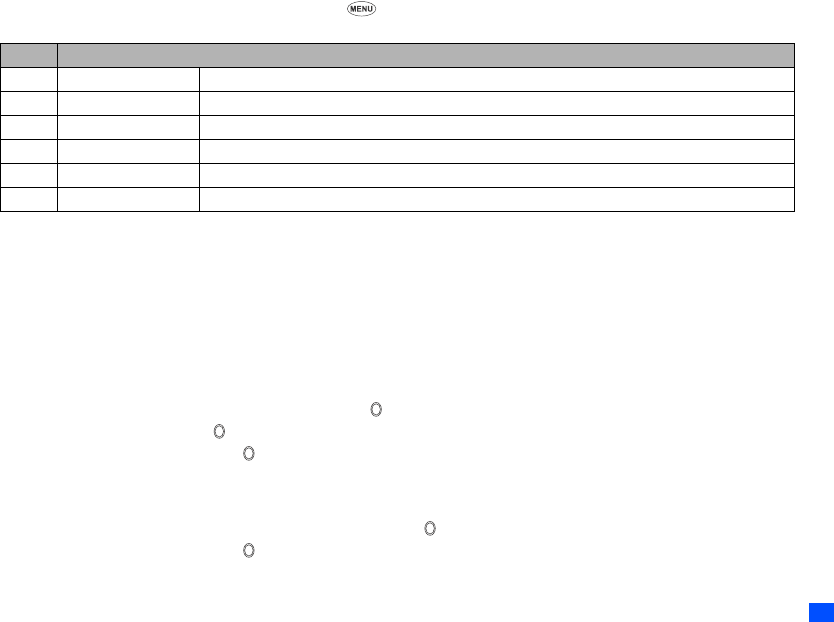
53
2If you press CLR to leave this menu, the i-mode menu screen will be re-displayed.
Bookmarks
This option will display a list of bookmarked web pages. These bookmarks can be copied, edited, deleted or used to open the original web page as follows.
☛With the i-mode menu screen displayed, press 4.
☛Use the ▲ and ▼ keys to highlight a bookmark then press .
☛Press the appropriate key for the required option.
2Depending on the type of page you received, some options may be displayed in gray and not be available.
Go to webpage
This option enables you to enter a specific web page address (URL) or select one from the history list, allowing you to visit a particular web page.
2Only web pages that are i-mode compatible will be displayed.
☛With the i-mode menu screen displayed, press 5.
Entering address
☛Press 1.
☛Use the ▲ and ▼ keys to highlight the address field and press .
☛Key in the required URL, then press .
☛Use the ▼ key to highlight OK and press .
Address history
☛Press 2.
☛Use the ▲ and ▼ keys to highlight the required URL address and press .
☛Use the ▼ key to highlight OK and press .
No. Bookmark Options
1Open Displays the highlighted bookmarked page.
2 Copy address Copies the highlighted bookmarked address, so it can be edited.
3 Edit title Edits the title of the highlighted Bookmark.
4Compose mail Moves to the Compose mail screen. To the mail text, the URL of the highlighted Bookmark is inserted.
5 Delete one Deletes the highlighted Bookmark.
6 Delete all Deletes all the Bookmarks.
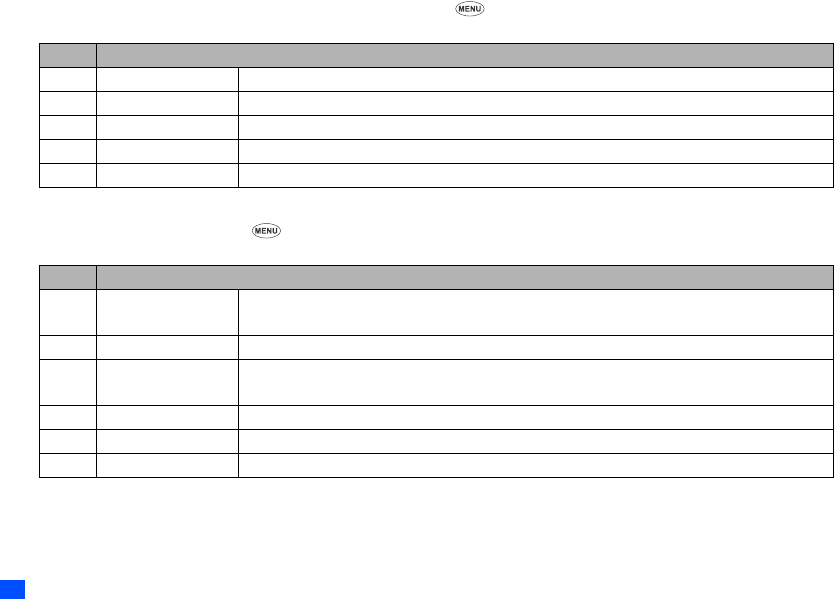
54
Back
☛Press 0 to display the i-mode menu screen.
Saved pages
2Saved pages are stored on your phone which means you can view them without making a connection to the i-mode service.
☛With the i-mode menu screen displayed, press 6.
☛Use the ▲ and ▼ keys to highlight the required saved page and press .
☛Press the appropriate key for the required option.
2Protected pages cannot be deleted.
☛With a saved page displayed, press .
☛Press the appropriate key for the required option.
2Protected pages cannot be deleted.
Settings
☛With the i-mode menu screen displayed, press 7 to display the i-mode user settings menu screen (see page 63).
No. Saved pages list Options menu
1Open Opens the saved page.
2 Edit title Enables to edit the title of the highlighted page.
3 Protect On/Off Protects or unprotects the saved page.
4 Delete one Deletes the highlighted saved page.
5 Delete all Deletes all the saved pages.
No. Saved page view Options menu
1 Save image Saves an image on the current page.
2This options is displayed only when one or more images are displayed on the current page.
2 Edit title Enables you to edit the title of the current page.
3 Certificate info Displays the server certificate of the current page.
2This options is displayed only when the current page is SSL page.
4 Page info Displays the URL of the current page.
5 Protect On/Off Protects or unprotects the current page.
6 Delete Deletes the displayed saved page.
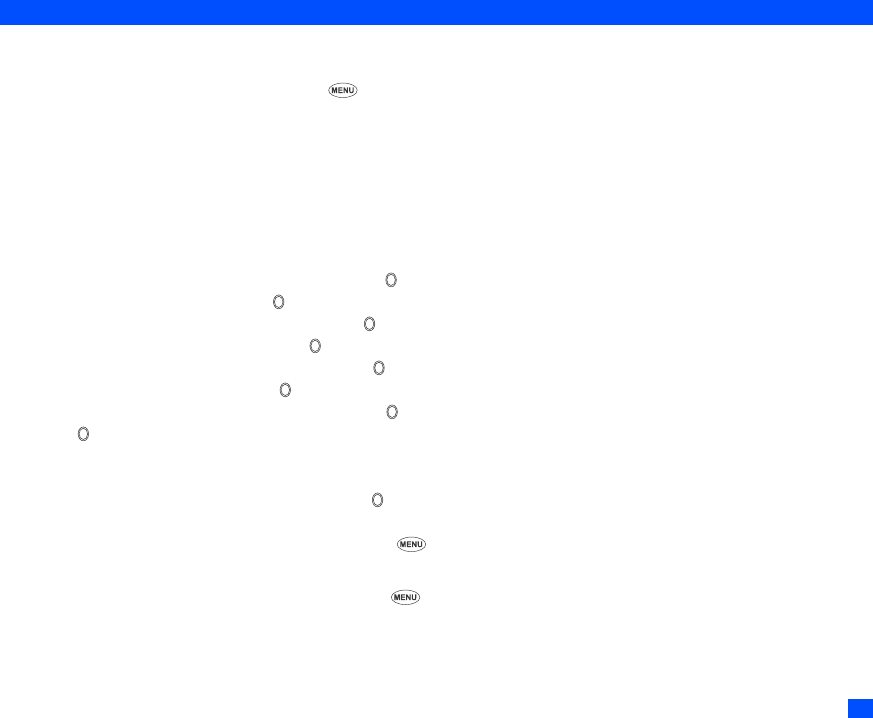
55
Mail menu
This menu enables you to use the mail facility.
☛With the standby screen displayed, press Softkey 1 to display the Mail screen.
2You can also access the Mail screen by pressing 3 2 and 2, or Softkey 2 and 2 from the standby screen.
2The available options differ depending on the operators.
2When an error has occurred in sending mail, it is saved in the Draft as unsent mail.
2The same mail can be sent to up to five addresses.
2If you wish to send saved mail, see Draft (page 62).
Compose mail
This option enables you to compose, send and save mail.
☛With the Mail screen displayed, press 1.
☛Use the ▲ and ▼ keys to highlight the To field, then press .
☛Key in the required address, then press .
☛Use the ▼ key to highlight the Subject field, then press .
☛Key in the subject of the message, then press .
☛Use the ▼ key to highlight the Message field, then press .
☛Key in the required message, then press .
☛Use the ▼ key to highlight the Attachment field, then press .
☛Press to display the My data screen. Then, select the desired file to be attached.
/See also: “My data” on page 76.
2The file can be attached up to 100K bytes depending on the operators.
☛Use the ▼ key to highlight the Send or Save, then press .
/See also: “Text Entry” on page 31.
2You can access the Message edit Options menu by pressing from the text entry screen (see page 41).
Editing a composed mail
☛With the Compose mail or Edit mail screen displayed, press .
☛Press the appropriate key for the required option.
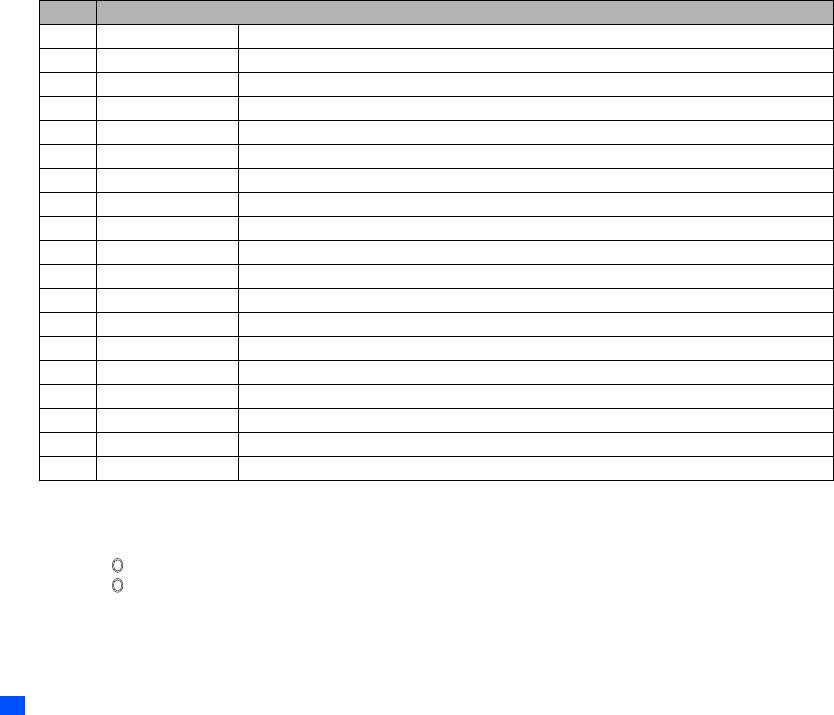
56
2Depending on the selected field, the menu number and available options may vary.
2Depending on the selected field, some options may be displayed in gray and not be available
☛Use the ▲ and ▼ keys to highlight Send or Save.
If you press with Send highlighted, your message will be sent and the Mail screen will be re-displayed.
If you press with Save highlighted, your message will be saved as a draft (see page 62).
Compose MMS
This option enables you to compose, send and save MMS.
☛With the Mail screen displayed, press 2.
No. Edit menu
–Send Sends the mail.
–Save Saves the mail being edited in the Draft (“Draft” on page 62).
–Play melody Plays the attached melody.
–Attach image Attaches an image file to the mail.
–Attach melody Attaches a melody file to the mail.
– Delete attachment Deletes the attached file(s).
– Display image Displays the attached image file.
– Open phonebk. Adds the destination address directly from the phonebook.
–Add To Adds the destination address.
–Add Cc Adds the Cc address.
–Add Bcc Adds the Bcc address.
– Change to To Changes Cc or Bcc to To.
– Change to Cc Changes To or Bcc to Cc.
– Change to Bcc Changes To or Cc to Bcc.
– Del. Address Deletes an address.
– Attach header Attaches a stored opening sentence at the start of the text.
– Attach sign. Attaches a stored signature at the end of the text.
– Del. message Deletes the message of the mail being edited.
– Del. mail Deletes the new mail currently created.
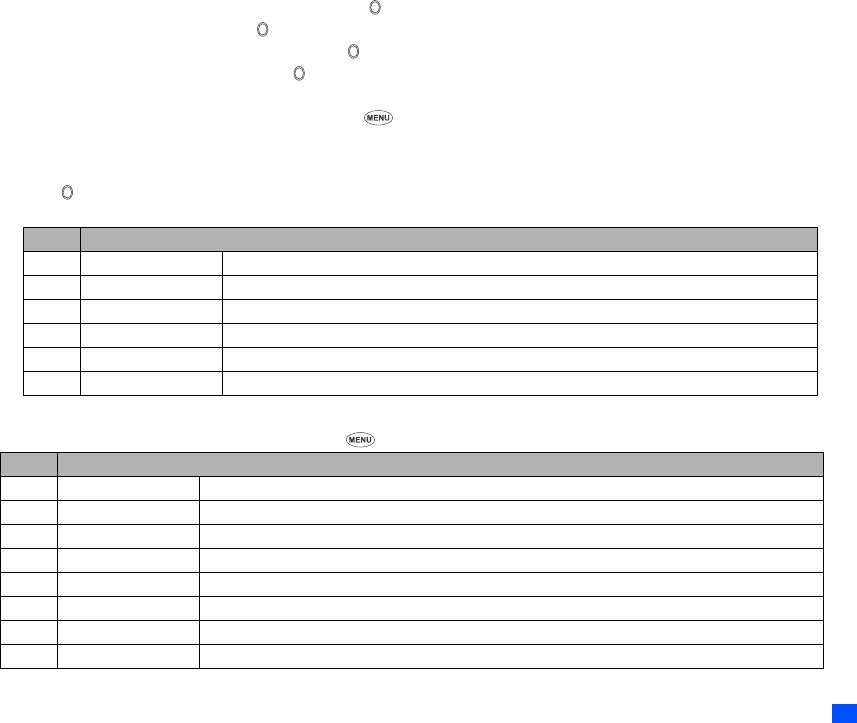
57
☛Use the ▲ and ▼ keys to highlight the To field, then press .
☛Key in the required address, then press .
☛Use the ▼ key to highlight the Subject field, then press .
☛Key in the subject of the message, then press .
/See also: “Text Entry” on page 31.
2You can access the Message edit Options menu by pressing from the text entry screen (see page 41).
Creating new SMIL
☛Use the ▼ key to highlight SMIL.
☛Press to display SMIL Compose menu screen (initial).
☛Press the appropriate key for the required option.
SMIL Compose menu options
You can access SMIL Compose menu options by pressing from the SMIL screen.
No. Compose menu Options (initial)
1Add text Adds new text data to the SMIL.
2 Add image Adds an image file to the SMIL.
3Add audio Adds a sound file to the SMIL.
4 Preview Displays the created SMIL.
5 Background colour Changes the background colour of the SMIL.
6Options Sets the slide playback time.
No. Compose menu Options (ALL)
–Add text Adds new text data in the text field on the slide.
– Remove text Deletes the text data in the text field on the slide.
– Add image Adds an image file in the image field on the slide.
– Remove image Deletes the image file in the image field on the slide.
–Add audio Adds a sound file in the sound field on the slide.
– Remove audio Deletes the sound file in the sound field on the slide.
– Preview Displays the created slides in order from the beginning at the preset playback time for each.
– Add slide Adds a new slide after the currently displayed slide.
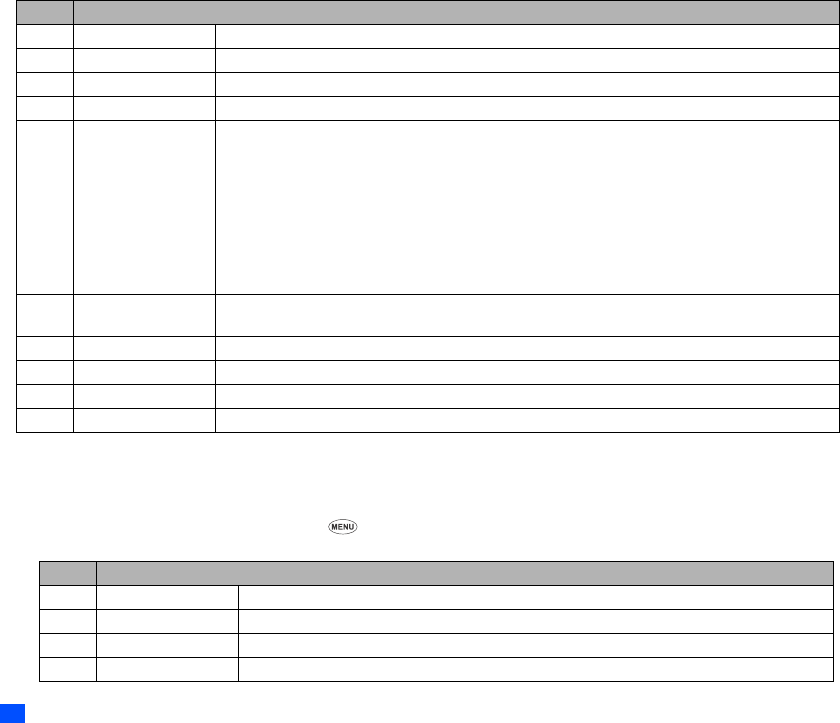
58
2Depending on the conditions, the menu number and available options may vary.
2Depending on the conditions, some options may be displayed in gray and not be available.
Editing a composed MMS
☛With the Compose MMS screen displayed, press .
☛Press the appropriate key for the required option.
– Insert slide Inserts a new slide just before the currently displayed slide.
– Remove slide Deletes the currently displayed slide.
–Text colour Enables to select the Text colour from the 16 different colours
– Background colour Enables to select the Background colour from the 16 different colours.
–Set Fit mode
Enables to select the size in which the image is displayed.
Hidden: Displays the image in the actual size.
Fill: Displays the image in the reduced size so that the height and width fit into the image
display area.
Meet (Default): Displays the image in the reduced size so that the longer side of the height or width fits
the corresponding side of the image display area.
Slice: Displays the image in the reduced size so that the shorter side of the height or width fits
the corresponding side of the image display area.
–Options Displays the sub menu. You can set the length of time for playing back slides and showing texts etc. by
using this option.
Change region size Enables to change the region size by using the [UP] and [DOWN] keys.
– Swap image/text Enables to swap the place of image field and text field on the slide.
Previous slide Displays the previous slide.
Next slide Displays the next slide.
No. Edit menu
–Send Sends the MMS.
–Save Saves the MMS being edited in the Draft (“Draft” on page 62).
– Open phonebk. Adds the destination address directly from the phonebook.
–Add To Adds the destination address.
No. Compose menu Options (ALL) (Continued)
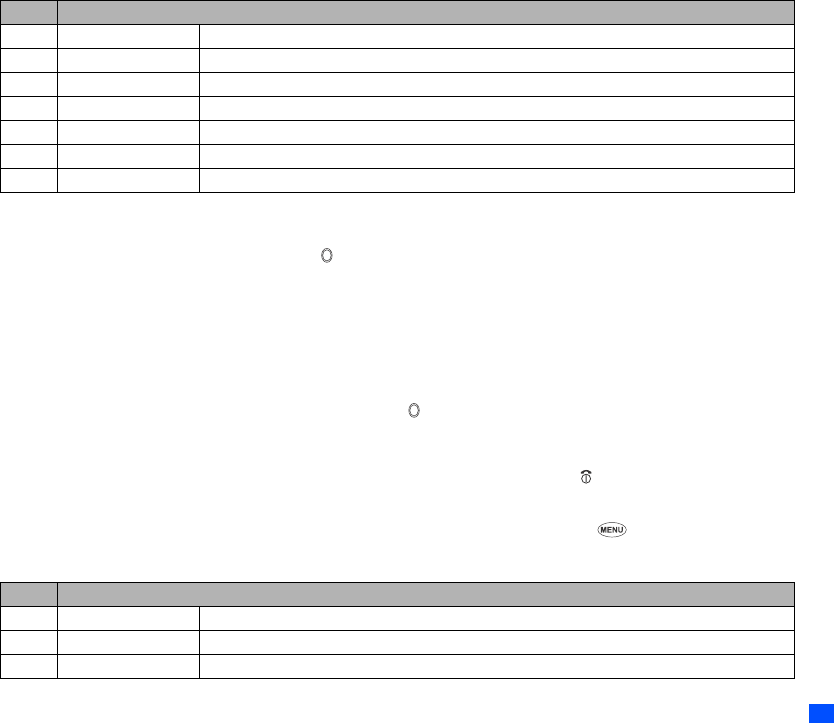
59
2Depending on the conditions, the menu number and available options may vary.
2Depending on the conditions, some options may be displayed in gray and not be available.
☛Press the ▼ key to highlight Send or Save, then press .
Inbox
This option enables you to read and process your incoming mail/MMS, as follows.
2When the Inbox reaches its maximum limit, a new mail/MMS will overwrite an old, read mail/MMS.
Reading mail/MMS
☛With the Mail screen displayed, press 3.
☛Use the ▲ and ▼ keys to highlight the required message, then press to read it.
☛Use the ▲ and ▼ keys to scroll the mail/MMS.
☛Use the and keys to view the previous or next mail/MMS respectively.
☛When you have finished reading your mail/MMS, press CLR to return to the Inbox mail list, or press to return to the standby screen.
Processing mail/MMS
☛With the Inbox mail list displayed, use the ▲ and ▼ keys to highlight the required mail/MMS and press . The Inbox filter/deletion menu will
be displayed.
☛Press the appropriate key for the required option.
–Add Cc Adds the Cc address.
–Add Bcc Adds the Bcc address.
– Changes to To Changes Cc or Bcc to To.
– Changes to Cc Changes To or Bcc to Cc.
– Changes to Bcc Changes To or Cc to Bcc.
– Del. address Deletes an address.
–Del. mail Deletes the MMS being edited.
No. Inbox menu Options
1Show all Displays all the received mails/MMS.
2Show unread Displays only the unread mails/MMS.
3Show read Displays only the read mails/MMS.
No. Edit menu (Continued)
▼
▼
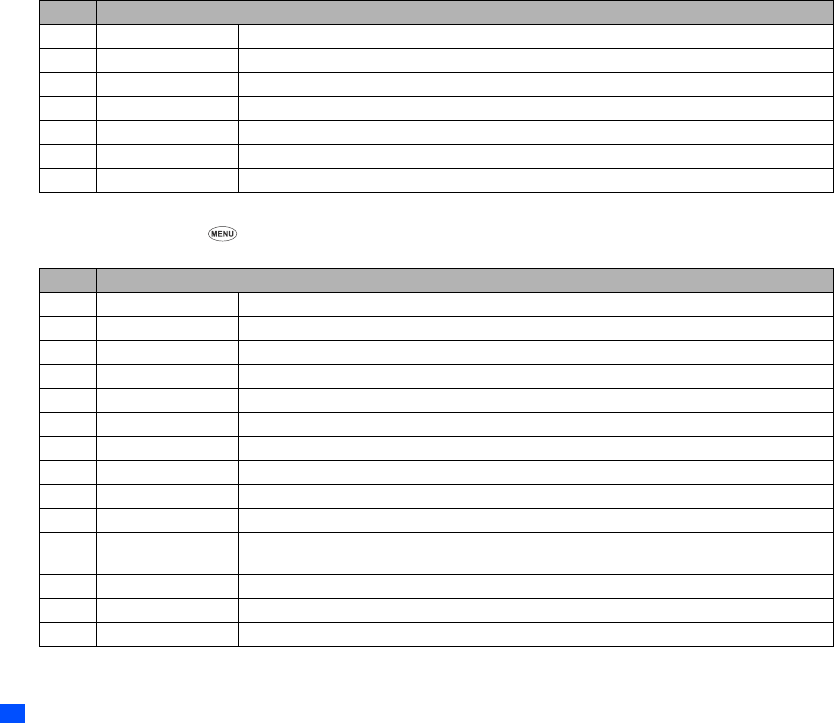
60
2Depending on the type of mail you received, some options may be displayed in gray and not be available.
☛With a mail displayed, press .
☛Press the appropriate key for the required option.
2Depending on the conditions, the menu number and available options may vary.
4 Show protected Displays only the protected mails/MMS.
5 Title sort Sorts the received mails/MMS by title.
6 Address sort Sorts the received mails/MMS by address.
7 Date sort Sorts the received mails/MMS by date.
8 Delete one Deletes the currently selected mail/MMS.
9 Delete read mail Deletes all the read mails except protected mails/MMS.
0 Delete all Deletes all the mails/MMS.
No. Inbox details Options
–Reply Replies to the received mail/MMS.
– Reply quoted Replies to the received mail quoted.
– Reply all Replies to all the received mails/MMS.
– Reply quoted all Replies to all the received mails quoted.
–Forward Forwards the received mail/MMS.
– Protect On/Off Protects or unprotects the received mail/MMS.
– Copy message Enables to copy the message text.
– Copy subject Enables to copy the desired subject text.
– Copy address Enables to copy the desired address.
– Save address Saves the address of the sender into the phonebook.
– Save phone # Saves the phone number and mail address contained in the text of the received mail/MMS into the
phonebook.
– Save melody Saves the melody attached to the received mail/MMS.
– Save attachment Saves the attached melody/image file.
– Delete Deletes the received mail/MMS you are viewing.
No. Inbox menu Options (Continued)
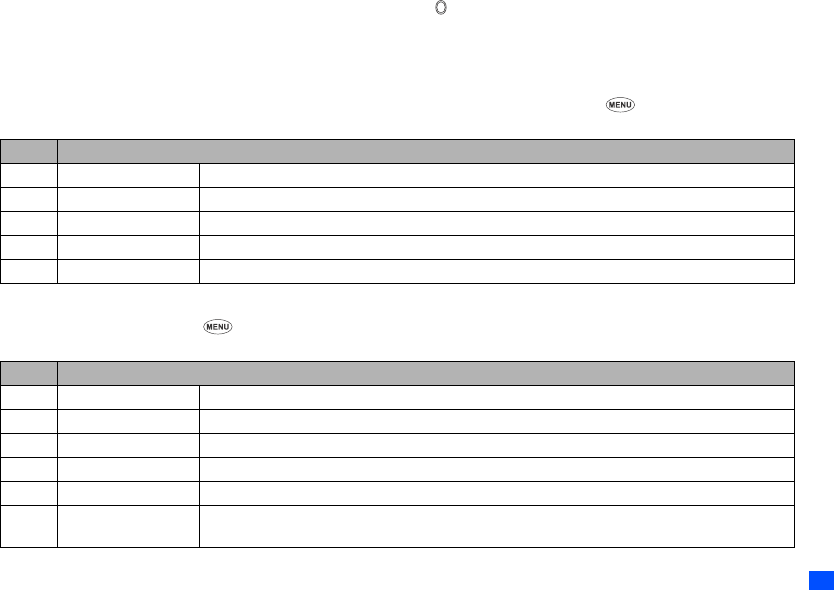
61
2Depending on the conditions, some options may be displayed in gray and not be available.
Sent mail
This option enables you to read and process the mails/MMS you have sent and saved.
Reading Sent mail/MMS
☛With the Mail screen displayed, press 4.
☛Use the ▲ and ▼ keys to highlight the required mail/MMS and then press to read it.
☛Use the ▲ and ▼ keys to scroll through the mail/MMS.
☛Use the and keys to view the previous or next mail/MMS respectively.
Processing Sent mail/MMS
☛With the sent mail list displayed, use the ▲ and ▼ keys to highlight the required mail/MMS, then press .
☛Press the appropriate key for the required option.
2Even if you select Delete all, protected and unread mail will not be deleted.
☛With a mail/MMS displayed, press .
☛Press the appropriate key for the required option.
No. Sent mail list Options
1 Title sort Sorts the sent mails/MMS by title.
2 Address sort Sorts the sent mails/MMS by address.
3 Date sort Sorts the sent mails/MMS by date.
4 Delete one Deletes the selected mail/MMS.
5 Delete all Deletes all the sent mails/MMS.
No. Sent mail details Options
1 Re-edit Enables to re-edit a sent mail/MMS.
2Protect On/Off Protects or unprotects a sent mail/MMS.
3 Copy message Enables to copy the message text.
4 Copy subject Enables to copy the subject text.
5 Save address Saves the address of the sender into the phonebook.
6 Save phone # Saves the phone number and mail address contained in the text of the received mail into the
phonebook.
▼
▼
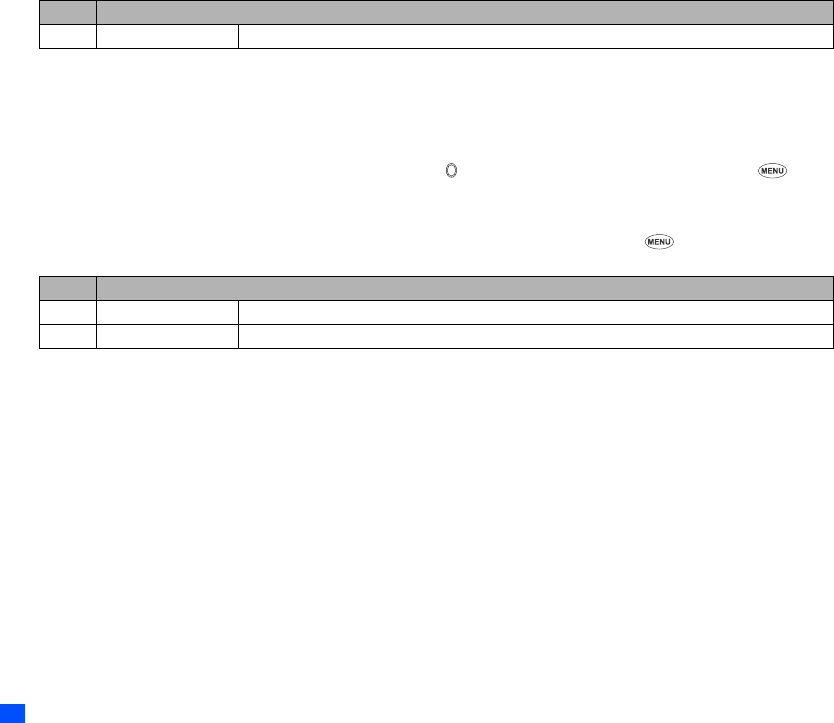
62
Draft
This option enables you to delete or process mails/MMS you have created and saved but not sent.
Editing a Draft mail/MMS
☛With the Mail screen displayed, press 5.
☛Use the ▲ and ▼ keys to highlight the required mail/MMS, then press to edit it (see “Compose mail” on page 55) or press to display the
deletion menu.
Deleting a Draft mail/MMS
☛With the Draft mail list displayed, use the ▲ and ▼ keys to highlight the required mail/MMS, then press .
☛Press the appropriate key for the required option.
Check new mail
This option gives you access to unread received mail/MMS stocked in the server.
☛With the Mail screen displayed, press 6.
☛Press the appropriate key for the required option. The new mail/MMS will be checked and the result will be displayed.
2When Auto reception is set to On (see page 65), your phone will automatically receive mail (see page 65). If Auto reception is set to Off, this option
will cause any new mail to be downloaded from your current i-mode service provider. If your Inbox becomes full, new mail will overwrite old mail that
has already been read.
Mail settings
This option gives you access to the Mail settings menu (see page 64).
☛With the Mail screen displayed, press 7.
Back
This option returns you to the i-mode menu (see page 52).
☛With the Mail screen displayed, press 0.
7 Delete Deletes the sent mail you are viewing.
No. Delete list Options
1 Delete one Deletes the selected mail/MMS.
2 Delete all Deletes all the draft mails/MMS.
No. Sent mail details Options
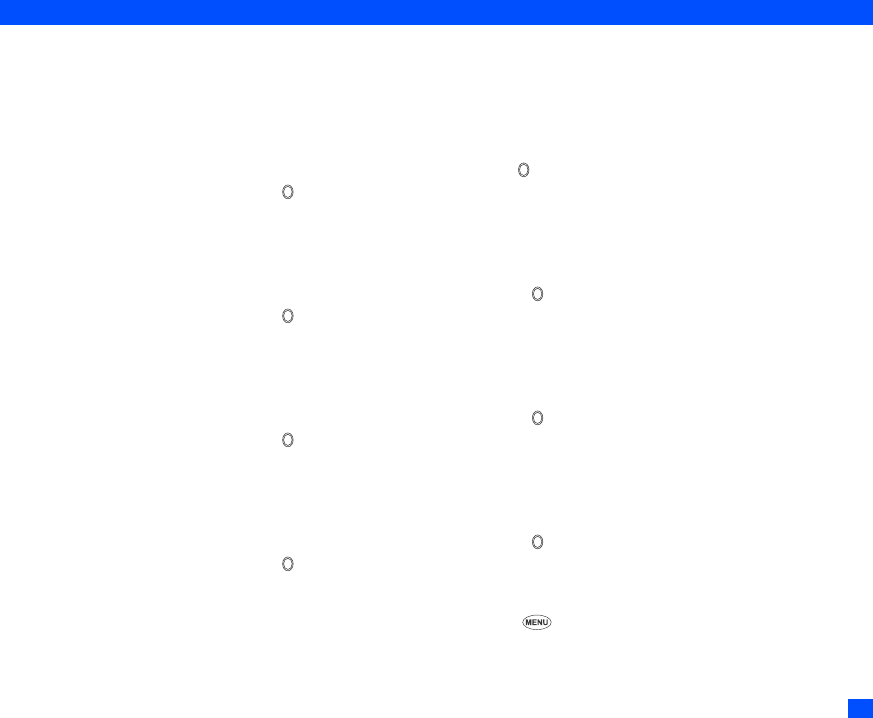
63
i-mode user settings
This menu enables you to set up the way your phone uses and displays web pages.
☛With the standby screen displayed, press Softkey 2 and 7 before performing the following procedures.
Set time out
This option enables you to set the time after which the connection will be broken if there has been no activity (60 seconds/90 seconds/Disabled).
☛Press 1.
☛Use the ▲ and ▼ keys to highlight the circle next to the required time, then press to select it.
☛Use the ▼ key to highlight OK and press .
Show tables
This option enables you to decide if your phone will display tables contained in a web page.
☛Press 2.
☛Use the ▲ and ▼ keys to highlight the circle next to the required setting, then press to select it.
☛Use the ▼ key to highlight OK and press .
Load images
This option enables you to decide if your phone will load images contained on a web page.
☛Press 3.
☛Use the ▲ and ▼ keys to highlight the circle next to the required setting, then press to select it.
☛Use the ▼ key to highlight OK and press .
Wrap text
This option enables you to decide if your phone will display text as it is on the web page or wrap it to fit your phone’s screen.
☛Press 4.
☛Use the ▲ and ▼ keys to highlight the circle next to the required setting, then press to select it.
☛Use the ▼ key to highlight OK and press .
Certificates
☛Press 5 and use the ▲ and ▼ keys to highlight the required certificate, then press .
Displaying the certificate info
☛Press 1.

64
Setting the Certificate
☛Press 2 to switch the selected certificate to valid/invalid.
Send terminal info
,When you agree to send private information (e.g. production serial No. and SIM No.) to the IPs via the Internet, it may be obtained by others.
☛Press 6.
☛Use the ▲ and ▼ keys to highlight the circle next to the required setting, then press to select it.
☛Use the ▼ key to highlight OK and press .
Check settings
This option displays all the options from this menu with their current settings.
☛Press 7.
Back
This option returns you to the i-mode menu (see page 52).
☛Press 0 to return to the i-mode menu screen.
Mail settings
☛With the standby screen displayed, press Softkey 1 and 7 before performing the following procedures.
Edit header
This option enables you to edit the text that can be added to the start of mail. You can also decide to auto attach this text to the start of all mails.
☛Press 1.
☛Press to set the Auto attach to On or Off (a ✔ in the box means Auto attach is turned on).
☛Use the ▼ key to highlight the header text box, then press .
☛Key in the required header text and press .
☛Use the ▼ key to highlight OK and press .
Edit signature
This option enables you to edit the text that can be added to the end of mail. You can also decide to auto attach this text to the end of all mails.
☛Press 2.
☛Press to set the Auto attach to On or Off (a ✔ in the box means Auto attach is turned on).
☛Use the ▼ key to highlight the Signature text box, then press .

65
☛Key in the required signature text and press .
☛Use the ▼ key to highlight OK and press .
Reply marker
This option enables you to edit the symbol that marks reply text.
☛Press 3 and .
☛Key in the required reply marker symbol and press .
☛Use the ▼ key to highlight OK and press .
Auto play
This option enables you to playback mail attachment and MMS automatically.
☛Press 4.
☛Use the ▲ and ▼ keys to select the required setting and press (a ✔ in the box means Auto play is turned on).
☛Use the ▼ key to highlight OK and press .
Auto reception
This option enables you to set whether or not to automatically receive mail.
2With Auto-reception set to On, your phone will automatically receive mail. If it is Off, you will have to manually retrieve your mail from your i-mode
service provider (see “Check new mail” on page 62).
☛Press 5.
☛Use the ▲ and ▼ keys to select the required setting and press (a ✔ in the box means Auto reception is turned on).
☛Use the ▼ key to highlight OK and press .
Receive attachment
This option enables you to receive attached Image and MIDI files.
☛Press 6.
☛Use the ▲ and ▼ keys to select the required setting and press (a ✔ in the box means Receiving attachment is turned on).
☛Use the ▼ key to highlight OK and press .
Attachment data
This options enables you to receive attached MFi file.
☛Press 7.
☛Use the ▲ and ▼ keys to highlight the circle next to the required setting and press .
☛Use the ▼ key to highlight OK and press .
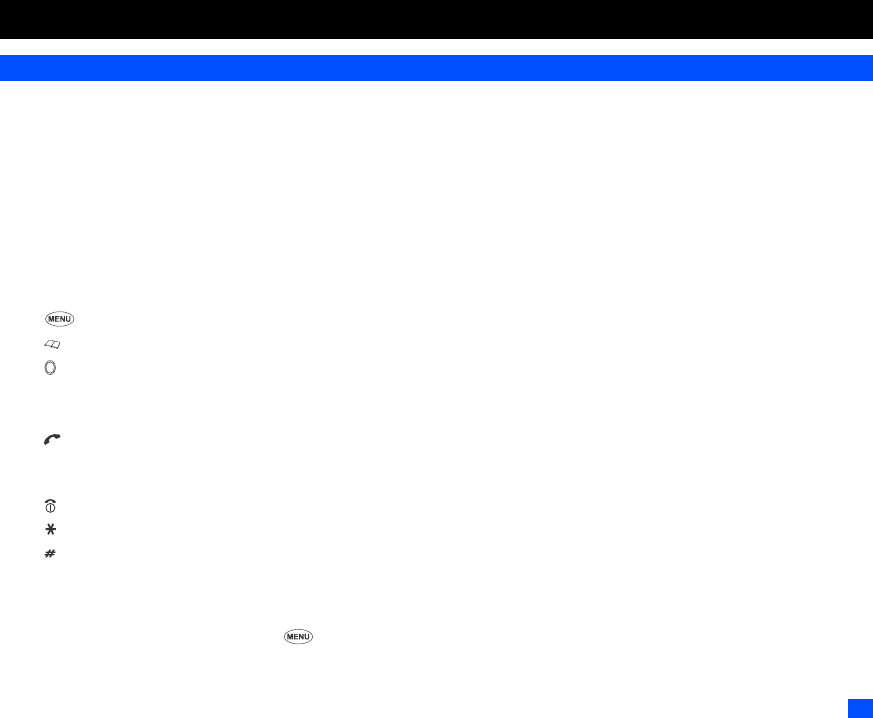
67
Accessory
Calculator
You can perform addition, subtraction, multiplication and division with the calculator function. It also has a memory function. The calculator can display
a result of up to 9 digits.
If a calculation results in a number exceeding the maximum, the screen displays error in the calculation field.
Calculator Key Assignment
For calculator function, the keys are assigned different functions. The following shows the key assignment:
2The calculator can display a result of up to 9 digits. If a calculation results in a number greater than the above maximum, the screen displays error.
Activating the Calculator
☛With the standby screen displayed, press 8 and 1 to display the Calculator.
key: Addition (+)
key: Subtraction (–)
▲ key: Multiplication (×)
▼ key: Division (÷)
key: Square Root (√)
key: Percent (%)
key: Inversion
Softkey 1:Memory Recall (2
nd)/Memory Cancel
Softkey 2: Memory Addition (2nd)/Memory Store
key: Equals to (=)
CLR key: Delete digit
(Held) All clear
key: Exit calculator
key: Sign inversion (±)
key: Decimal Point (.)
▼
▼

68
Calculation
Calculating
To calculate using the calculator, for example 52+37:
☛Key in 52.
☛Press the key.
☛Key in 37.
☛Press .
The answer 89 will be displayed in the calculation field.
Calculating using the temporary memory
To calculate using the temporary memory for example 5 x (25 - 5):
☛Key in 25.
☛Press the key.
☛Key in 5.
☛Press .
The answer 20 will be displayed in the calculation field.
☛Press Softkey 2 to add the displayed number into memory.
☛Key in 5.
☛Press the ▲ key.
☛Press Softkey 1.
20 will be displayed in the field.
2Pressing Softkey 1 again will clear the memory.
☛Press .
The answer 100 will be displayed in the calculation field.
▼
▼

69
Clock alarm
This feature enables you to switch the Clock alarm On/Off and to set the time, repetition and alarm tone.
Setting the alarm to On
☛With the standby screen displayed, press 8 and 2 to display the Clock alarm screen.
☛Press 1 to activate or 2 to deactivate the Clock alarm.
2Even if the phone has been switched off, the phone automatically switches itself on and sounds the alarm at the specified time if the alarm is set to On.
Clock alarm setting
☛With the Clock alarm screen displayed, press 1. The Set alarm screen will be displayed.
Setting the Alarm time
☛With the Set alarm screen displayed, press 1 to display the Alarm time screen.
☛Key in the required time, then press Softkey 1.
Setting the repetition
☛With the Set alarm screen displayed, press 2 to display the Repeat screen.
☛Press the appropriate key for the required option.
• If you select 3, the Day of the week screen will be displayed. Press the appropriate key for the required day, then press Softkey 1 to save the
setting.
2You can select more than one day of the week at the same time.
2You can deactivate the selected day by pressing the appropriate key again.
Setting the alarm tone
☛With the Set alarm screen displayed, press 3 to display the list screen that includes the currently set melody.
☛Use the ▲ and ▼ keys to highlight the desired melody, then press .
/See also: “Sounds” on page 77.
Setting the alarm tone volume
☛With the Set alarm screen displayed, press 4 to display the Volume slider.
☛Use the ▲ and ▼ keys, or press the required number key to set the alarm tone volume, then press Softkey 1.
Adding the text to be displayed accompanying the alarm
☛With the Set alarm screen displayed, press 5 to display the Enter alarm text screen.

70
☛Key in the desired text, then press .
Setting the alarm data input
☛Once the Clock alarm setting has been completed, press Softkey 1 to save the input alarm data.
2If you do not perform the above operation, set data will not be updated.
Resetting the alarm
☛With the Clock alarm screen displayed, press 2.
Scheduler
The Scheduler enables you to enter reminders and appointments for particular time and dates.
☛With the standby screen displayed, press 8 and 3 before performing the following procedures.
The Scheduler will be displayed, showing either a weekly or monthly view (according to how the Scheduler was left when it was last used) with
today’s date highlighted.
Making an entry in the scheduler
☛Press to display the day’s schedule list screen (if any).
☛Press Softkey 1 to display the Add new screen.
Setting the date & time
☛With the Add new screen displayed, press 1 to display the Date & Time screen.
☛Use the ▲ and ▼ keys to highlight the Year field and key in the year (if necessary).
☛Use the ▲ and ▼ keys to highlight the Month field and key in the month (if necessary).
☛Use the ▲ and ▼ keys to highlight the Day field and key in the day (if necessary).
☛Use the ▲ and ▼ keys to highlight the Time field and key in the time of schedule event, then press Softkey 1.
2Only the 24 hour format can be used for time entry for a scheduled event.
Description
☛With the Add new screen displayed, press 2 to display the Description screen.
☛Key in a description of the scheduled event, then press .
Setting Reminder
☛With the Add new screen displayed, press 3 to display the Reminder screen.
☛Press 1 to activate or 2 to deactivate the Reminder.

71
Setting Repeat
☛With the Add new screen displayed, press 4 to display the Repeat screen.
☛Press the appropriate key for the required option.
Setting the Melody
☛With the Add new screen displayed, press 5 to display the list screen that includes the currently set melody.
☛Use the ▲ and ▼ keys to highlight the desired Reminder tone, then press .
2The Reminder tone will sound at the Ringer volume set to the current Phone mode.
/See also: “Sounds” on page 77.
Setting the Security level (Private/Public)
☛With the Add new screen displayed, press 6 to display the Security level screen.
☛Press 1 to select the Public or 2 to select the Private.
Setting the scheduler data input
☛Once the Scheduler setting has been completed, press Softkey 1 to save the schedule input data.
☛Press Softkey 1 to confirm.
2If you do not perform the above operation, set data will not be updated.
Viewing the scheduled events
☛With the Scheduler displayed, press Softkey 1 to display the schedule for the previous month/week or press Softkey 2 to display the schedule
for the next month/week.
☛Use the ▲ and ▼ keys to display the previous or next day until the required date is highlighted.
▼
▼
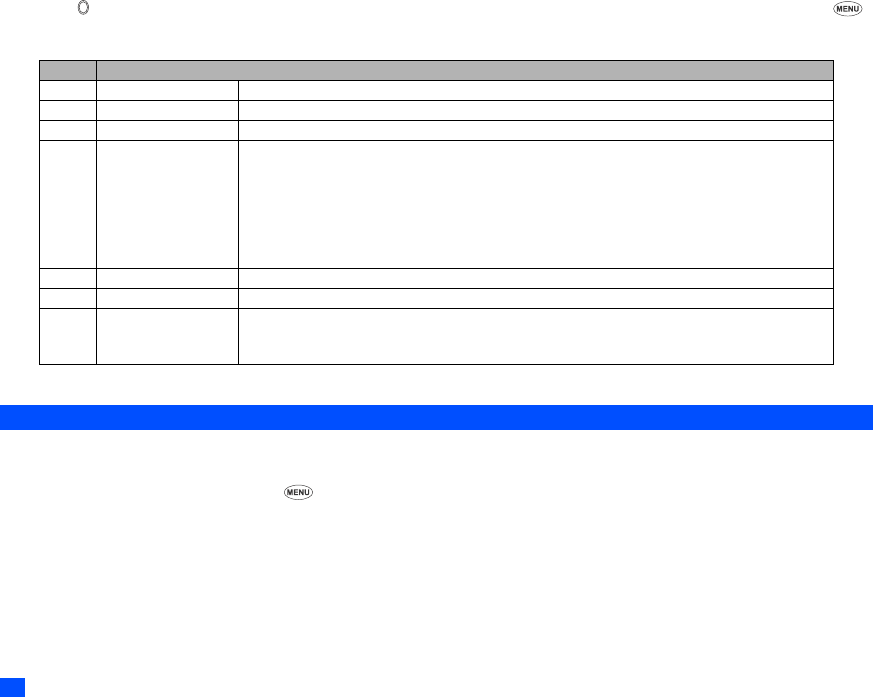
72
Scheduler Options menu
☛Press to display the highlighted day’s schedules (if any). Use the ▲ and ▼ keys to highlight the required scheduled event, and press .
The Scheduler Options menu will be displayed.
☛Press the appropriate key for the required option.
2Depending on the conditions, some options may be displayed in gray and not be available.
ToDo list
This feature allows you to set up to 100 ToDo tasks that should be finished by a certain date. You can choose to display either all ToDo tasks, or those
just finished or unfinished. Each task is identified by a description (of up to 32 characters) and its start/due date.
☛With the standby screen displayed, press 8 and 4 to display the ToDo list screen before performing the following procedures.
Creating a ToDo task
☛If there are no ToDo tasks listed, press Softkey 1. The ToDo editing screen will be displayed showing the Start date, Due date, Status, and
Description.
2If there are no ToDo tasks stored, you will be prompted to create one.
Setting the Start date
☛With the ToDo editing screen displayed, use the ▲ and ▼ keys to highlight the Start date field and press Softkey 2.
No. Scheduler Options menu
1Add new Adds a new entry.
2Edit Edits the highlighted event.
3Copy Copies the highlighted event.
4 Delete
Deletes event(s).
Current selection: Deletes the highlighted event.
Public: Deletes the Public events on the day, all the past Public events, or all the Public
events.
Private: Deletes the Private events on the day, all the past Private events, or all the
Private events.
All: Deletes all the events.
5 Weekly/Monthly Selects the Weekly/Monthly screen.
6 Go to date Displays the selected date.
7View
Enables to select the View type for displaying the events.
Events: Displays the Public events only, the Private events only, or all the events.
Summary: Displays the summary of all the events.
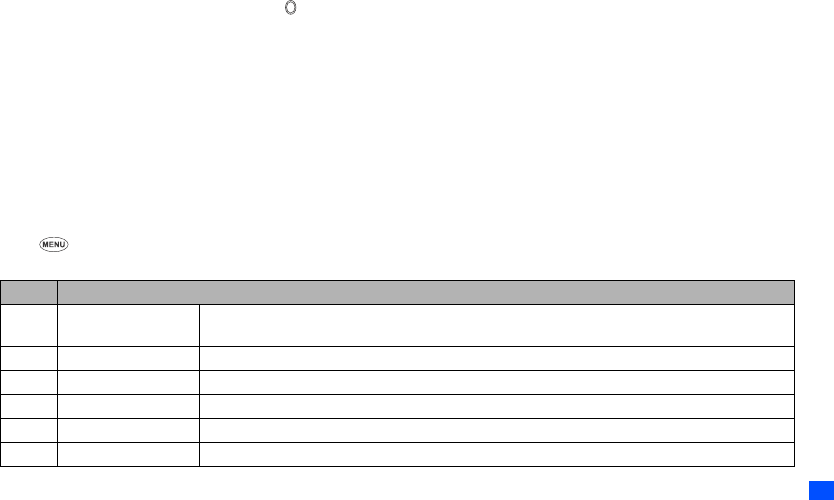
73
☛Key in the required date, month and year. Then, press Softkey 1.
Setting the Due date
☛Use the ▼ key to highlight the Due date field and press Softkey 2.
☛Key in the required date, month and year. Then, press Softkey 1.
Setting the Status Finished/Unfinished
☛Use the ▼ key to highlight the Finished/Unfinished field.
☛Press Softkey 2 to set the event status to Finished or Unfinished.
Description
☛Use the ▼ key to highlight the Description field, and press Softkey 2 to display the Enter ToDo text screen.
☛Key in a description for the ToDo task and press .
☛Press Softkey 1 to save the changes.
Viewing ToDo task details
☛Use the ▲ and ▼ keys to highlight the required ToDo task and press Softkey 1 to display the Details screen. The selected ToDo task’s Start
date, Due date, Status, and Description will be displayed.
2If there are no ToDo task listed, pressing Softkey 1 will display the ToDo editing screen.
•To view the details of the previous or next ToDo task in the list, use the ▲ and ▼ keys.
•To edit the currently displayed task, press Softkey 1.
ToDo Options menu
☛Use the ▲ and ▼ keys to highlight the required ToDo task.
Press . The ToDo options menu will be displayed.
☛Key in the appropriate key for the required option.
No. ToDo Options menu
1Add Adds a ToDo task based on the highlighted ToDo task (see the second step of Creating a ToDo task
on page 72).
2Edit Edits the highlighted ToDo task (see the second step of Creating a ToDo task on page 72).
3 Delete Deletes the highlighted ToDo task.
4 Delete all Deletes all the ToDo tasks.
5 Status Displays the number of unfinished and finished tasks and how many more tasks can be created.
6 Finished Changes the status of the selected ToDo task from finished to unfinished or vice versa.
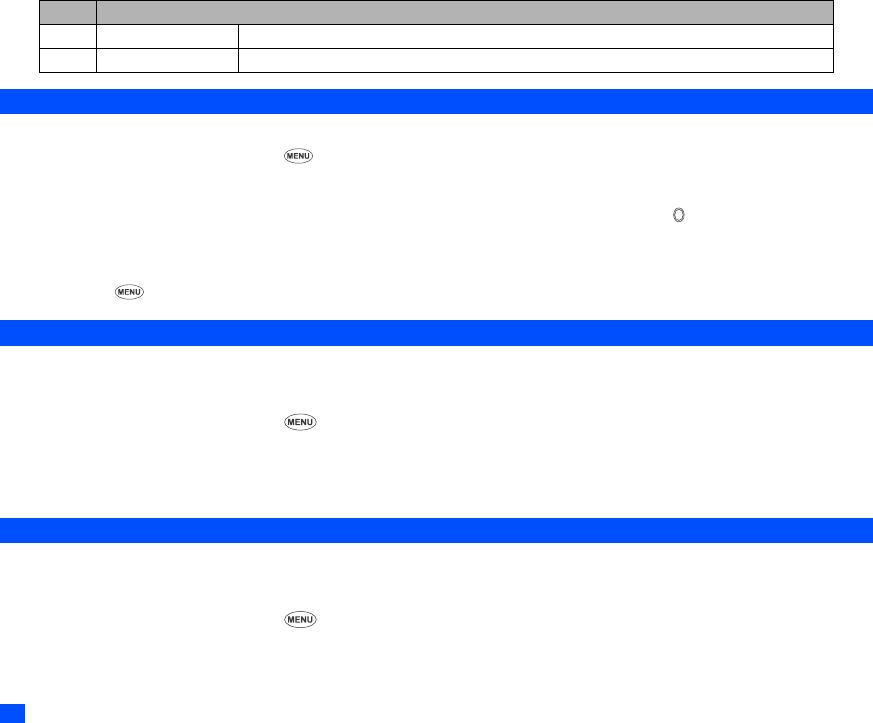
74
Notepad
Notepad function allows you to store simple text memos.
☛With the standby screen displayed, press 8 and 5 to display the Notepad screen before performing the following procedures.
Creating a new text file
☛Press 1 to display the Add new screen. Use the text entry procedures (see page 31) to key in text, and press .
The input file will be saved as a file. The first few words are displayed on the list of text files.
Notepad Options menu
☛Press 2 and to display the Notepad Options menu (see “File selector menu” from page 78).
Voice memo
Voice memo function allows you to record up to 60 seconds of sound/voice, using your phone’s microphone.
Recording Voice memo
☛With the standby screen displayed, press 8, 6 and 1 to display the New Record screen.
☛Press Softkey 1 to start recording. When the recording is completed, the Voice memo screen will be displayed.
2You can finish recording and save the data as a file by pressing Softkey 2 even before the recording is completed.
/For other functions of the Voice memo, see “Sounds” on page 77.
Currency converter
Currency converter function allows you to convert an amount of money in one currency to another.
Activating the Currency converter
☛With the standby screen displayed, press 8 and 7. The Currency screen will be displayed.
7 Delete finished Deletes all the finished ToDo tasks.
8 Display filter Sets the type(s) of ToDo tasks to be displayed by selecting the desired filter option.
No. ToDo Options menu (Continued)

75
Converting currency
☛Use the ▼ key to highlight the source currency code.
2Press and 1 to bring up the currency list. Then, use the ▲ and ▼ keys to highlight the required currency and press .
2You can change the source currency by using the and keys to scroll through the currency codes, too.
☛Use the ▼ key to highlight the destination currency code.
2Press and 1 to bring up the currency list. Then, use the ▲ and ▼ keys to highlight the required currency and press .
2You can change the destination currency by using the and keys to scroll through the currency codes, too.
☛Use the ▼ key to highlight the exchange rate.
☛Key in the required exchange rate (for decimal point, press ).
☛Use the ▼ key to highlight the money field.
☛Key in the amount of money you wish to convert (for decimal point, press ) and press Softkey 1.
The result will be shown in the result field, and the current settings will be stored.
2If you have made a mistake in entering the amount, use CLR to delete individual number or press Softkey 2 to clear the entire amount, then start
again.
Resetting the currencies
☛With the source currency code or the destination currency code field highlighted, press and 2 to reset all the currencies to their initial values.
▼
▼
▼
▼
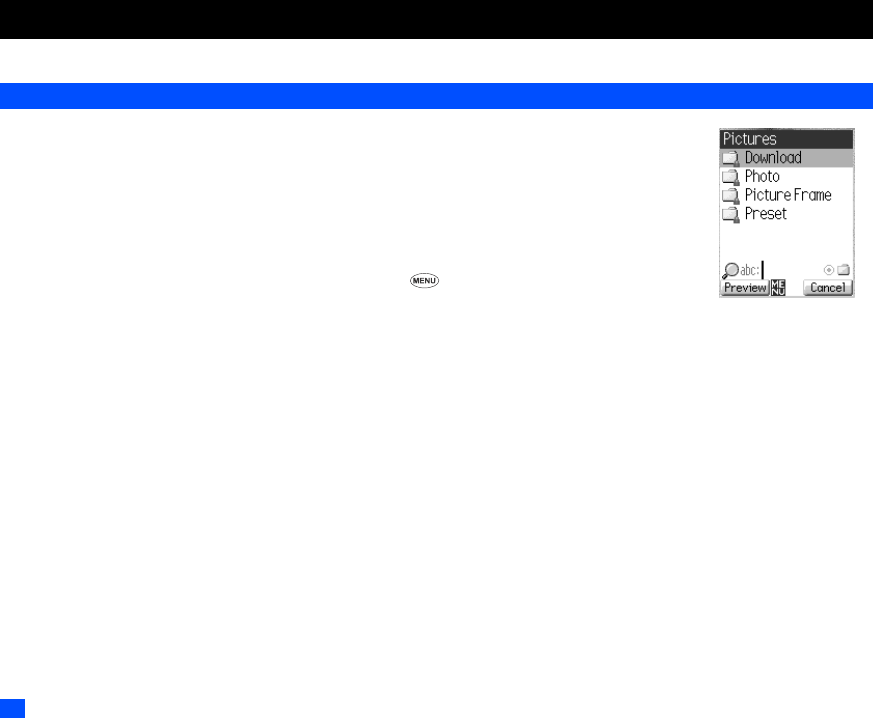
76
My data
Using My data, you can playback sounds, or display pictures downloaded from Internet or captured with the Camera function on your phone.
Pictures
In the following section, the Picture functions are described. The Picture function allows you to display and edit images
and animations obtained with the camera function of your phone or downloaded from Internet. The Picture function also
allows you to attach images and animations to mail/MMS you compose. The Picture function is activated by selecting
Pictures in My data screen or selecting Pictures in Option menu screen using camera function.
Displaying the Pictures list screen
☛With the standby screen displayed, press the ▼ key and 1 to display the Pictures folder top screen before
performing the following procedures.
2You can also access the Pictures folder top screen by pressing 6 and 1.
2When the Flat view function is activated, the Pictures folder top screen is not displayed. The list of all the stored
image file is displayed.
Download
☛With the Pictures folder top screen displayed, use the ▲ and ▼ keys to highlight Download, then press the key. The Download picture list
screen will be displayed.
Photo
☛With the Pictures folder top screen displayed, use the ▲ and ▼ keys to highlight Photo, then press the key. The photo list screen will be
displayed. For details on the Camera features, see “Camera Function” on page 45.
Picture Frame
☛With the Pictures folder top screen displayed, use the ▲ and ▼ keys to highlight Picture Frame, then press the key. The Picture Frame list
screen will be displayed.
Preset
☛With the Pictures folder top screen displayed, use the ▲ and ▼ keys to highlight Preset, then press the key. The Preset picture list screen will
be displayed.
2If you wish to move to another hierarchy in the highlighted folder, use the and keys.
Pictures folder top screen
▼
▼
▼
▼
▼
▼
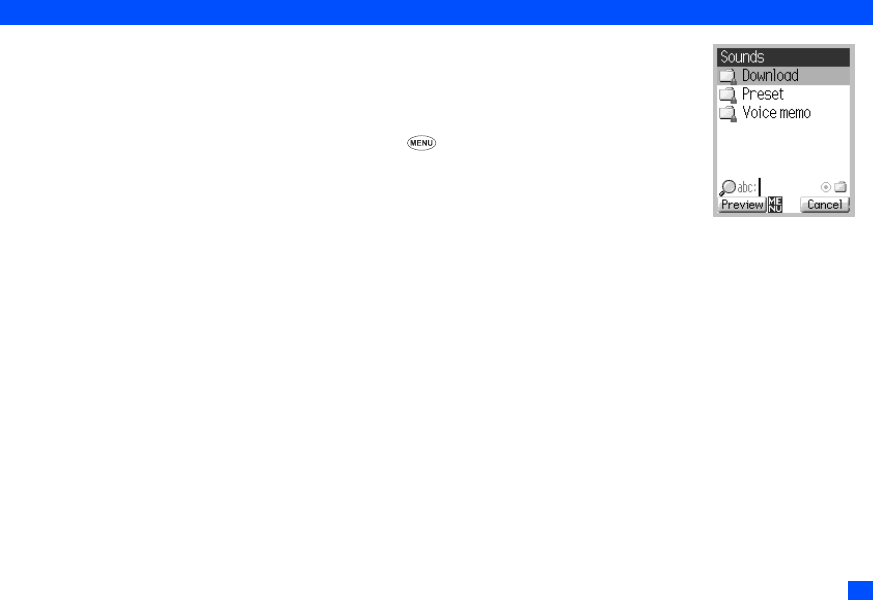
77
Displaying the Pictures view screen
☛Use the ▲ and ▼ keys to highlight an image file you wish to display and press Softkey 1. The image of the currently highlighted image file will
be displayed.
2When a folder is highlighted, you cannot use Softkey 1.
☛Press the ▲ key to display the previous image file or press the ▼ key to display the next image file.
Sounds
In the following section, how to playback and delete desired sound items is described.
Displaying the Sounds list screen
☛With the standby screen displayed, press the ▼ key and 2 to display the Sounds folder top screen before
performing the following procedures.
2You can also access the Sounds folder top screen by pressing 6 and 2.
2When the Flat view function is activated, the Sounds folder top screen is not displayed. The list of all the stored
sounds files is displayed.
Download
☛With the Sounds folder top screen displayed, use the ▲ and ▼ keys to highlight Download, then press the key.
The Download sound list screen will be displayed.
Preset
☛With the Sounds folder top screen displayed, use the ▲ and ▼ keys to highlight Preset, then press the key. The Preset sound list screen will
be displayed.
Voice memo
☛With the Sounds folder top screen displayed, use the ▲ and ▼ keys to highlight Voice memo, then press the key. The Voice memo list screen
will be displayed.
2If you wish to move to another hierarchy in the highlighted folder, use the and keys.
Selecting and playing sound
☛With the Sounds list screen displayed, use the ▲ and ▼ keys to highlight the sound you want to play. Then press Softkey 1 to play the currently
highlighted sound.
2When a folder is highlighted, you cannot use Softkey 1.
Starting and stopping
☛Press Softkey 2 to stop playing the currently highlighted sound. If you wish to play it again, press Softkey 1 to restart playing the sound.
Sounds folder top screen
▼
▼
▼
▼
▼
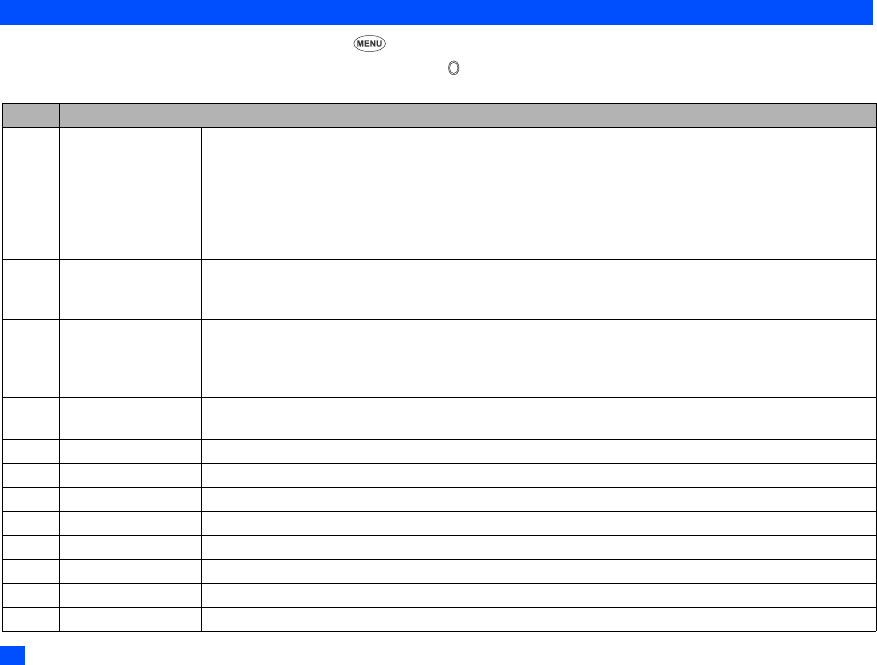
78
Adjusting the playback volume
☛Use the Side keys to adjust volume.
File selector menu
☛With the Pictures/Sounds list screen displayed, press .
☛Use the ▲ and ▼ keys to highlight the required menu item and press .
File Selector Options menu
No. File Selector Options menu
1Edit item Enables to change the protection settings of the selected image file, or cut, reduce, rotate that image, or set the
frame to it.
Change protection: Enables to change the protection settings of the selected file.
Cut: Enables to cut the selected image.
Reduce: Enables to reduce the selected image.
Rotate: Enables to rotate the selected image.
Frame synthesis: Enables to set the desired frame to the selected image.
2 Use item (Picture) Enables to utilize the selected file by attaching to mail/MMS or setting as wallpaper.
Create message: Attaches the selected file to mail/MMS (see page 55).
Set as wallpaper: Sets the selected image to be wallpaper.
2 Use item (Sound) Enables to utilize the selected file by attaching to mail/MMS or setting as ringer tone or message tone.
Create message: Attaches the selected file to mail/MMS (see page 55).
Set as ringtone: Sets the selected sound to be ringer tone.
Set as message tone: Sets the selected sound to be message tone.
2 Use item (Notepad) Enables to utilize the selected file by attaching to SMS/mail/MMS.
Create message: Attaches the selected file to SMS/mail/MMS (see page 36 and page 55).
3 Delete item Deletes the selected image file and folder.
4 Delete all Deletes all the image files in the current folder. (Sub folders are not deleted.)
5 Rename item Enables to edit the file name of the selected image file.
6 Copy item Copies the selected image file.
7 Move item Moves the selected image file.
8Move all Moves all the image files in the current folder. (Sub folders are not deleted.)
9 Create folder Creates a new folder under the current folder.
0 Storage detail Displays the current storage information of your phone memory.
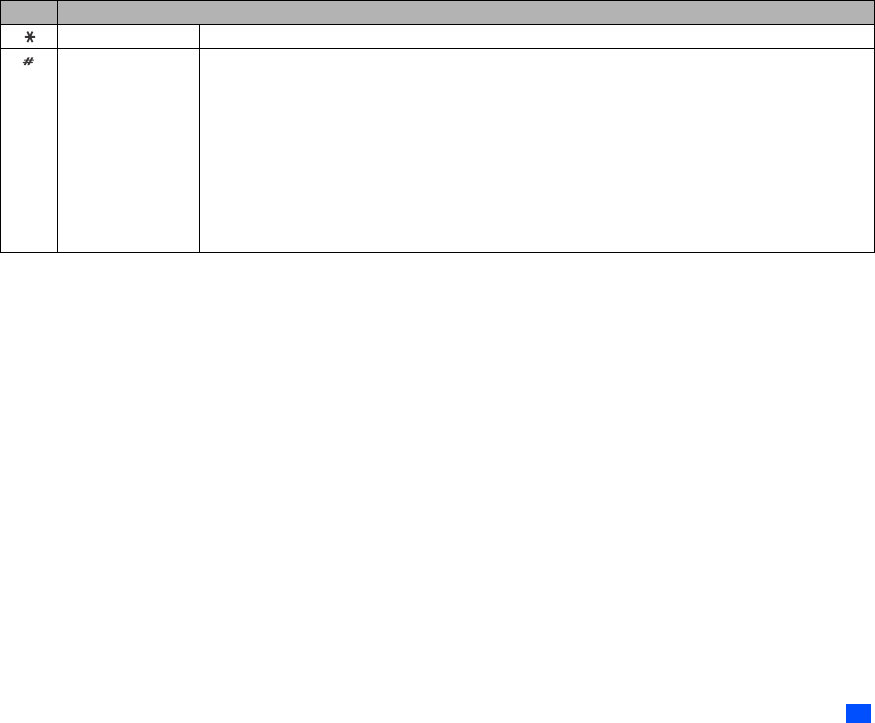
79
2Depending on the conditions, the menu number and available options may vary.
2Depending on the conditions, some options may be displayed in gray and not be available.
View detail Displays the detail of the selected image file.
Options Sorting order: Sorts the image files alphabetically.
Info column: Sets whether to display the second column on the list screen, and what information shall be
shown there if it is displayed.
None: Displays no Info column.
Size: Displays the size for each file (rounded to the nearest kilobyte) in the info column.
Type: Displays the file extension for each file (only for those of which the file type is
recognizable) in the info column.
Flat view: Enables to display the list of all the stored image files regardless of the folder hierarchy.
Sound titles: Enables to display the titles of sound files.
Save options: Saves the current Options settings.
Reset options: Resets the Options settings.
No. File Selector Options menu (Continued)
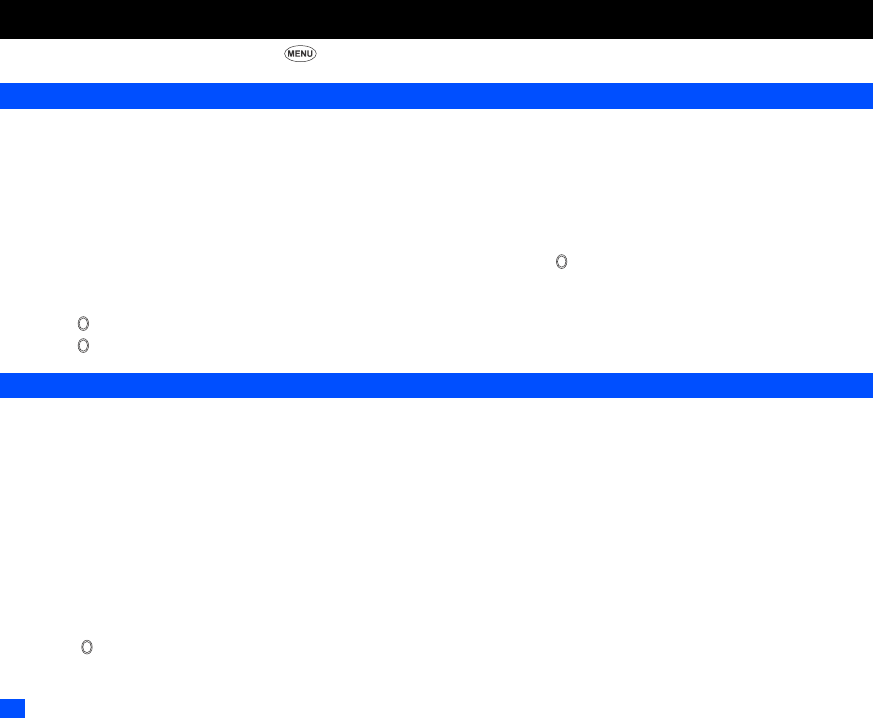
80
Game
☛With the standby screen displayed, press and 7 to display the Game screen.
Poker
Game concept
This is a one-person Poker game. You have one chance to change the cards.
How to play
☛With the Game screen displayed, press 1 to access the Poker game. “How to guide” screen will be displayed.
☛Press Softkey 1 to start the game.
☛5 cards are face down on the screen. Enter the bet using the ▲ and ▼ keys, then press . The cards will be turned over to face up.
☛Select the card(s) you wish to keep by pressing the appropriate number keys (1 to 5). The selected card(s) will be held. If you press the same key
again, the card will be released.
☛Press . The cards you have not selected will be dealt again. Then, you can get result.
☛Press to start the game again once the game is over.
Belt
Game concept
You are a luggage loader and are loading parcels into trucks. The parcels are colour coded to be the same colour as the truck they must be loaded into.
In between the parcels and their respective trucks are a series of conveyor belts which can move right. You must switch the conveyor belts’ direction to
guide the luggage to the appropriate truck. Each parcel you direct correctly will score 1 point. When 4 parcels miss their respective truck, the game is over.
When you load 100 parcels correctly you will go on to the next level.
How to play
☛With the Game screen displayed, press 2 to access the Belt game. “How to guide” screen will be displayed.
☛Press Softkey 1 to start the game.
Each conveyor belt has a key symbol under it. The direction of the conveyor belt (indicated by arrows at each end) will be reversed by pressing
the appropriate key. Belts 1 & 3 and 7 & 9 are linked as pairs, so that pressing either key will change the direction of both belts.
☛Press to start the game again once a game is over.

81
Clover
Game concept
This is a puzzle to form four-leaf clovers by rotating any set of four leaves. Successful formation of each four-leaf clover will score points and extend a
given time limit. If you successfully form four-leaf clovers continuously, you can get higher points and longer extension of time.
How to play
☛With the Game screen displayed, press 3 to access the Clover game. “How to guide” screen will be displayed.
☛Press Softkey 1 to start the game.
You can move the cursor around and select any set of four leaves by pressing the ▲ ▼ and keys.
☛Rotate the selected leaves by pressing Softkey 1 (counterclockwise) or Softkey 2 (clockwise). A set of leaves disappear once they form a four-
leaf clover, and will be replaced with another set of leaves. When the time expires, the game is over.
☛Press to start the game again once the game is over.
▼
▼
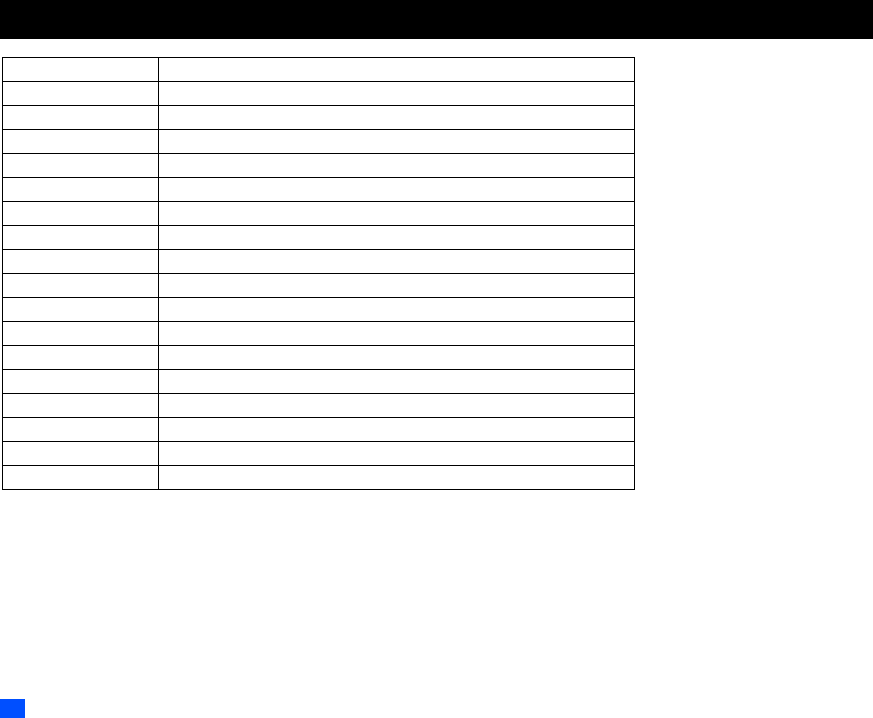
82
Abbreviations
ADN Abbreviated Dialling Numbers
ALS Alternate Line Service
AoC Advice of Charge
CLI Calling Line Identification
FDN Fixed Dialling Numbers
GPRS General Packet Radio Service
GSM Global System for Mobile communications
JPEG Joint Photographic Expert Group
LCD Liquid Crystal Display
MFi Melody File for i-mode
MMS Multimedia Message Service
PIM Personal Information Manager
PIN Personal Identification Number
PUK Personal Unlocking Key
SDN Service Dialling Numbers
SIM Subscriber Identity Module
SMIL Synchronized Multimedia Integration Language
SMS Short Message Service

83
Index
Numerics
4 way navigation key vi
A
AC adapter 2
Accepting a call 6
Accessory 67
Adjusting the earpiece volume 15
ADN 23
ALS setup 19
Any key answer 18
Auto answer 17
Auto redial 12
B
Bar calls 35
Basic calls & phone use 6
Battery changing 5
Battery icon 4
Battery level indicator viii
Battery pack 5
Attaching 5
Removing 5
Bookmark 53
Broadcast messages 44
C
Calculator 67
Call diversion 10
Call lists 9
Call waiting and holding 11
Camera 45
Taking pictures 46
Changing the battery 5
Changing the PINs 33
Charge information 10
Clock 19
Clock alarm 69
Colour style 21
Correcting mistakes 6
Currency converter 74
D
Date, time 19
Dialled calls 9
Direction 22
Downloading 48
E
Earpiece volume 15
Emergency calls 7
Ending calls 6
F
FDN 24
Fixed clock 21
Fold answer 18
G
General care i
Greetings 20
I
icons viii
i-mode facilities 48
i-mode menu 52
Inbox 36
Incoming call No. 21
International calls 12
International dialling codes 12
K
Key allocations 32
Key tone 17
Keypad shortcuts vii
L
Language setting 20, 44
Last call duration 9
Last number redial 7
LCD viii
Line identification 12
Low battery alarm 4
M
Main menu 14
Making basic calls 6
Menu functions ix
Menu shortcuts selection 14
Message 36
Message(Msg) tone 17
Message(Msg) tone volume 17
Missed calls 9
Mode settings 16
Multi-party calls 8
Mute 9
My data 76
N
Network selection 13
Normal text input (ABC) 32
Notepad 74
Numeric input 32
O
One-touch dial 8
Own phone number display 8
P
Parts and functions vi
Phone lock 34
Phone mode 15
Phonebooks 23
Photo 76
PIN activate 34
PIN code 33
PIN2 code 33
Power saving 22
Preparing the phone 1
Putting a call on hold 7
R
Reading messages 37
Received calls 9
Redial blacklist 10
Redial the last number 7
Rejecting a call 7
Reset settings 22
Ring silencer 18
Ringer 16
Ringer volume 16
Roaming 13
S
Safety precautions i

84
Scheduler 70
Scratchpad number 30
SDN 24
Security 33
Security code 34
Service tone 17
Setting date format 20
Setting the date 19
Setting the time 19
Setting time format 20
Setting timezone 20
Setting up your phone 15
Shortcuts selection 14
Side keys 18
SIM card 1
SIM card insertion 2
SIM card removal 2
Standard messages 36
Standby screen display ix
Standby talk times 4
Starting a call 6
Start-up 3
Switching the phone off 3
Switching the phone on 3
T
T9 English text input 31
Talk time 4
Text entry 31
Time & date 19
ToDo list 72
Total calls duration 9
U
Unsuccessful calls 7
User guide conventions iv
V
Vibrator 17
Voice memo 74
Voice recall 8
Volume
Earpiece volume 15
Message(Msg) tone volume 17
Ringer volume 16
W
Wallpaper 21

